

ART H A B E N S
Fred L’Epee France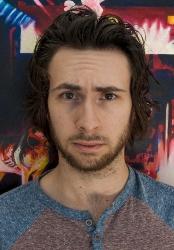
The visual codes of my projects interplay to destabilise the balance, and to balance the imbalance. From a philosophical, anthropological and psychological point of view, my work is based on the body, time and its environment. Human beings and transhumance. The microcosmic vision of a postmodern-society. Based under a process of temporality and timelessness. Where each elements are almost in shamanist relation with the subject. There, where the evolution of human being has others definitions and others laws of what is existence and non-existence.
Obviously, the interaction and connectivity worked in my films increase the flow and the potentiality of a formal structure. And obviously, the creative freedom worked in my films is linked to the instinct. These are two different ways to design, and they can lead yourself in a different result. But somehow, you don’t choose.
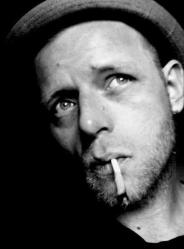

This is the form of the project and your ideas who choose the structure of what could be the right balance. That's the paradox of freedom.
Morisawa Japan / USA Parisa Taghipour Iran
Wood is an important component in my art. The life of a tree and the energy in each grain of wood are why I use wood. My artwork is hand-made of thousands of very small slices of natural and oildyed (wood) chips on board. I like to incorporate the patterns in the wood and enhance them with oilstain. The variety of wood grain is very beautiful and the pattern is never the same. The combinations of natural and oil-stained grains create interesting shadows and impressions. My imagery comes from common items: a cupcake, shoes, a wave, and waterfalls etc. when seen from a distance, my artwork looks like a painting. The details of the work and mosaic technique slowly emerge when the viewer comes closer. Look closely and see the vibrancy and movements of the wood patterns. By using wood mosaic I can show the life and energy. I can talk about life and the energetic atoms inside the shoes, wave or waterfalls with my tiny wood slices. I make art that is natural, playful and lifts people’s spirits. But I also want my artwork to be about myself, like a diary. Each piece is created with the care one would use writing a letter to a loved one or friend. Bright, fun, and unusual subjects attract and inspire me to work in new directions. Mysterious creatures/objects such as magic mushroom and jellyfish, gravity, Illusions and Waves are recurring themes in my work.
Cactus.... Not only cactus but my goddesses, my cacti are my goddesses which are actually the me, I am a goddess, just in the form of a cactus; it is a concentration of unmergeable contradictions. Being stubborn but naive, beauty and violence, coy and coquette, thorn and a flower, thirst and blooming, drouth and birth… and full of love, as I am as a woman. My cacti have roots long as the history and the expanse of time. It sometimes includes and the devours me, some other time I do unto them, I am wondering about their being and they sometime bite throats and cut the necks. It is and was difficult to be a woman and not to break free astray as a woman of the times where they cut the roots. I dance and live and I brag, but… I should, stay over there a bit more far, since I’m a cactus. Beautiful and kind but I would be having thorns as strong as life. The mother nature lives inside my body and I am the goddess of love. My roots infiltrate the boundaries, borders and my rebellious soul will conquer the hearts in the way of love. I am a cactus, a woman, a goddess… I am a human, lost in the history or free in time… I am a woman, not limited to my femininity. The cactus is not only my goddess, but my goddesses are my cacti, which in fact I am too, I am a goddess and of course a cactus.
Charlene Shih Taiwan / USAMy early works of painting, installation, animation, and video have all related to the role of me being a female Asian artist. They cannot be separated from the Chinese painting and calligraphy that I was nurtured with since birth. The works are a constant struggle between east and west; desire and morality, and the process of finding my own identity. At age 28, I finished the experimental film “Women”, an animated film that was done completely using ink on rice paper. It includes all of the concepts and ideas I expressed in my previous works. “Women” was a milestone for me. After completing “Women”, I could relinquish the feminist topics and Chinese painting and calligraphy obsessions I had explored . It has been over a decade since “Women” was completed. Since then, my focus has switched to family, friends, and controversial topics in the society. But even after a decade, I realized that women’s roles have not changed much. The style of Chinese paintings and calligraphy have not altered either as we walk into a new century. After trying to break all the rules, my role is still identified as a female director, a daughter, a wife. It doesn’t matter how hard I struggle, in the end I am just like all the other women, put back into a small box that everyone can identify with and agree upon. My work continues to struggle against the rules and lingering the tradition.

Jacqueline van de Geer Canada


Jacqueline van de Geer is a Montreal-based artist working primarily in performance.


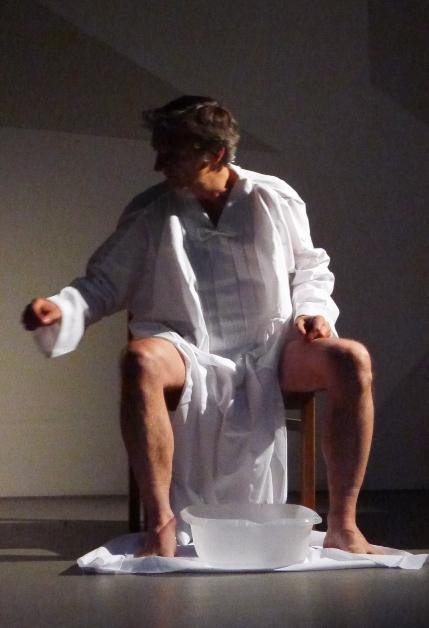

Hailing from the Netherlands, where she studied visual and performance art, her current practice is inspired by literature, mythology, history and personal memory. Since her arrival to Montreal in 2005, her performative actions have combined object theatre, devised theatre, dance and integrated arts. Collective creation is an important part of her practice, and this philosophy informs her work both with fellow artistic collaborators as well as with her audiences. As such, developing strong connections with viewers is elemental: her performances offer many the opportunity to become active participants, with these spontaneous exchanges becoming an integral part of her pieces. Intimacy and surprise then surface as key components in her work, facets that irresistibly draw her audiences in. Mixing performance art with experimental theatre, and always working intuitively, her non-linear storytelling is infused with dark humour, absurdity and irony. Slipping seamlessly between these varying modes, the result is an evocative hybrid form coming from a uniquely refreshing voice.
Various cosmological observations strongly suggest that there should be much more matter in the universe then can be seen directly, and that we are surrounded, dominated by dark matter. However, dark matter has yet to be detected directly making it one of the greatest mysteries in modern memory. With this concept in mind my print work is an attempt to imagine the possibilities of what forms dark matter or other mysterious scientific notions could take, whether it be landscapes, objects or entities. This has lead to experimenting with different materials in abstract forms and photographing them in a foreign environment, a tank filled with water in a dark room with minimal spot lighting. From there I began editing and merging these images to create new forms and spaces. The attempt is to bring a balance of observed and empirical depictions that fall and/or merge into imagined realms and forms, challenging the scale , purpose, nature of the objects and environments. The utilization of photography and drawing can achieve this as photographs in scientific practice are needed to depict objective representations, and drawing which filters an artist's subjective perception into the creation of an image. The use of photo-intaglio processes can reduce the clarity of a photograph to further the images mysterious nature.
Some time ago I heard the comment, “It’s easy to be a photographic artist, you only have to take one great image but a cinematographer has to take 24 great images every second.” This led me to take a different view of the individual frames that make up a moving image, each one seen for less than a fiftieth of a second.
Over thirty years as a film editor I saw countdown leaders constantly and repeatedly. The countdown leader, which an audience rarely if ever saw, is the section of film that precedes the actual on-air content.
For me the film leader was always the precursor of something wonderful appearing on screen, either something I had helped create or another person’s vision. With change to digital recording and replay there is no need for a countdown leader. The images in this series are printed on canvas as a way to replicate, as much as possible, the pathway of films viewed in the cinema a few decades ago.
First the image was captured by the reaction of chemicals to light, on a strip of film. The chemical structure changed and the minute crystals formed created colour and texture.
When the negative film was printed, again by a photo-chemical reaction, onto a positive print film there was additional texture. The image, with all this texture, is projected onto a large canvas screen. This screen also has texture from the warp and weft of the fabric. These intrinsic visual textures bring an extra layer of life and motion to film.
Charlene Shih
Anzai creates strange machines by composing common plastic articles and chairs, exploring the relationships between humans and objects. After being connected to a motor, they begin to move in amazing ways. Anzai's installations are made up of combinations of these machines and video works that use machines as a motif. Anzai has created a system that lets others mediate his works. For instance, Anzai has exhibited machines that the audience made by interpreting his instructions. Such a process creates a distance between the artist and his work consequently leaving it out of his control.
Anzai's work expresses nothing less than the state of relationship between a changing world and people. Anzai received his master of film and new media degree from Tokyo University of the Arts in 2011. Anzai is the recipient of RBS Bursary Award 2015 from Royal British Society of Sculptor.
Anzai has participated in artist residencies at the Museum of the Fine Arts Houston, Kawasaki City Museum, and the National Art Studio, Korea. His solo exhibitions include Reinventing the Real (2015), Biyong Point, Akita, Japan; and Origins Originated from Originative Originals (2014), Chimera-Project, Budapest, Hungary.
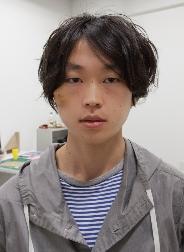
Naoko Morisawa
Jacqueline van de Geer
Fred L’Epee
Mahsa Merci Iran
One of my main concerns was sexuality differences between men and women. Because I’m living in a country with patriarchy social system, this subject was a very important issue for me and I wanted to show these paradoxes in my art. Showing violence and rage and in a very expressive way is so clear in my artworks. always shock, paradox and violence are the main aspects in my artworks. The same thing was reflecting in my sculptures .I also love to use mix media so I have tried making some sculptures with bones and yet again the violence is so bold in my artworks. On a general note, I can sum up the idea behind my works as sexuality and the determinative lines between the sexes. I believe everything is consisted of spectra. Similarly, the two sexes are on the two extremes of a spectrum. It is this spectrum that makes for sexual or behavioral violence. I think these whims can appear simultaneously, because of the mixed nature of the male/female properties. So I see this subject as an observer and then begin to make my work: without judging.
Parisa Taghipour
Ken Clark

Ryan Andrade

Mahsa Merci
Tsuyoshi Anzai
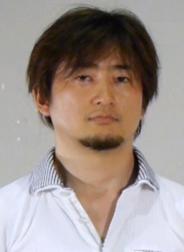
Special thanks to: Charlotte Seegers, Martin Gantman, Krzysztof Kaczmar, Tracey Snelling, Nicolas Vionnet, Genevieve Favre Petroff, Christopher Marsh, Adam Popli, Marilyn Wylder, Marya Vyrra, Gemma Pepper, Maria Osuna, Hannah Hiaseen and Scarlett Bowman, Yelena York Tonoyan, Edgar Askelovic, Kelsey Sheaffer and Robert Gschwantner.


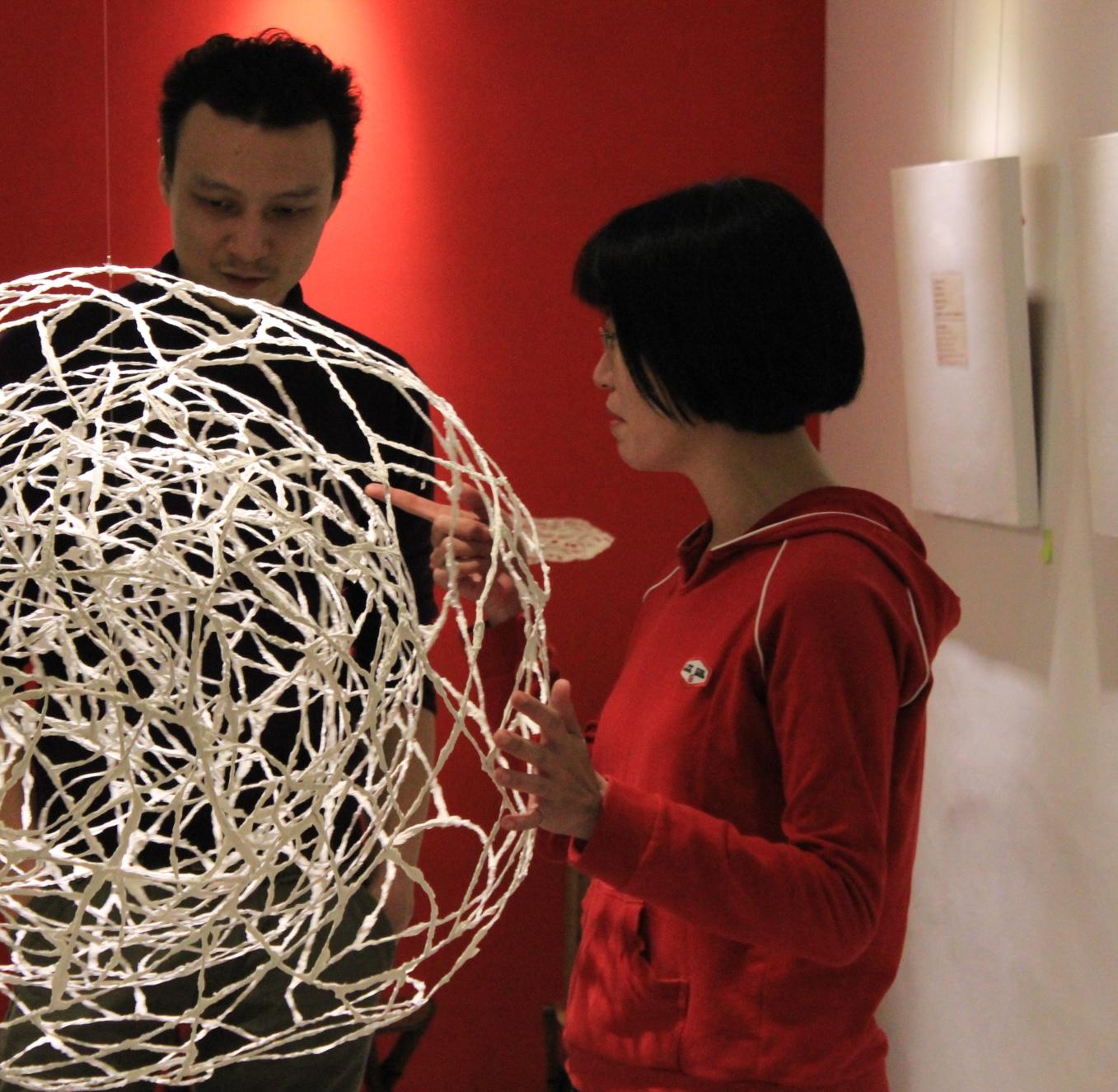
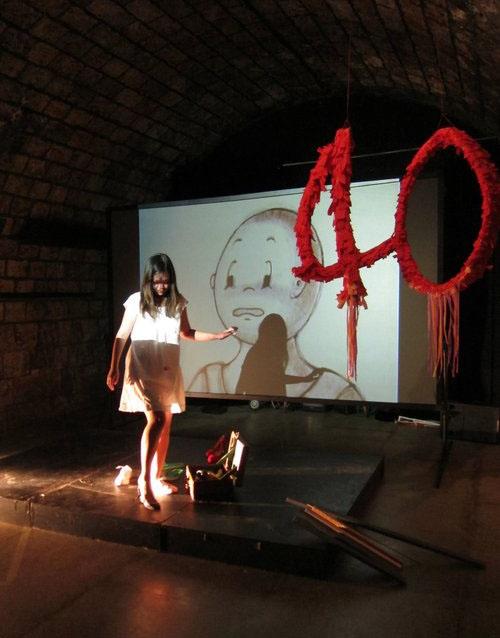

I grew up in a pretty conservative family in Taiwan, with my mother being a traditional Chinese painter and calligrapher. I had a very classical art training growing up. I knew how to hold a paintbrush before I could hold a pen and my childhood memories were more of practicing hundreds of pages of calligraphy on rice paper, rather than playing with next-door neighbors. So ink and rice paper have always been big part of my work, and it’s a love-hate relationship. I came to the United States when I was 19, and going to Otis College of Arts and Design in Los Angeles was quite a shocking experience, both in art and in my personal life. In the early 90’s, the west coast’s art scene in the U.S. was dominated by conceptual art; everything had to have “meaning” behind it. I was confused and excited at the same time. In many ways I felt liberated both mentally and physically, so in my earlier work, everything revolved around my identity - what it meant to be a female Asian artist, the struggle between desire and morality, between Western and Eastern culture, and even the choice between different art mediums. I practiced different mediums from painting, sculpture and installation to express myself. I was young and had so much that I wanted to say, so it just seemed very natural that eventually I chose video as my main medium, which led me to CalArts’s graduate program in experimental animation, and that opened up many new doors in terms of my artistic career. For the
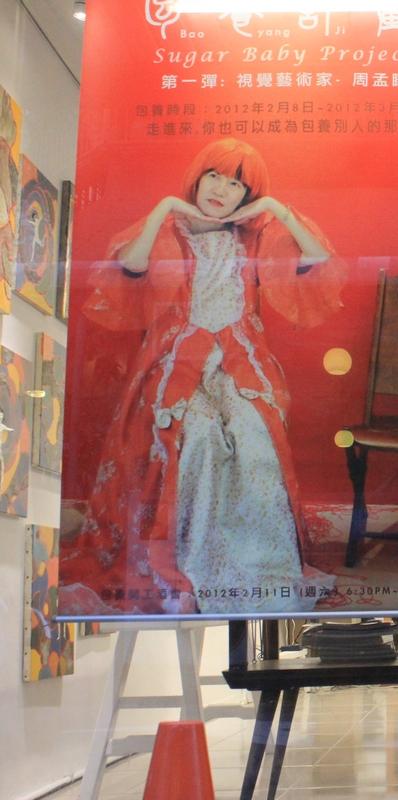
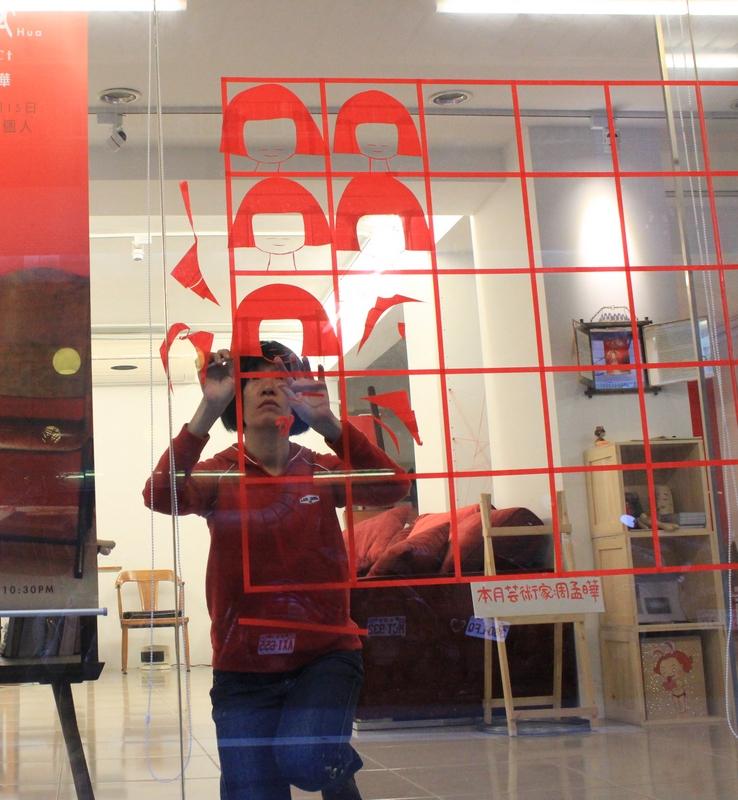

next 20 years, my main focus was in film and video. I did animation, experimental films, video installations and many documentary films. However, the biggest reasons I went into video and film was because it was a little easier to make a living, it was easier to “store” my work, and it allowed me to travel.
Not until the end of 2015, after I became the executive producer producing six episodes documentary series for National Geographic Channel, did I decide to take a break from video and film. I wanted to focus on painting and installations. This also had something to do with my personal life as well, after traveling more than 10 years making documentary films; I decided to settle back in Los Angles.
Whether it’s video or paint or installations, to me it’s still just different mediums.
If you look at my website, you probably will notice that I do everything, and I actually have a hard time to telling people what I do, because I love all mediums, and I try not to follow trends. So now, I just say I am a visual artist. I choose different mediums depending on when and where I am at in life.
Like many artists, my work usually starts with my personal experiences, and kind of expands to family and friends around me, then to social issues and injustice. For
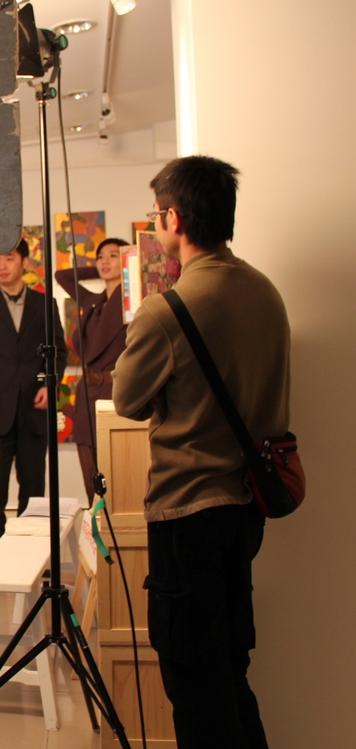
example my animated film “Women” was based on a series of my paintings and installations, about a modern Asian girl and her journey from adolescence to selfdiscovery. So that process from one painting, to installations to finishing a film, was a self-discovery journey for myself, and of course it took years.
I like labor-intensive work. I also value the process more than the results, so I try to experiment in different ways to achieve the idea I want to convey, and hopefully the viewers can not only follow my journey, but also start to ask questions and create a dialogue. The central idea among most of my projects are related to my own identity – a woman.
myself as a woman, and it has always been a central idea in my work.
Once I started to dealt with my own sexuality and identity, it certainty raised more interest about females in other parts of the world; the different roles that women are playing, the challenges and obstacles they are facing, and the burdens and potentials that we all might carry. These are all the questions I ask through my artwork. So my earliest works “Worship”, “Take Me Home”, “Women”, “Treasure Island” and even the “Sugar Baby Project” are all about women in the modern world.
Being an Asian female artist definitely has been an important part of my artwork. My mother is an artist, and a very dedicated one. She did not have the freedom and choices when she was young, she had to work full time, raise a family, support her siblings, and take care of her parents as well as my father’s parents, which left her very little time to work on her art. I think her experience reflects the female roles in her generation in Taiwan, and it had a big impact on me and my art.
From just being aware of my own body and my sexuality, to talking about sex, to women’ s rights and choices in life, these are things that weren’t the most popular topics growing up, so I knew very little about myself until I came to the United States. Since then, I started to really study
“The Sugar Baby Project” is a very ambitious project, which I have been thinking about doing for years, and I like to say it is still an on going project. As an artist, I know many of my peers, including myself have always struggled financially, and what artists do to make a living has always been a mystery, because we all know only a handful of artists can survive by selling their artwork. Back in 2005 when I was doing an artist residency at 18 th Street Artists Complex in Santa Monica, I made a video installation called “12 Steps to Success for Artists in Los Angeles”. I interviewed many artists in different fields: painters, actors, dancers, musicians, writers and asked them different questions
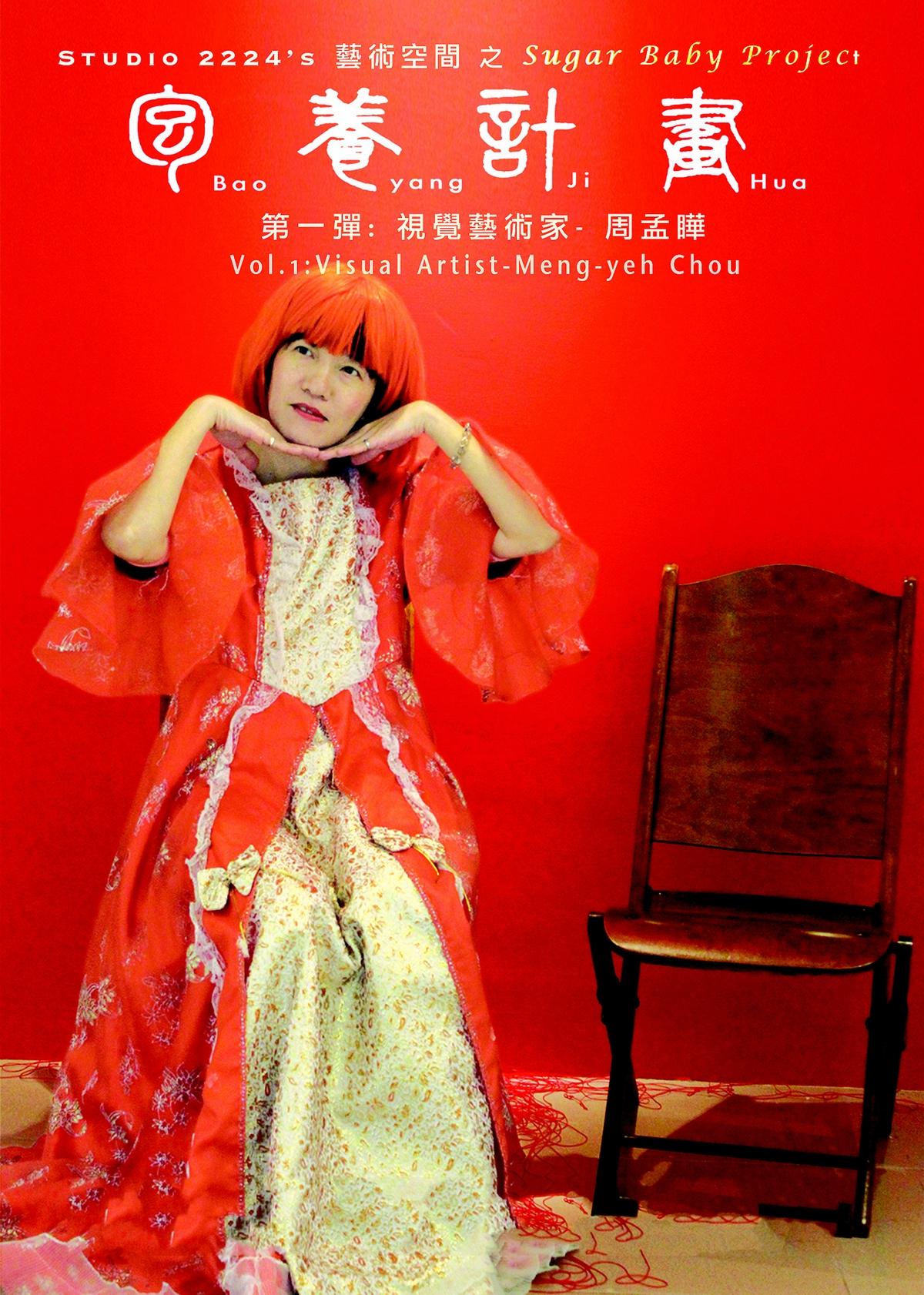
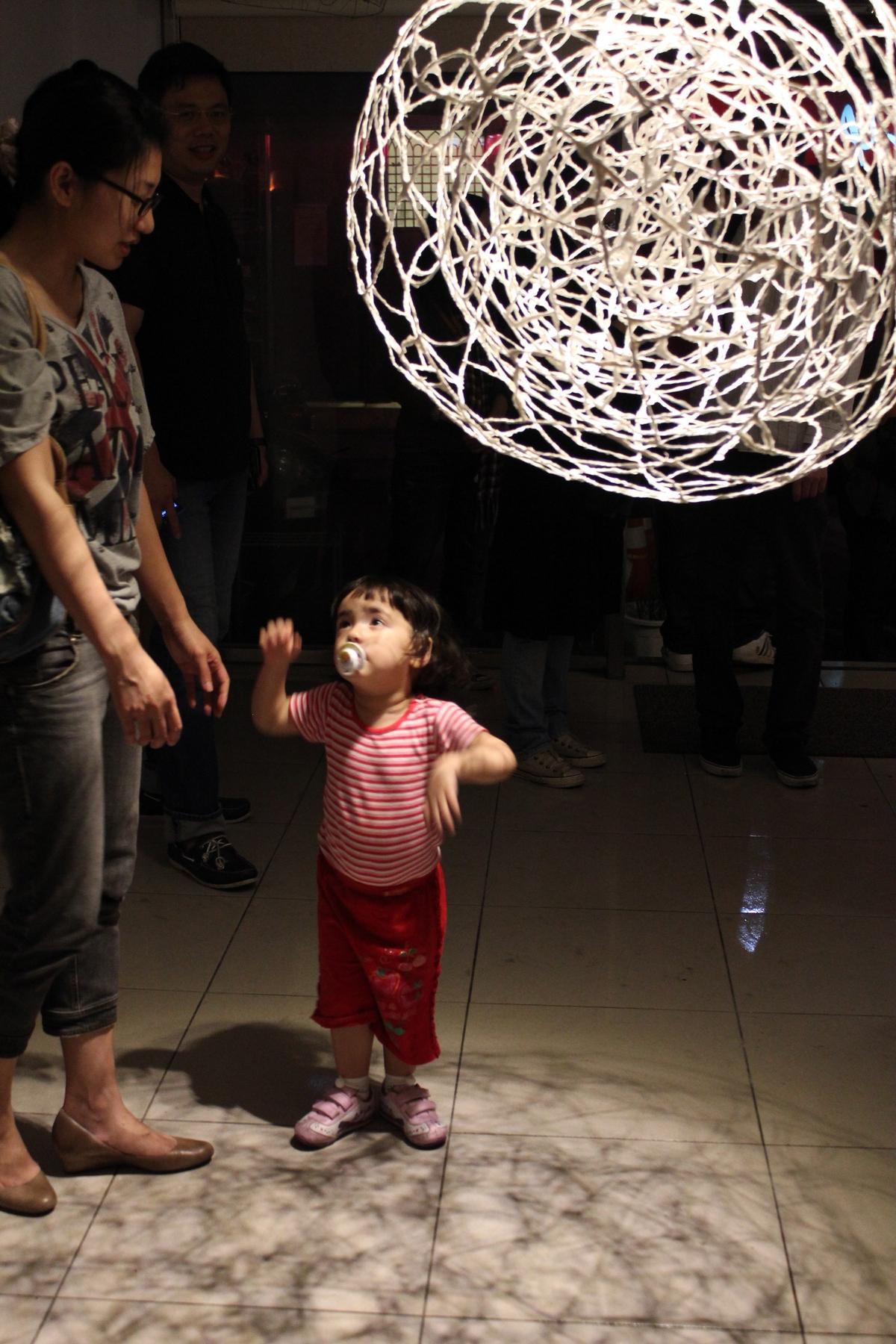
about what they do as artists, what they have achieved, what success meant to them, and what they do for living. In the end, I came up with 12 steps to success for artists in LA, but this also applies to artists anywhere.
So back to the “Sugar Baby Project”, obviously these same questions were not solved after 10 years of my artistic career, because ten years later, I was still juggling between making commercial films and my art, and I saw many of my artist friends still facing the same financial predicament, especially women artists.
In 2012, my husband and I started an alternative art space called Studio 2224 in Taipei. Once we had our own space; I thought I could invite my “starving artists” girl friends to work and have shows there, meanwhile I could get to know their work, and make a project to “sell them”. So it’s a project within a project.
I invited a good artist friend of mine MengYeh Chou to work at the studio for 3 weeks, so we could both work together in the space. She used the space to work on her art, and I worked on “her”. This whole process is what I called the “Sugar Baby Project”.
In a capitalist world, everything is about materials, money and power. In the madness of the media of our world, there are commercials everywhere telling us what is the newest trend, what to buy, what to believe, and in the end the media ends up controlling people. So if the media has so much power, can I make a commercial to promote and sell an emerging artist? Can a 40-year-old female artist still find a “sugar daddy” - in other words, a patron of the arts? "Sugar Baby Project" is a project where I collaborate with female artists from different fields to "study" and "package"
them, and eventually make a “Commercial” for them. My goal is to market and sell them and their artwork. Using a comical and exaggerated style, the video will raise questions in the modern society:
• Who holds the power between consumer and media?
• What is art, and how much should they worth for average audience?
• In the end, where is the line drawn between art and cheesy commercials?
This is a very tough question, because I did spend a great deal of my life focusing on film and video, and the longer I was in the field, the more projects I would get, and most of them were commercial projects with tight deadlines, so eventually I got burned out. I got so burned out, that sometimes I felt that my work was like watered down coffee, and it had no taste. This made me realize that it was time for me to abandon this medium...at least for a while.
I remembered when I first came to LA at a life drawing class; one of my instructors gave me great advice that I still practice this day. At the time, because I knew I was good at life drawing I always used the same method to make my work “pretty”, and it was extremely difficult for me to
“think outside of the box” and try different lines or brush strokes. After a few attempts and failing at “thinking outside the box”, he suggested me not to “draw” when I work on a drawing, and don't pick up a pen or brush for a year. That year I made a tremendous progress in my art. So I wouldn’t say I have completely abandoned video and film right now, but rather I am working on my films without a camera.
I did several international artist residencies through out the years, and almost every time during my residency, I collaborated with different artists around the world. The experiences and dialogues we created was very exhilarating, not only between the artists, but also between the artists and communities.
The reason I mention the international artist residencies, is that as we know it is a very chaotic and uncertain time right now. The drastic changes accelerate the globalization interactivity, and the world continues to get smaller everyday. We are not only facing a global economic crisis and international migration issues, but also the climate is changing and political unrest is everywhere. While one part of the world is celebrating women’s rights and gay
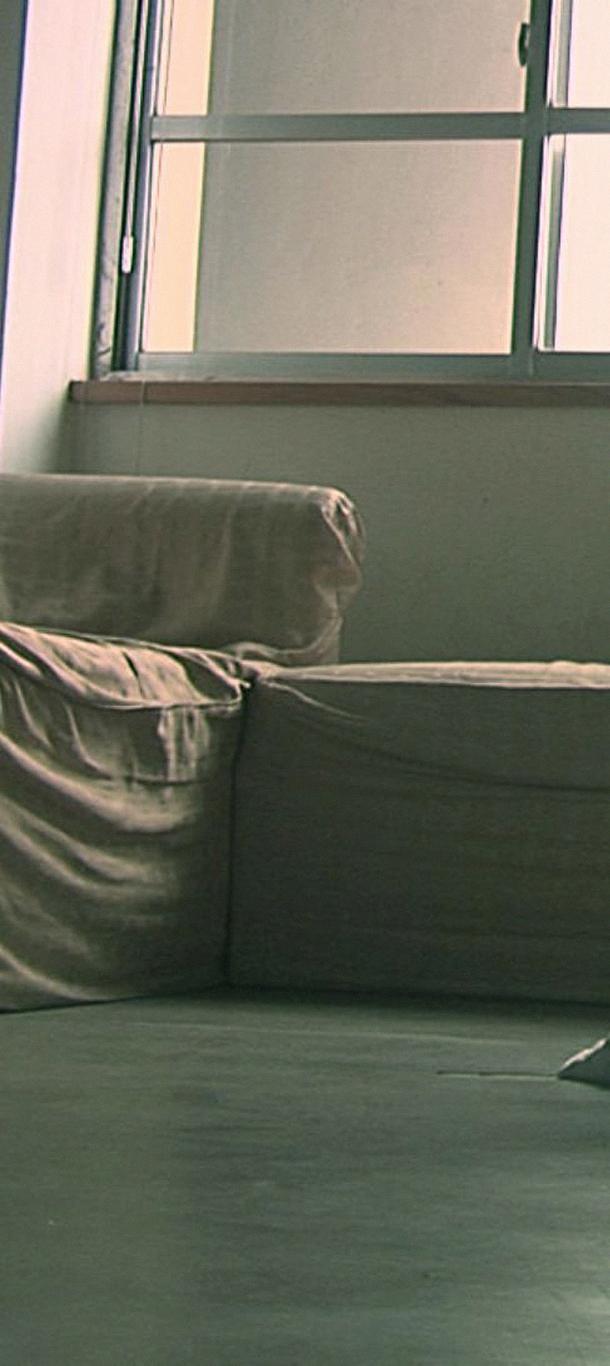


marriage, there are other parts where women have to experience mutilation and forced marriages. Artist have been involved in political movements throughout the modern era, and as artists in this contemporary age, it is not necessary to address one’s political views directly in the work, but possibly offer a unique point of view. I think this has always been a part of an artist's job throughout history. Now, perhaps even more so with Internet and technology, it definitely accelerates the collaboration and interaction between artists in different fields around the world, which creates more dialogue, which is desperately needed now.
My work has always been deeply influenced by Chinese painting and calligraphy. Influenced not only by the techniques and tranquility of it, but also the philosophy and historical baggage. The history and philosophy that nourished me growing up are ironically the same things that caused me to rebel, deconstruct, and use different languages and approaches to my art. There are many rules and codes in traditional Chinese painting and calligraphy: the way of holding the brush, the unique way in breathing, to the high expectation in artist’s moral standard, etc. Being an artist in Taiwan, living under the

shadow of China and the political instability, self-assurance and identity has always being an issue for me, so finding my own language to break away from all that historical baggage was also very important. For many years after college, I couldn’t really appreciate classical art. Whether Western, Eastern, realism or abstract, I had a hard time truly appreciating anything besides “contemporary art”. Not until recently, after went as far away from classical art as possible, not really holding a brush for so many years, and experiencing what life had offered, did I start to be able to genuinely appreciate classical art once again. Meanwhile, I started to miss the smell of the paint, the texture of paper, the isolation when I create, and the intimacy between my work and myself.
I recently read an article by a Taiwanese artist Shih Shou-Chien who mentioned each art piece in our history is like a time capsule, it tells a story in that time period that words can’t simply capture. As a contemporary artist, this is what I am trying to do. I'm trying to tell stories about our time. Hopefully I am able to take experiences and inspiration from history and create something that speaks for our time.
That being said, besides many Taiwanese and Chinese artists that I admire – Chen Chi-Kwan, San Yu, Xu Bing, Wu Tien-Chang and many others, I look up to western artists like Vermeer, Rembrandt, Duchamp, Basquiat, Cindy Sherman, Bill Viola, and my most recent idol - Kerry James Marshall, who is using many historical paintings as inspiration. He breaks away from them, telling his own story, and rewrites western art history as well as raises many questions through his paintings.

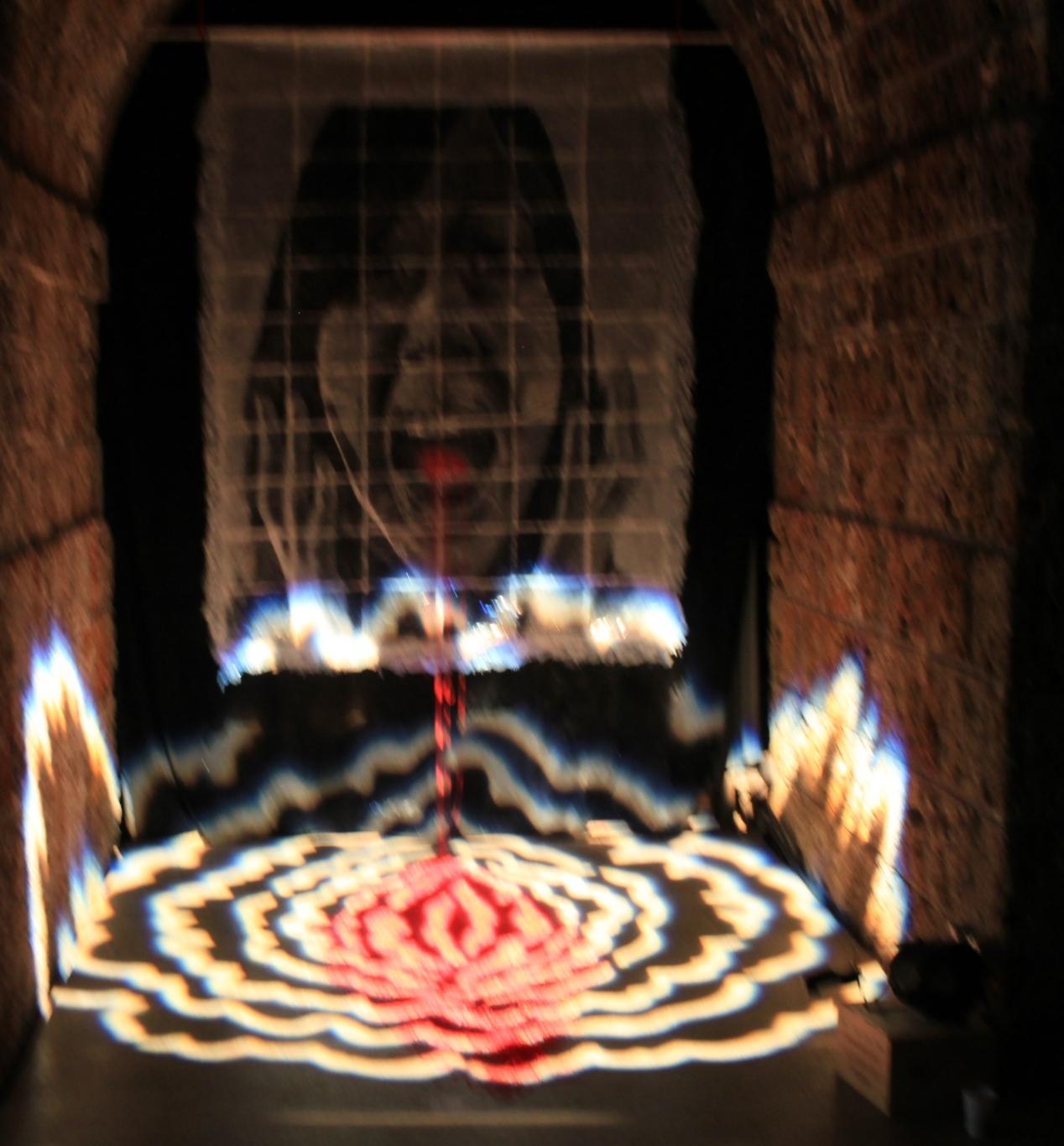

When I first “officially” quit making film in 2016, it was not exactly easy to come back to painting. I think there are many differences in the thought process between making a film and working on a series of paintings. I really wanted to try something very different than I had been doing,. Something that allows me to get as close to paint as possible, something that really comes from my heart. I started by just trying different paint mediums, and I found this amazing medium called “encaustic”, which is also known as hot wax painting. It's a mixture of bee wax, damar resin and pigments, and I pretty much fell in love with this medium right away. It’s just so different than anything I have tried. It’s very versatile and flexible. It allows me to draw, paint, carve and melt my work, and the results are usually full of accidental surprises. For almost a year I was just focusing on learning this new medium, which was exciting. And by doing encaustic, it gave me inspiration working on some other mediums as well. The result is the “Home” series I am currently working on, and “City of Angels” is one of them.
Working on encaustic reminded me of working on Chinese paintings, because I can have layers and layers of paint on top of each other and still be able to keep it’s lucency. I also like the texture that paper creates, how it’s just overall more raw and
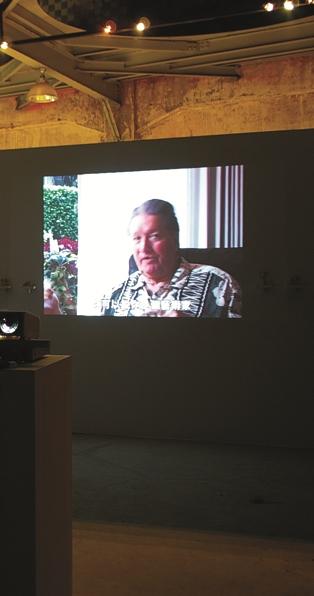
fragile. Many times, I would have layers of paint with water dripping down the wrinkly paper, and I just love the look and feel of it. The base of Chinese painting almost always starts with black ink, and that’s usually how I start with my paintings as well. I use a lot of black and white in my work. I would then cover this black and white with different colors, and then cover this again with black and white. I will use rollers, different brushes, paint knives with acrylic paint, oil and pigment sticks and charcoals, whatever I find on my desk, and just use layers and layers of different mediums. Even though I have a rough idea of what I want to do, a lot of time, I try to not to over think it, and just let my body do its job. So what you see here was once a completely different painting.
These two paintings are also part of the “Home” series, the constant moves between different countries, the inability to keep what are considered essentials, not having a sense of belonging and having things get lost in translation, have all led me to question and redefine the definition of “home”.
The “Blue House” in particular was based on the “tent-homes” on the Skid Row in downtown Los Angeles. After leaving LA for more than 10 years, I came back to a city
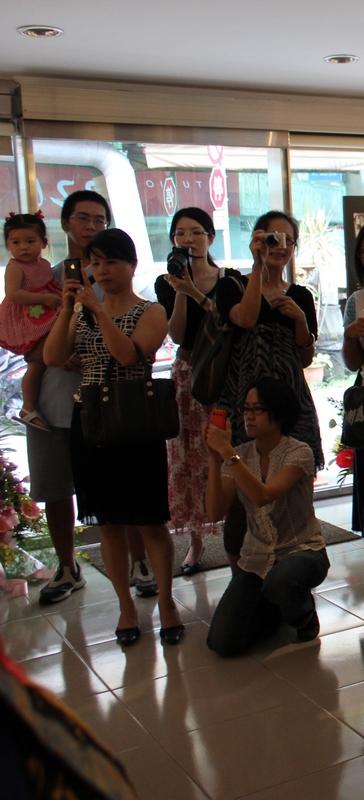
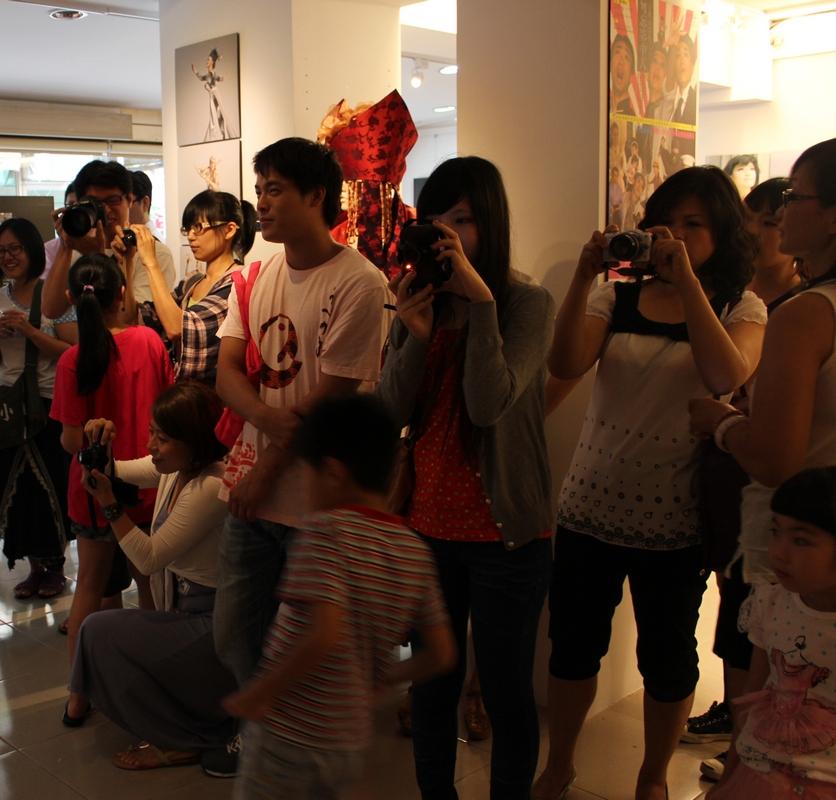
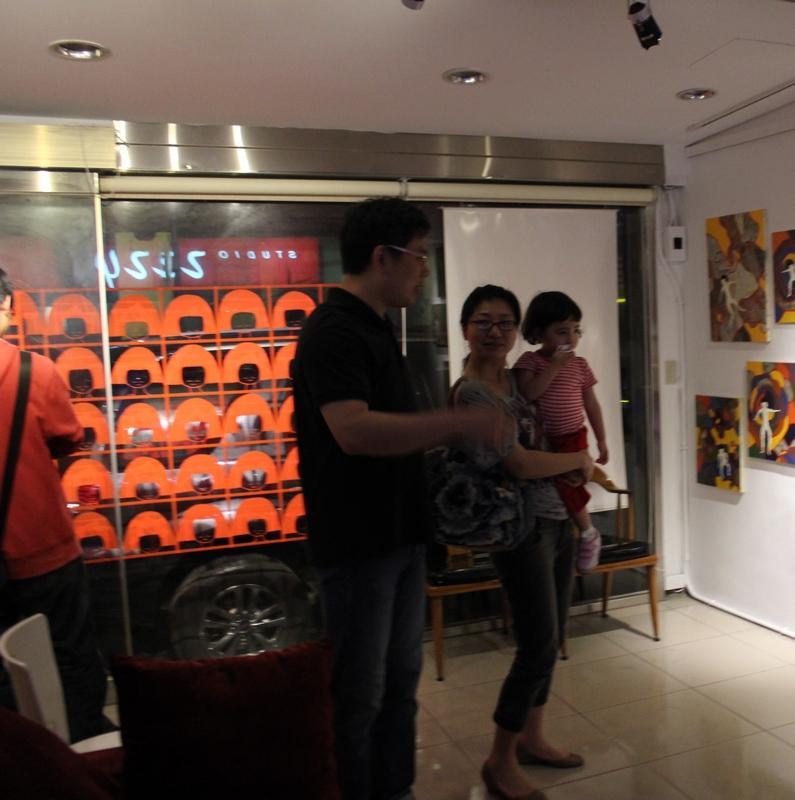
with horrendous traffic and an unaffordable housing market. Home prices are at an all time high in LA, but another part of the city is full of homeless people with their blue tents in Skid Row. This really made me question the capitalistic society we live in, and what home really means? Instead of using a direct way to convey my ideas, I feel like I need to have the emotion be expressed through paint and paper. This way the audience can get up close to the paintings, and appreciate the layers and layers of paint, the textures, and maybe experience what I experience in a much more personal way when I create my art.
So to me, even though the paintings might appear to be abstract on the surface, they really are representational. I am not sure if I have found the balance between them yet, especially because I was never really into abstract paintings, so working on something that requires much more motion and attachment instead of logic and techniques is a real challenge, but at the same really exciting. I am still in the beginning of this Home series, and I hope by the time I finish the series, I will be able to give you a much better answer.
 ART Habens
ART Habens
I like to say no. I don’t like to consider the audience in my decision-making, especially after making so many documentary films for the international audience, Making sure audiences from different countries can understand what I try to convey was crucial. However, now that I am stepping away from that type of commercial work, and as much as I don’t want to think about it, viewers certainly are still an important component probably for all artists. After all, visual arts are meant to visually communicate with people, so without the audience, I guess we don’t really exist. When I was younger I liked to pretend I made my art for the intellectuals, for my peers and art critiques, and I think that was probably the result of spending most of my youth at art schools. I was very naive and certainly arrogant. Now that I’m older, and hopefully a little wiser, I just try to be true to myself, and although I don’t try to please the audience, I do hope that my work can speak to some people, even people who are not into art.
When I was working on the “Sugar Baby Project” part of the process was using the art space Studio 2224 that we were running to communicate with the audience, and I was extremely surprised how little people know about contemporary art and how rare people actually would walk into an art space. Studio 2224 was located in Taipei, the capital of Taiwan, a major city in Asia. The studio wasn’t in a commercial district, it was in the middle of a residential area. Very soon I found out that most of the people that walked by the space had no idea what we were doing. Some would stand outside of the space for a long time trying to figure out what kind of business we were running, and some would come in and ask if we were a design company. Slowly, after explaining to them what we were doing, I would start to see
excited expressions on people’s faces, and then the neighborhood started to realize we were just bunch of artists trying to do creative events. We had paintings, music, videos and installations. Whether or not they understood what we were doing, people were happy, and that was a refreshing and rewarding experience. So now, I take that experience and apply it to my work. Whether I use Chinese characters or metaphors from historical context, or explicit sexual symbols, I believe if I am honest to my work, then the work will speak to the audience for itself.
After relocating back in LA, I am slowly getting back into the art scene in the U.S. and have joined the International Encaustic Association. I recently received a grant to attend the annual Encaustic Conference in Provincetown, MA, and I want to continue to explore this amazing medium. I'm sure I will keep moving from one media to another, switching gears whenever it is needed. My work is deeply connected to my life experiences, so as you can probably guess, my future projects will be related to life, death, menopause, and whatever life has to offer!
An interview by , curator and curator
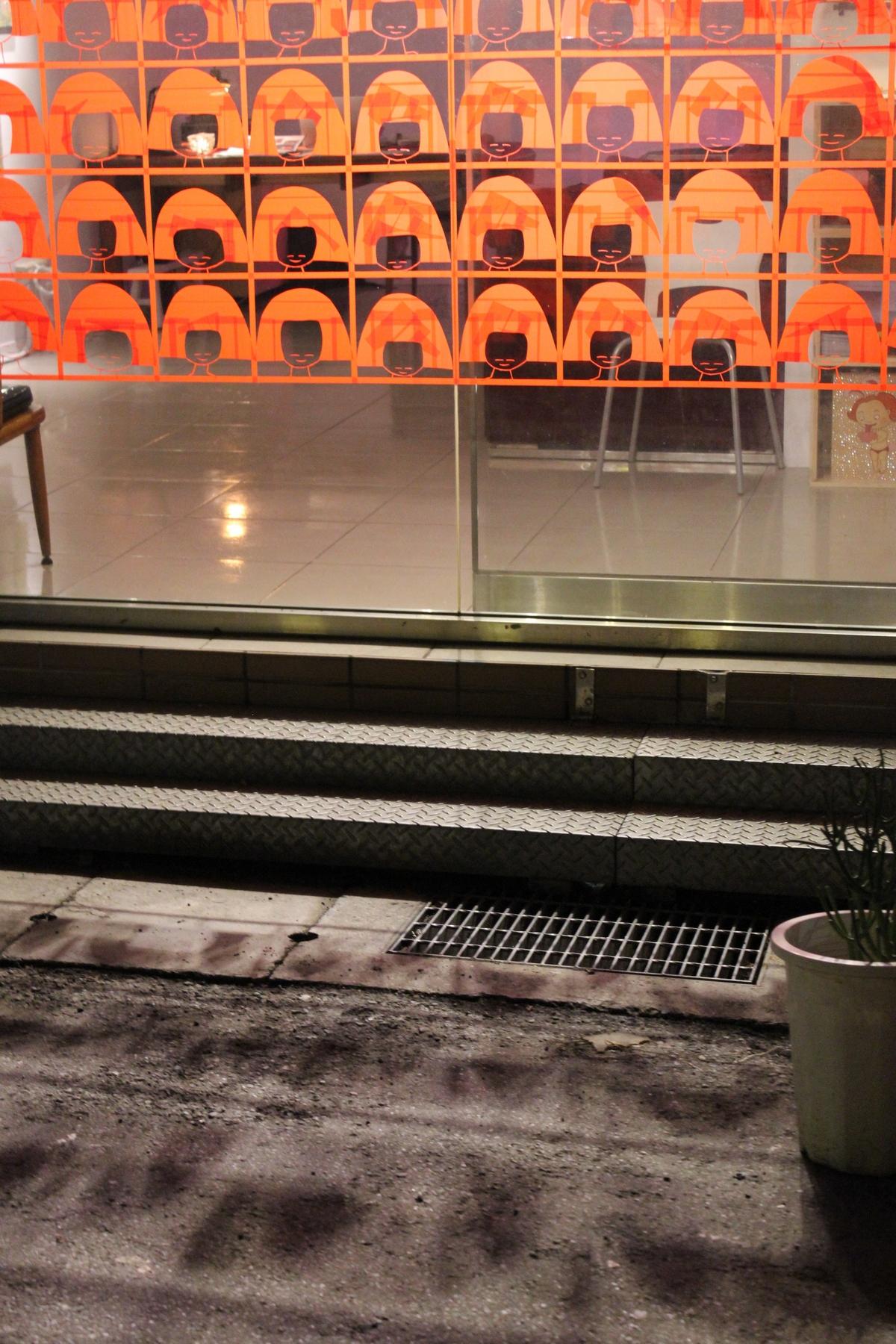
Lives and works in Seattle ,WA, USA
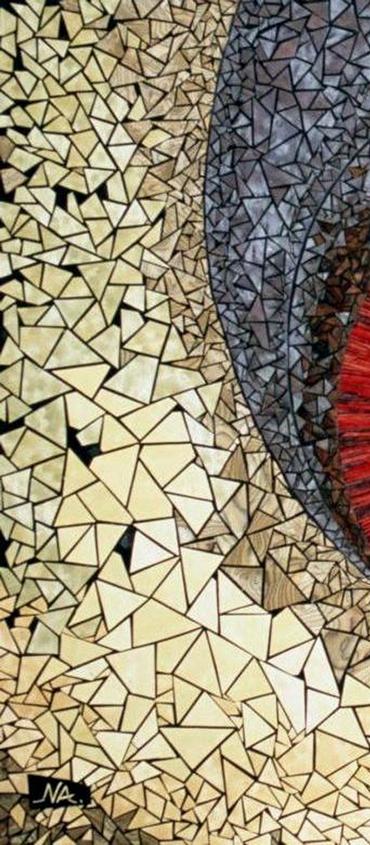
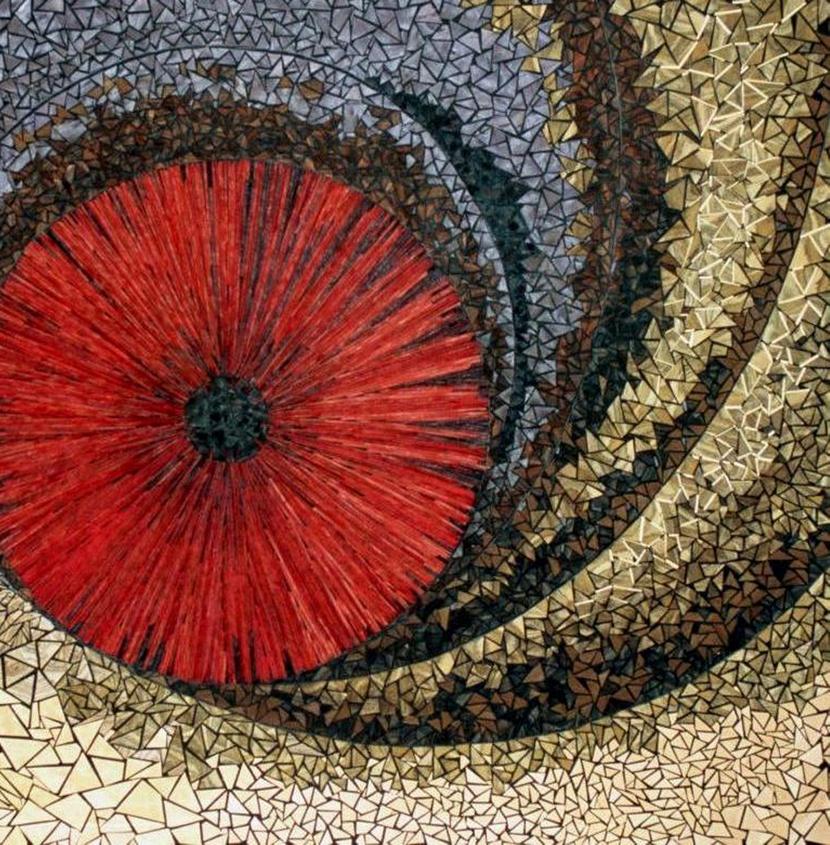
Energy
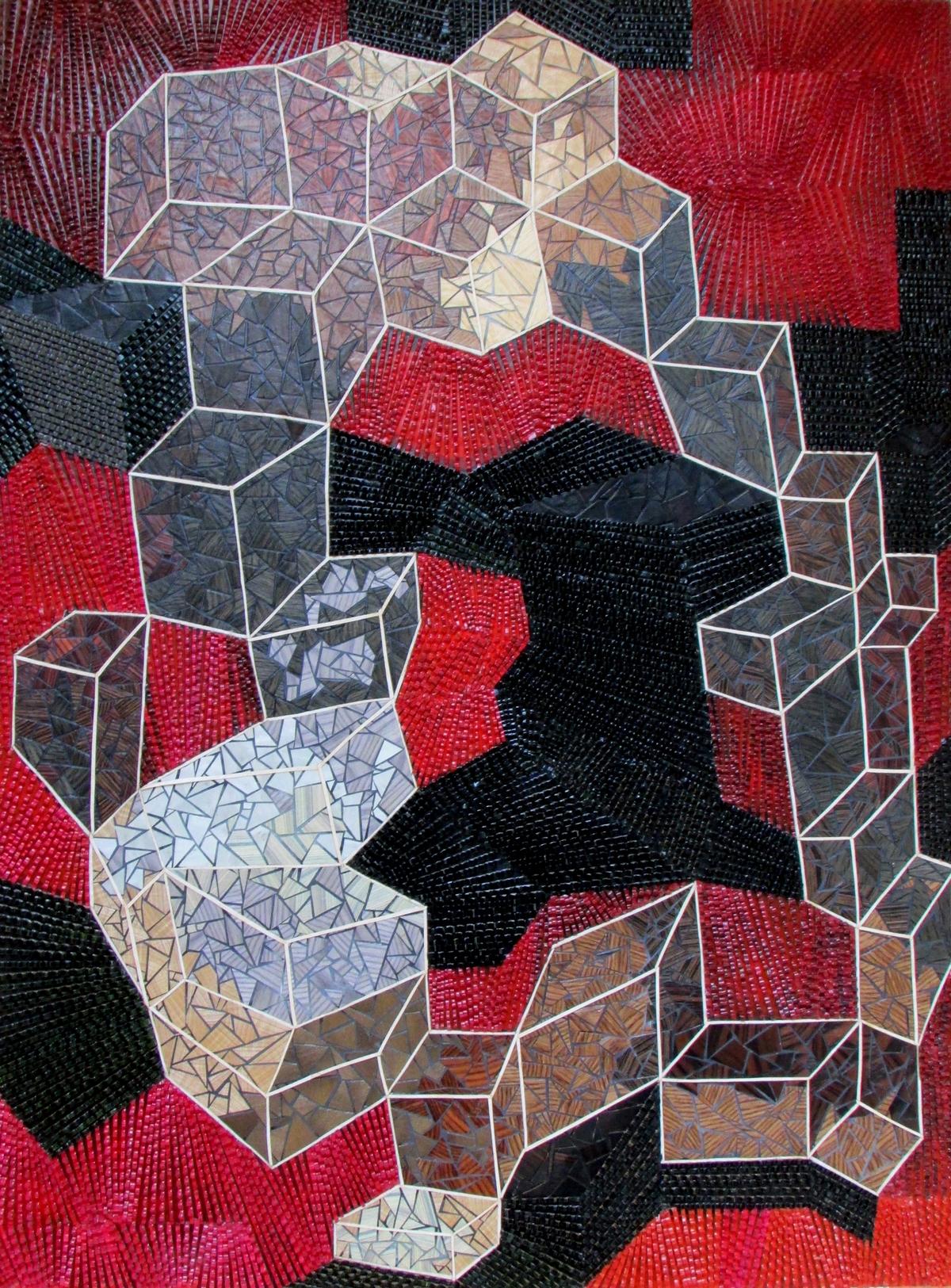 VIII - Enlivened, United, 2017 40 x 30 Inch
Handcrafted, Oli-stained, Wood and Paper Mosaic, Acrylic, washi on Board Frederick Holmes Gallery Seattle 2017 Exhibition
An interview by , curator and curator
VIII - Enlivened, United, 2017 40 x 30 Inch
Handcrafted, Oli-stained, Wood and Paper Mosaic, Acrylic, washi on Board Frederick Holmes Gallery Seattle 2017 Exhibition
An interview by , curator and curator
Hello ART Habens Team, First of all, thank you for your kind discovery of my artwork thousands of miles away from London, UK for the upcoming special contemporary art review. I am very honored to be part of your art review.
After acquiring my B.A in Tokyo, I had worked as a designer at a trading company in Japan in the Marketing and PR department. I arranged the TV commercial for the products and designed products packages for Godiva Chocolate and Twining Tea Company etc for their exclusive Japanese market. At that time I felt there were many rules and regulations from the top to follow the companies’ policy, concepts and their budgets. I had also worked on design high-end greeting cards, which was not so restricted in terms of my design choice. I have taught collage art at cultural centers in Tokyo, Yokohama and other places before moving to the USA. Since I moved to America, I have faced a problem with the communication,
language barrier. I felt like I didn't belong anywhere and didn’t quite know what to do for a while. Because of my limited communication in English, I have studied English as second language at local community colleges for several years. My way of asserting myself was to become an international artist. Joining the Artist Trust program in Seattle, Washington state was a trigger for me to becoming a professional
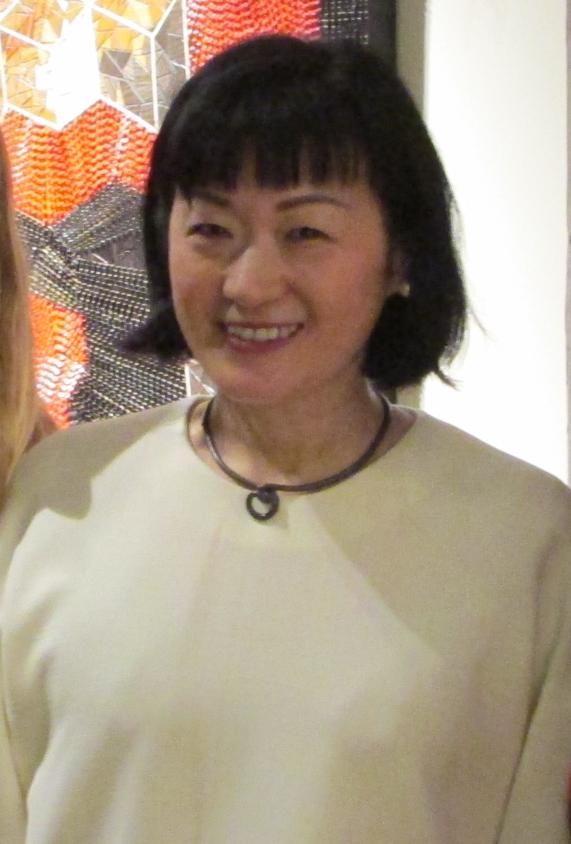 Naoko Morisawa
Naoko Morisawa
artist. I studied how to market my artworks and approach to galleries and exhibitions. And Seattle’s City Art Program was the reason I am able to have the pride of a professional. Through a competitive process, City of Seattle twice awarded me opportunities to create temporary public artwork with a budget. What I mean by “professional” is to be able to make a financial profit, whether it’s a lot or little. This also means you participate and contribute to the local community, so I started to explore how “my art” fit for the public art project and how it can be accepted by the society or community.
My central idea about my work is Japonism and Innovation. It may sound strange but I now have the deepest desire to know Japanese arts, history and culture. It seems as though my heart is seeking the Japanese culture and Japonism while I live in the U.S., and it is a very important part of me. Japonism for example can be seen in clouds, a traditional Japanese pattern *(Monyo 文様) etc. Innovation is to rediscover the way to combine modern and traditional element/ technique.
Another theme may be Re-birth, This can be found from the Magic Mushroom World Series Artwork. I read the unique story about the mushroom about rebirth or transmigration then made/ presented a series of magical mushroom art from all over the world.Mushroom spores are parasitic to dead-

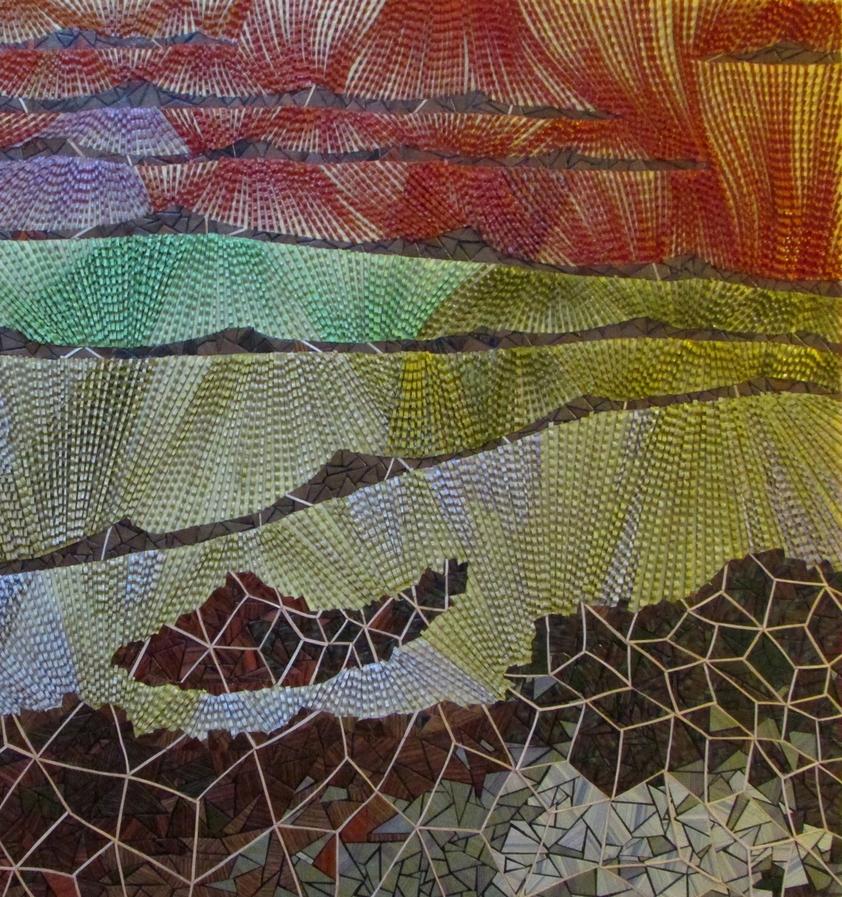
Wave XVIII - New Wave iv, Kimono, 2016, 24 x30 Inch

creatures or plants and from the spores grow mushrooms. This is like a Transmigration or Reincarnation. The shape, color, and fragility of mushroom is very mysterious. This mystery inspired me to start my Magic Mushroom project. I hope my artworks travel all around the world like a spore !
For me, coming up with a new idea and putting it in practice is almost the same as discovering a new game! I may not succeed it all the time though. By exhibiting my new body of artwork, I can see how people will react, which is a very important thing to me. I believe each audience receives different attributes/ perspectives viewing my art, such as the concept of the piece or the background of the art. I never seek for my art to be “self-satisfying” but rather for it to be an interesting piece for both the audience and me.
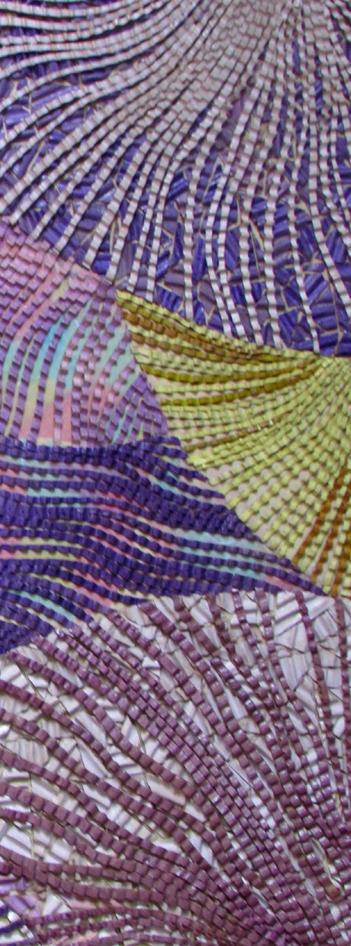
Energy IX- Imagine, 2017 40 x 30 Inch
Handcrafted, Oli-stained, Wood and Paper Mosaic, Acrylic, washi on Board
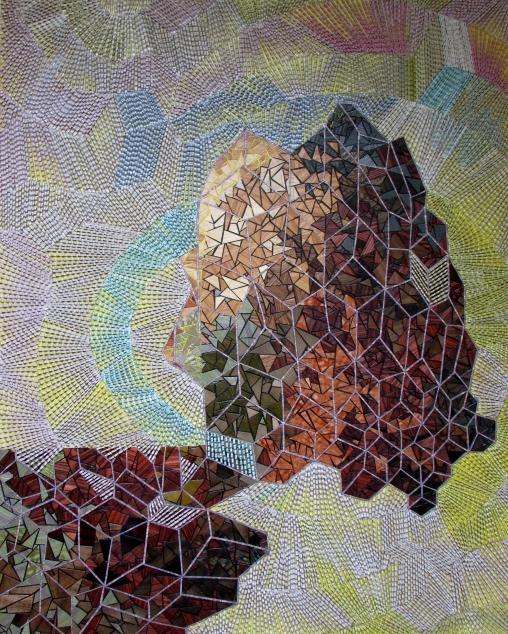
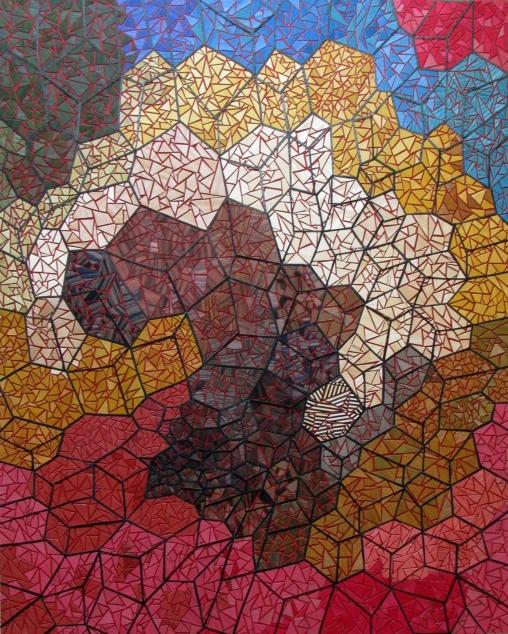
Frederick Holmes Gallery Seattle 2017 Exhibition
Energy IV- New Wave, 2014
Handcrafted, Oli-stained, Wood Mosaic, Acrylic, washi on Board
Woman's Invitational Exhibition, Dallas Texas 2017
Bernard Buffet, and Egon Schiele for their very unique lines, compositions, and colors.
I always tend to find fresh ideas coming up when I mix the traditional (techniques, colors, and composition) and the contemporary elements. These days I am very attracted to the Japanese folding *(byobue 屏風絵) screen such as Rakuchu Rakugai-zu(洛中洛外図) by Kano Eitoku. Also, I have been enormously influenced by Katsushika Hokusai, Fujita Tsuguharu,
 EnergyVII- Gravity, 2015, 40 x 30 Inch
Handcrafted, Oli-stained, Wood Mosaic, Acrylic, washi on Board Frederick Holmes Gallery Seattle 2017 Exhibition
EnergyVII- Gravity, 2015, 40 x 30 Inch
Handcrafted, Oli-stained, Wood Mosaic, Acrylic, washi on Board Frederick Holmes Gallery Seattle 2017 Exhibition
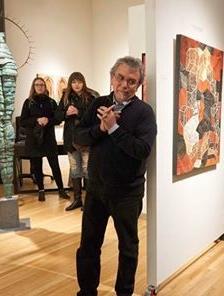 Snapshot from Morisawa’s exhibition opening day - Frederick Holmes Gallery, Seattle USA 2017
Snapshot from Morisawa’s exhibition opening day - Frederick Holmes Gallery, Seattle USA 2017

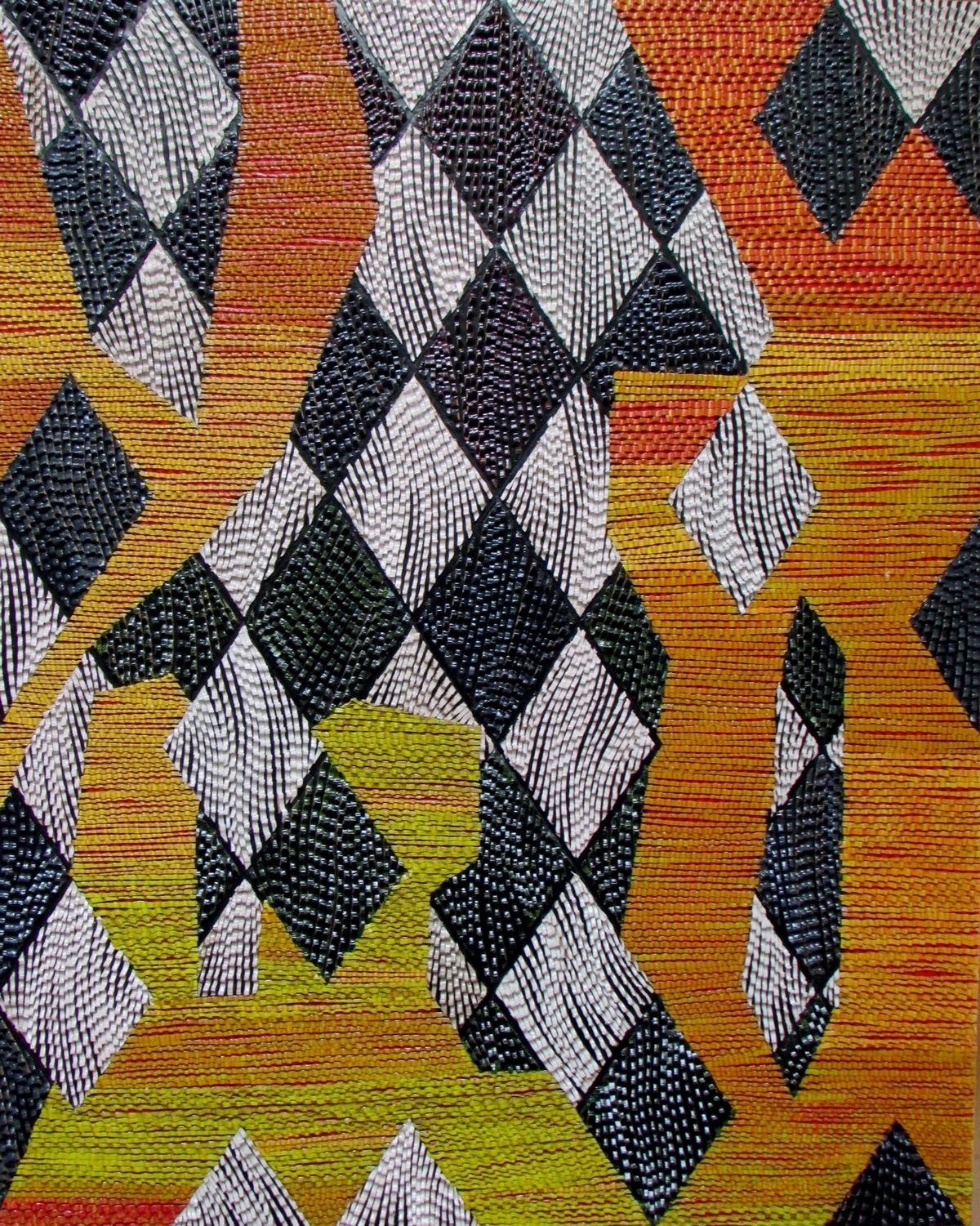 Wave Diamond ii – Canversation, 2017 30 x 24 Inch
Handcrafted, Oli-stained, Wood and Paper Mosaic, Acrylic, washi on Board
Woman's Invitational Exhibition, Dallas Texas 2017
Wave Diamond ii – Canversation, 2017 30 x 24 Inch
Handcrafted, Oli-stained, Wood and Paper Mosaic, Acrylic, washi on Board
Woman's Invitational Exhibition, Dallas Texas 2017
My Collection -Boot for Thorny Path, 2016 8.5 x 6 Inch
Handcrafted, Oli-stained, Wood Mosaic, Acrylic, washi on Board
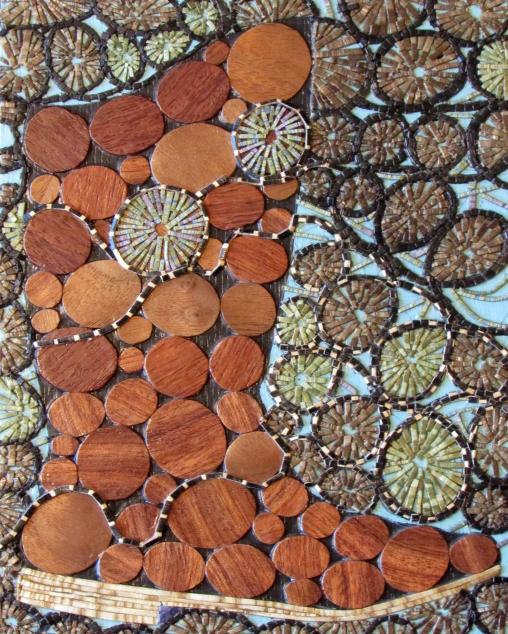
Studio Visit Magazine 2017 Summer, Boston USA
WaveXV- Hybrid, 2015 24 x 18 Inch, Handcrafted, Oli-stained, Wood Mosaic, Acrylic, washi on Board

ArtVoices Magazine Cover, ArtBasel Miami issue 2016 Frederick Holmes Gallery Seattle 2017 Exhibition
Each wood piece has its unique and beautiful woody texture/ grain, and that is why they interest me and I use them. I use thinly sliced wood and dye it to get the most texture out of it, and then I prepare the color pallet collection such as red one, yellow one etc. I made special arrangement to the backside of the wood in order to avoid breaks while cutting the thin wood.
These days, I have been adding cardboard as one of my material collections. Because paper is made from wood.(laugh) Paper is made of pulp but it is bleached, and
cardboard is much more similar to wood in terms of its texture. I use a regular coloring material for my woodwork. I like wood and cardboard because we see totally different aspects of the materials depending on how the light reflects on them or the angle you see them from. As materials, both wood and cardboard have their limits to work with, but for me I like to think things through and end up discovering the originality when things are limited. I design and make shapes to maximize the character of the materials I use. I tend to have a vision for my piece and a thought for how it should be done. However, it doesn’t mean I will follow my
Wave Hybrid – Liberation, 2016 24 x 20 Inch
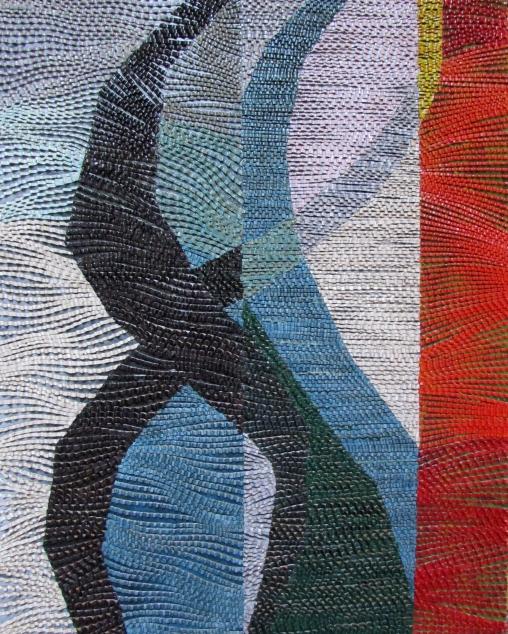
Handcrafted, Oli-stained, Cardboard Acrylic, washi on Board

Coos Art Museum Exhibition Oregon USA 2017
original vision, though.. (laugh) and sometimes I scrap it and start over the whole process.
MyCollection- Guliver, 2016 40 x 30 Inch
Handcrafted, Oli-stained, Wood mosaic, Acrylic, washi on Board
Seattle City Public Art Gallery Exhibition 2015
I always take a lot of time deciding on colors. Sometimes it happens that I change the color scheme of my pieces completely at the last moment. Maybe it is a sign that I have struggles when I would like my pieces to have a vivid contrast. I don’t know why I do this but it seems like I tend to choose ambiguous colors when I am confident.
Energy X- Underground, 2017, 40 x 30 Inch
Handcrafted, Oli-stained, cardboard mosaic, Acrylic, washi on Board
Frederick Holmes Gallery Seattle 2017 Exhibition

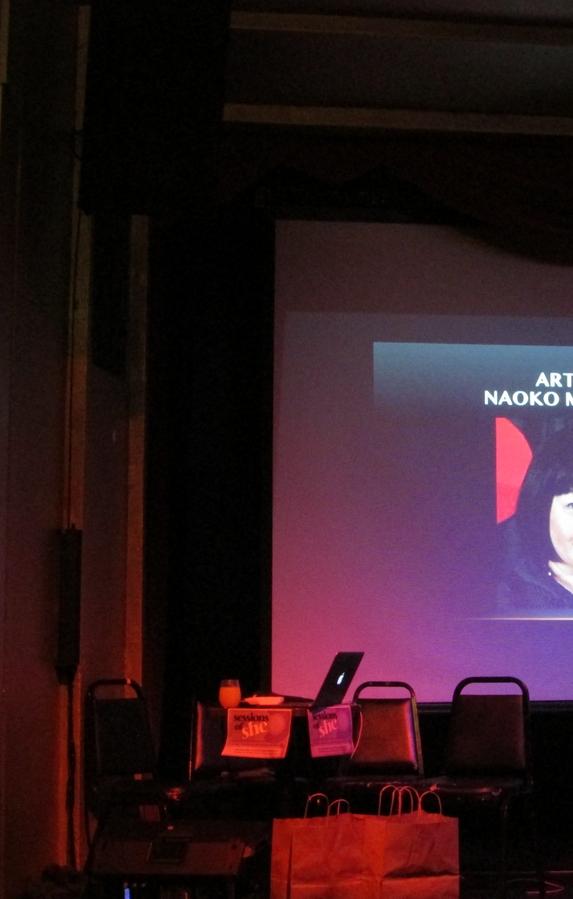
 Naoko Morisawa, woman artist on-stage interview, Rendezvous Theater Seattle 2017
Naoko Morisawa, woman artist on-stage interview, Rendezvous Theater Seattle 2017

I don’t particularly aim to but I am happy if I can provide my audiences with something to imagine or think about. It could be just their recollection, “imaginary something” or personal memory (whether sweet or bitter). There is a Japanese proverb, isogaba maware. More hassle, less speed. Do you know about it?
view the concepts of the real and the imagined playing out within your works?
In particular, how doesrepresentation and a tendency towards abstraction find their balance in your work?
As for “the concepts of the real and the imagined”, all I can say is that I can never create my abstract art depending on my “feeling”. For me, I can only create an abstract concept when I have a definite object in my heart but I believe a definite object can shift into something else. Unless I really chew this object and possess it as my own, I cannot express anything abstractive.
I personally believe art in a public space has to have tough materials against the weather, and possibly adapt every-day materials, does not give any negative feelings to anyone, and has some sort of gentle message to deliver. Most importantly, viewers have to enjoy the art. For example, “Liberated Octopus” was set on a very large field, and I wanted people to feel, “This is such a relaxing, fun, and free place”. You may receive many opinions and criticisms from people who are not familiar with art. Even though their opinions may not be favorable to me, it guides me in my inspiration for my next creation.
The tones that condense your visual vocabulary have sometimes a very ethereal quality, and although you have done non-representational images in the past, you are currently at work on an entire series of abstractions: How do you
Yes. There are the Japanese sensitive patterns and styles and the very detailed patterns of the Islamic art. I am also influenced by the children's stories by Charles Perrault and by Serge Lutens who shares his unique world. Recently, I am inspired by R.H. Quaytman’s spatial representation as well. Also, I am influenced by the freeness of Oscar Murillo, Miyajima Tatsuo’s unique digital art installation etc. I have many favorite novelists and I am influenced by them a lot. Also, I have subscribed to UK magazine “Wallpaper*” as well. Always my favorite.

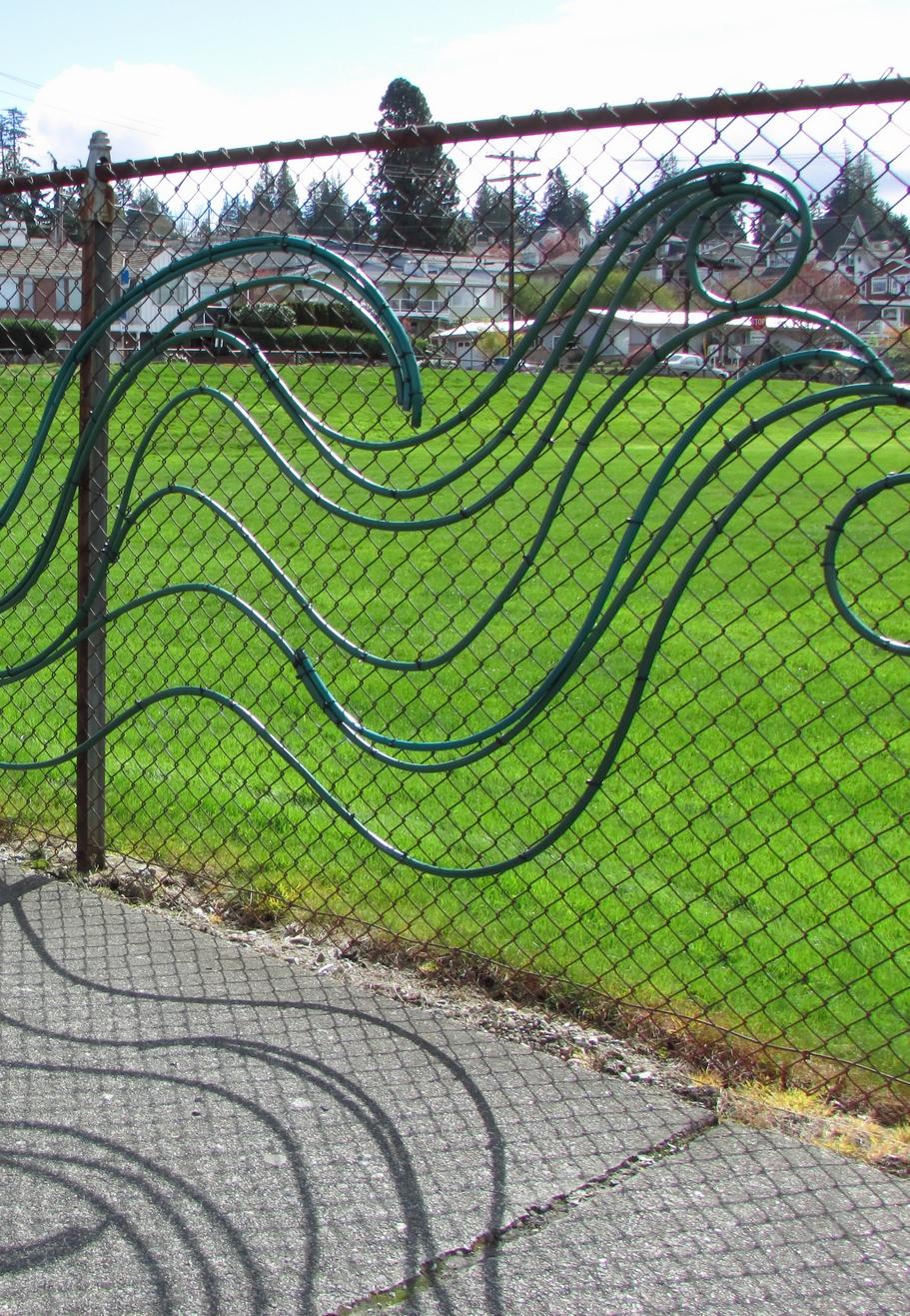 Liberated Octopus, Tube Installation, Size 2 x 13 yard, City of Edmonds Public Art Project, 2016
Liberated Octopus, Tube Installation, Size 2 x 13 yard, City of Edmonds Public Art Project, 2016
 Abundant Harvest- Green Wave, Tube Installation, 50 inch H x 45 inch W x 25inch D Amazon Headquarter Window display 2016, Seattle
Abundant Harvest- Green Wave, Tube Installation, 50 inch H x 45 inch W x 25inch D Amazon Headquarter Window display 2016, Seattle

I will answer this question thinking that you mean by “audience” as art critics, curators, and collectors who are involved in art. Critics and curators’ roles are to examine and review. As they see my art objectively and put it in black and white, I will start to see my next task/ assignments. Even in the auctions or exhibitions, art pieces are chosen for the setting not just because viewers are interested in it. If I only show my techniques, their interest in my art will eventually cease. And if I focus only on what’s new trend in art, they will get tired of it, too. I believe the technique, some kind of modern elements, title of the art is important, and also what comes with the piece, such as its subtitle or what you would like to say to society. And they need to be balanced. Well, it is not easy to provide all that, though. If you have a chance, please visit Seattle. Come see my public artworks, and my representative gallery, Frederick Holmes Gallery in Seattle, USA. Thank you.
Thank you so much for the opportunity to talk about my art. I will continue working on tube art painting projects as well as mosaic collages projects using wood pieces and cardboard. I will probably add new medium for my future project. The next piece will be more personifying than the previous ones. Also, because of this interview, my idea for tube art painting has been broadened. I would be very pleased if my art were used for exhibition at contemporary art museums, for theater-stage designs, or even in a film studio shooting etc. I will go to the end of the earth to create my art, so please contact me!
While most of my work is currently being exhibited on the Pacific Northwest of the United States, our studio is seeking to expand visibility through an international representative gallery that will bring my works to major art exhibits such as Art Basel, art collectors and museums worldwide. I would like to exhibit my work in New York City and throughout Europe in major cities in the United Kingdom, especially London, France, Spain and Japan in the future.
Translation supported by Aki Banks, Texas, Frances Chapin & Susan Wagner, Seattle, USA Naoko Morisawa/ Morisawa Studio Website ART HabensYour Letter- Okuribito (Departure), 2008, 22 x 16 Inch Handcrafted, Oli-stained, Wood mosaic, Acrylic, washi, sumi on Board Nordstrom Exhibition Celebrates Asian Pacific American Heritage Month, 2009

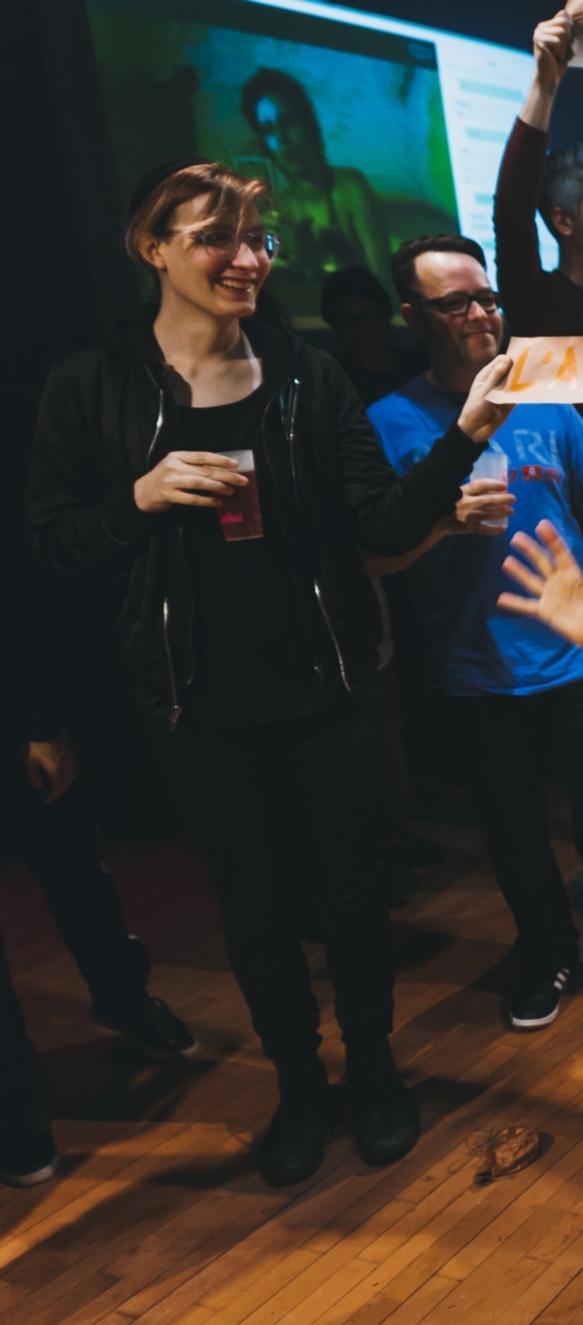

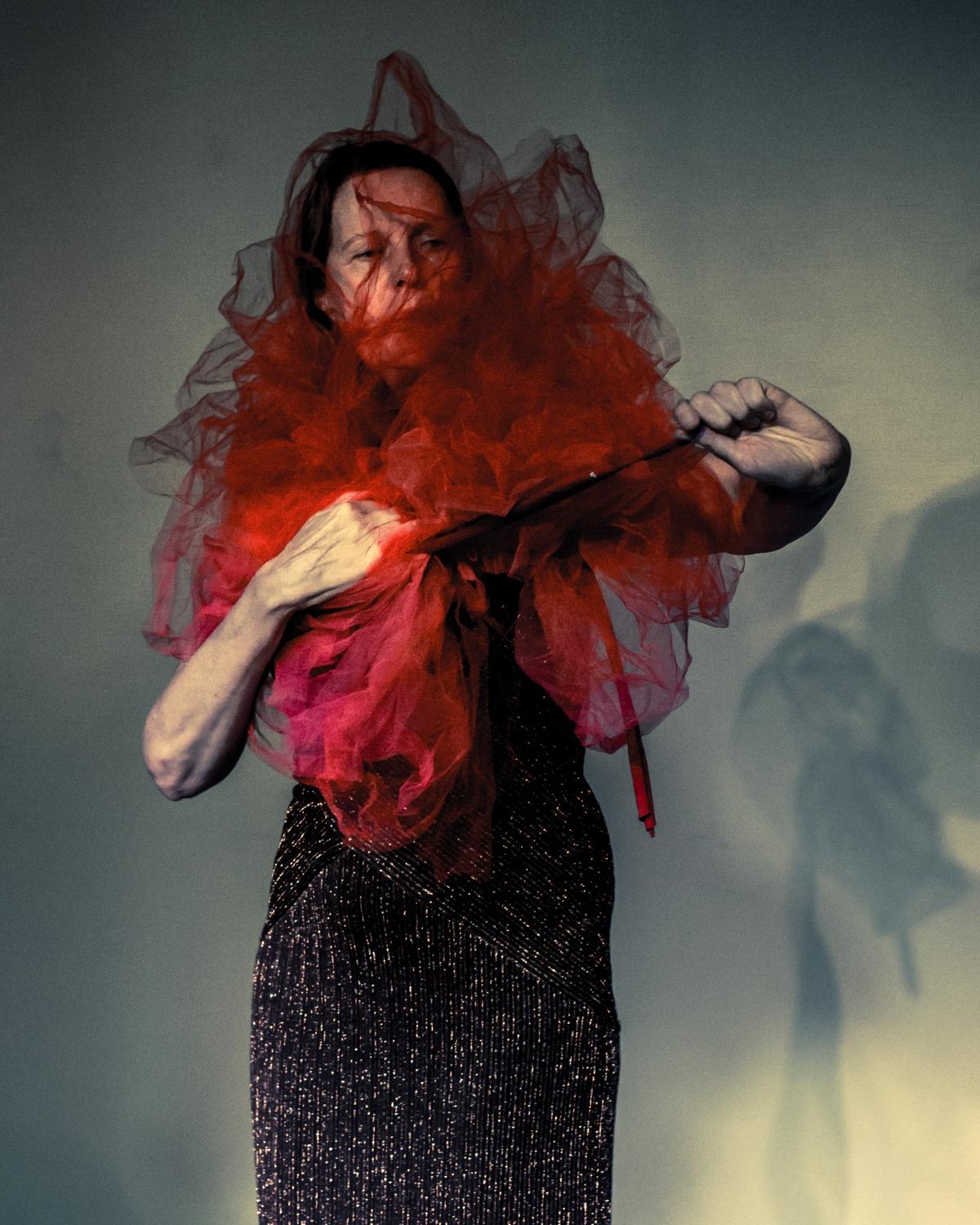

I like to use a variety of disciplines and skills in the performances I make, for each performance, it seems to me necessary to discover what can take out of my basket to make the performance as authentic and strong as possible.
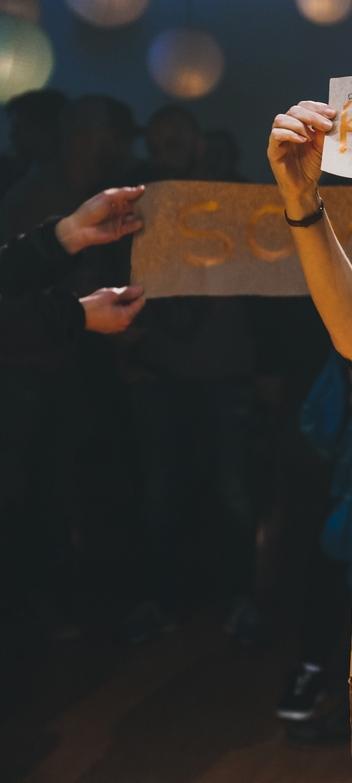
Where as some performances need an approach that correspond with my Butoh training (for instance a work in process about the process of aging: My Bones), other performances can be more dada inspired and there fore need a wild and anarchist 'clown' aspect to be developed. And for my dada adaptation of Three sisters, I ended up using dress up dolls and a carton mini theatre! In Merz! I create a war between plastic forks , knives and spoons. It all really depends on what works for me to present an adequate, yet absurd viewpoint of the theme of the performance.
I live twelve years now as an immigrant in Montreal, Canada.I left the Netherlands, where I lived in Rotterdam, in 2005 with two suitcases and hope and off course also a tiny feeling of anxiety! I feel at home in Montreal, and go back to the old continent twice a year. It is interesting that even though the culture of Canada is not as far away from my own Dutch culture, I have realized, over the years, that I am not only Dutch, but as well that I am an European artist, residing in Montreal. Montreal is great, a melting pot of so many cultures and very open to what ever art there is. I love to shop around in the different neighbourhoods and there is even a very modest Dutch community here.
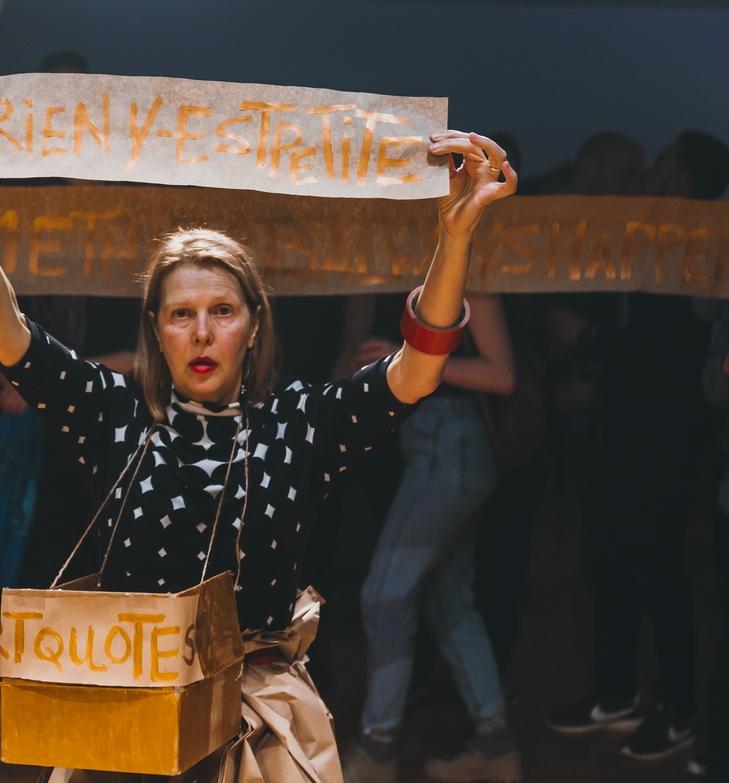

Art is available and I am grateful to be included in the eclectic art community here. But...from time to time I need to go back to my roots, especially to be connected with a more intuitive and expressionistic way of creating. In Leipzig , I have found my second home for that, a very inspiring art hub, with strong artists and a generous approach for real experiment and risk taking.I crave that kind of energy once in a while!
Off course growing up in Rotterdam formed me, for the most part of my life I lived in a scarred cty, that was actually bombed twice ( the second bombing is somewhat hidden in the history books), once by the enemies and once by mistake by the friends.Being in a city that was always under reconstruction taught me a lot about 'just doing it' instead of being to 'heady' about things. There was a lively underground scene, very active especially in the jazz scene. Spaces always moved around, since the city renovated old and carred buidlings. This mentality I brought to Canada and I am happy to merge this skill of creating on the spot with the more sophisticated way of working in North America.
Having obtained two bachelors, one in theatre and one in visual arts, it was not easy for me to make a choice what side to take in my artistic process when I was in my mid thirties,until I kind of discovered that 'and ' is a much softer and nicer way to weigh decisions than using 'or'. This 'and' allowed me to be inclusive and through the years, have not only learned to include different media and disciplines, but in my performances, I more and more include the

audience. Actually, I have started to call the audience my participants because I really feel they have so much to offer to my performances: energy, input, movement, distance, humour, the unknown and un expected element that very often give my work a push. I am very inspired by the collage, cut and paste, nonsensical style of early dada artists and expressionist culture in the early Weimar republic. It is a strong connection, I can not entirely explain in an intellectual manner: it is almost a physical attraction. It speaks to me so to say. Some people here in Montreal call me a neo dada ist, which actually is flattering!
In my works, I search for a poetic simplicity, a notion that deep down, even coming from different places on our planet, or different cultures, life styles, genders, race and social class, we have one thing in common: we are humans and we all have the need to be seen, heard and listened to. Togetherness and communication are very important elements in my performances, although I certainly present these themes in an unorthodox and very often playful manner!
Very often my performances are fed by coincidence and sensing what is needed at that particular time and place. In 2016, I was invited to perform in an artist run gallery in Montreal and I was the last performance ina dense line up of performances that evening. Some of the performers really did not respect

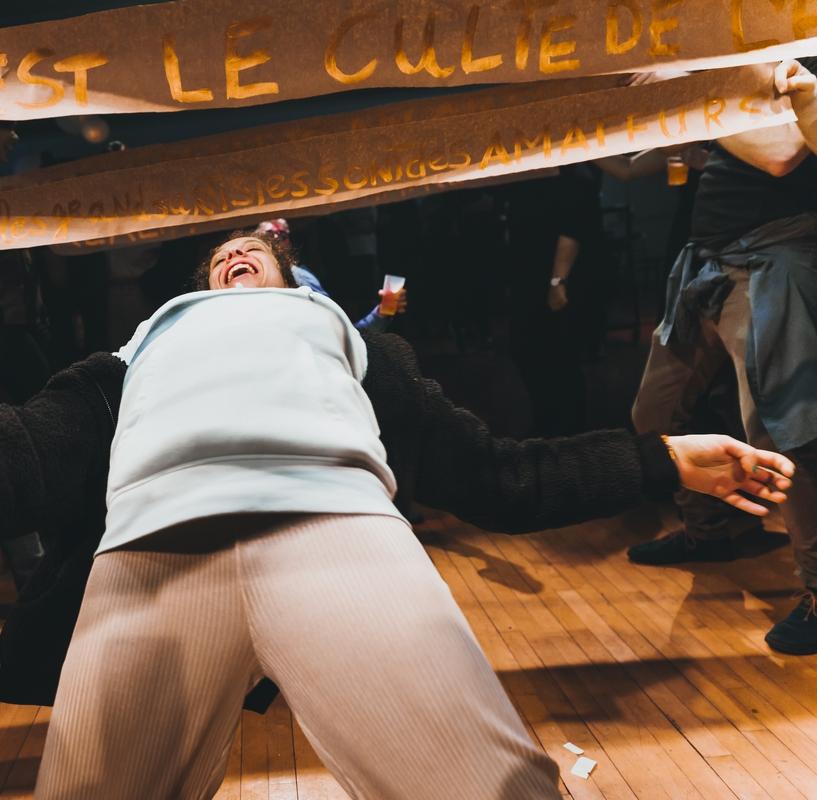

the time and so it became a very long and tiring evening. I am really sorry to say this, but the audience was exhausted and actually, I thought about cancelling my performance, feeling the tiredness of the people in the room. But many people had come to see me, what I really found heart warming. I felt that I needed to shift the energy in the room and instead of performing myself I 'invented' You are the performance! With the elements I had brought in anyway: a tent to be build, a dada poem by Hugo Ball, balloons, paper, pens and a duster. Soon the whole room was a festive chaos, people screaming Gadji beri Bimba, running around wit the tent, writing and dusting each other. It was fun! I concluded the performance, inviting all to sit in a circle, breathing together and I thanked them, saying: remeber this, it is always you, together...You are the performance. And because t was such a heartwarming and especially lively event, I thought about how we have this tendency to divide, even if we think we are contemporary inclusive aritsts, we often put on tis frontier between us and our so called audience.
That is certainly an interesting thought. Personally I like to mix and match meaning, breaking rules and invite an atmosphere where the 'unexpected' rules throughout the performance. For me, both ways works, as I said earlier, I am tempted to think 'and' more than 'or'!


Memory to me is a strange and very intimate process: we rely on it and at the same time, we kind of know that memories are always coloured and therefore not very reliable. Memories can be passing generations, think about collective memories that pass on trauma, for instance war, social injustice and discrimination. I notice that my memories over the years change in their meaning and intensity. Nevertheless, memories form us, more than we sometimes realize. The war within, a performance about exclusion and the mechanics of war, is inspired by memories of my parents, told to me when I was a child. They grewup as children during the second world war and suffered two bombings and severe hunger. That marked them but both dealt with these memories in a very different way. To be included n these memories, I felt I lived that war too and at some point, I felt th need to transform this confusion into an interactive performance where I try together with the participants, to decode the mechanics of war. In this performance I used balloons as a metaphor for inclusion and exclusion, I played with toy soldiers and magnify glasses and became pregnant with my old doll Katinka, delivering her with the help of an audience member.
there is much room for the un known and I love to 'channel' in the moment and explore together with my participants. Improvisation is much needed in life as well, I find and since I love to make live art, I need to have the freedom to be as alive as possible in the work during the presentation.And I love to invite this feeling of freedom with my participants!
Improvisation is my key to connect with what is happening in the moment it self, what is happening with me and what is happeneing within the relationship I am building with my participants. I find that if there is a strong frame or skeleton of a performative work,
Imagine a world without art, imagine a world without writers, painters, performers, musicians and so on. Imagine a world where everything has a function in a very one dimensional way. Imagine a world, where the dream has no room. Imagine a world without a place to reflect on what is happening. And there is happening so much nowadays, and we all have acces to it through our social media, but how can we reflect on it? I think here art might have a function: to reflect, to give space to other way of thinking, to give space to feeling and perceiving the world and to wake up a certain kind of awareness.
Humour is key, not so much to make my participants laugh a lot, but to soften up messages that sometime can be harsh or sad or bitter. Humour also allows me as an artist to be less 'important' with what I am presenting and mos of all, I really think humour for me represents the world in the
best way: a absurd kaleidoscope where we as humans think we are the most intelligent species, where as we might still be in the prehistoric times, disguised as if we are civilized, contemporary, modern...

Senses are important to us, we hear, we see, we smell, we feel, we taste and we sense! It is true that images rule our Western society in an almost invasive way: television, publicities, design, architecture...it is all meant for the eyes. Nevertheless, the other senses certainly provide us with information too, only we do not register this information because we are so used to have the emphasis on visuals. Sound might be a second sense, taking space in our world as well; jingles, traffic, machines, pop culture and so on.
It is nice to work with senses in my performances, to let silence sink in, or use sounds that are inviting a certain emotional response. In The Unknown Men, I blindfolded the participants, so that they could truly experience their other senses and it was so touching to witness the softening up of each of them during the piece! Sound colours the image, as we know from movies for instance: a shot of a door and the sound track with it will invite the expectation of what will happen when this door opens: horror, romance, sadness...you name it! In The


Unknown Men, by taking away the sight, the participants could make their own movie in their head, listening to the soundtrack while tasting, smelling and touching.
I think we all live in the same and in a different reality at the same time, reality is a word I found hard to explain: what reality exactly? For me, imagination can fill the gap between the so called real world and your intimate take on it.
We all have imagination, we all make up stories, we all ave our hopes and dreams. This is very real to me and I find it nourishing to acknowledge and play with this fact. Popessy! started in a very small cinema in Leipzig, where I had the immense pleasure to be in a three month artist residency Pilotenkueche. I never saw movies by Pier Paolo pasolini and decided to give it a try, seeing Oedipus rex in Italian without subtitles. I was besides two Italian women, the only one in the cinema.
This film was mesmerizing: it started in fascist Italy and all of a sudden transferred to a desert,pretending we crossed centuries in time.
The soundtrack was a mix of classical, Japanese and other ethnci tracks and the costumes...oh, the costumes! It was a variety of styles, but it worked! I was there, in the ancient times and I was so in awe with the story telling and especially the look, that was

created with so much freedom! I started the next day with making a poesse cotume of cheap felt, paper mache and from there it all accelerated...
Before I knew it, I created this fierce popesse, a costume for a black space pope and a small costume for a tiny girl poe, we created a crazy ritual, using lotsof now a days words, especially the word 'innovation' had a key meaning in our wild performance. Based on rituals from Catholisism, we owned our space and rules and our participants were playing with us, as if time did not exist. It was wonderful and I think one of the elements, that made Popessy! so powerful is this crazy mix between reality and imagination.
I find everyday reality sometimes far more surreal than what ever I imagine, to be honest. Like walking around in a supermarket, we all know this kind of shopping and we all find this a very normal and common thing to do.
But for me ( and trust me, I am not against this, just saying) it is a very surreal experience sometimes. All these products, packed in plastic, like even cucumbers! And the dates, where has our own sense to feel or smell if a product is still ok to eat gone too? And the packings: coloured plastic, names of brands, illustratiosn on it to sell sell sell... The music accompanying this 'experience', the strangeness of it all sometimes makes me laugh and who knows, maybe one day I will use a supermarket as a methafore in a piece, because the format is so weird actually.
Now that is one example, but there are so many in our modern world: the way we dress, the words we use to describe our projects, the urge to always be faster, better and smarter. For me mixing imagination and


reminders of our daily life is key: it invites not only a laugh but hopefully we will recognize the crazy elements in our 'reality'!
All my visuals depend on what I feel the performance needs, and very often I collect things, objects, images without knowing why, to discover later that these things were
simply waiting to be engaged in a piece. Sometimes I like to be very baroque and use an overwhelming amount of objects etc. To be over the top! For 'How to become a Saint?” I spoiled myself and the participants with lots of stuff: hair, roses, thorns, rope, paper, hammers and off course in the end lots of fake diamonds sticking on my torso! But hen for 'My bones' I am simply dressed in black with a black veil and let the light and shadows be the immersive visual. It really depends...

I love working in public spaces, it allows me to make contact with so many different kind of people! It is also great to perform for my fellow artist peers or my small followers or performance lovers in general off course. But in public spaces, I get that extra awareness, an awareness to be clear, on the spot, in the moment, for real. 11)Moreover, do you think
that your being a woman provides your artistic research with some special value? Maybe. I do think as a woman you probably touch themes that are more related to life but then again, I am not sure. For my art, I am convinced that the fact I am a woman, coming from a certain era, a definite place in the world and being brought up in a working class milieu, forms a kind of 'base' in my explorations, hidden off course but I do think these experiences shine through.
I am so lucky to have found so many artists that feel like 'family' in the approach of themes, play, form and content here in Montreal. It was one of the main reasons for me to take the big step to install myself here in 2005.
Not only is the community here very open to new comers and very generous in sharing knowledge and opportunities, there is especially that crazy melting pot of cultures( not only ethnic but artistic as well) that inspires me big time!

To be able to have been working with Mobile Home for instance taught me a lot about the power of object manipulation, to give an example.To be working with a dancer fro nervous Hunter's Phadra gave me an opportunity to move bad ass! Working in Avale! for Joe, Jack and John was a challenge in collaborating on a slower pace than usual.
important component of the work in the end.
I wil be working on The String in Cyprus, making a performance and installation, inspired by the Komboloi or worry beads, used by both sides of this divided island. I am looking forward as well to present older performances like the Paperbag Queen and In Transit in festivals here in Montreal and ina festival in New York. Another beautiful thing happened: I am accepted in a residency in Montreal to work on Merz!
I really love to develop a performance about he mechanics of war for youth and adolesences. The Cube, a youth theatre here in Montreal , will host me and are willing to spoil me with technical help and space. I am so thrilled to be able to develop my dada inspired approach of this topic.
This summer I was in Europe, travelling and working in four countries: France, Germany, Norway and the Netherlands. Luckily I speak four languages, so only in Norway, I had to perform in English. But still, I learned some words, just to connect on that level and show my willingness. Willingness is all. Not only in language but also in attitude and energy. Willingness to open up, will open up. It all works like a mirror, except that left is not going to be right and vice versa! I do think it is crucial the audience is involved, without them it is less intense, less alive and less of a plunge into an adventure with unknown elements. Even if I do not speak or communicate with them directly, this energy is there, I can not ignore that. Often my audience guide me trough my performance, without them realizing it. They are the most
More and more I am convinced that my work will find its way in the world, and I allow myself to relax, be more in the moment of creating, performing and to what is, rather than what 'should' be as I did in the past. I also gave up to fit in a trend and word my projects therefore more complicated than I like to. More over, I hope to crawl around performing in my late nineties!
An interview by , curator and curator

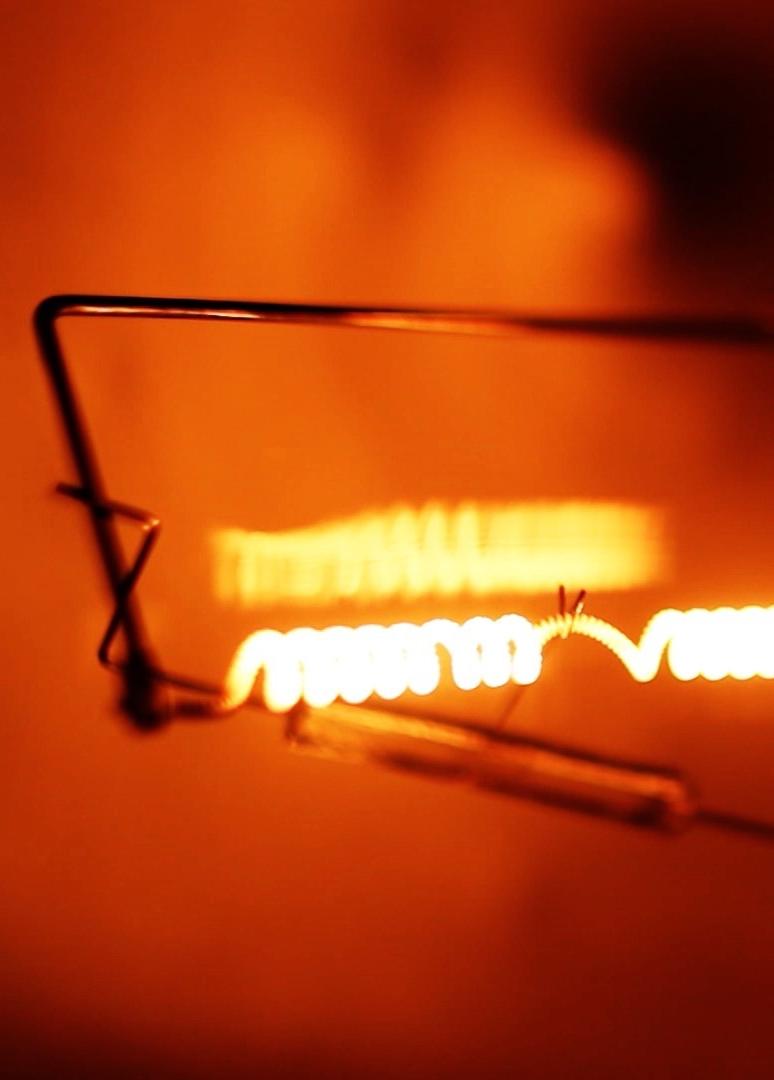
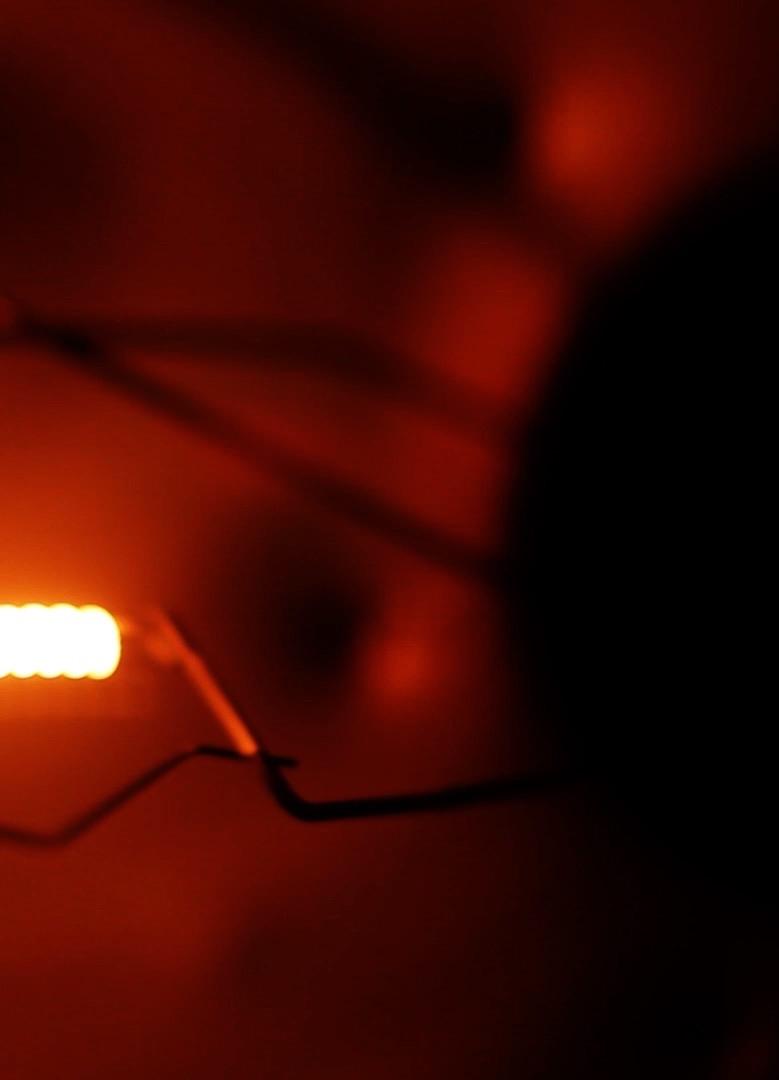
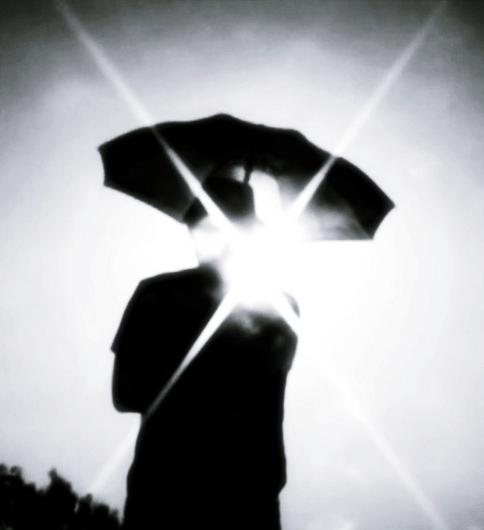 An interview by , curator and curator
An interview by , curator and curator
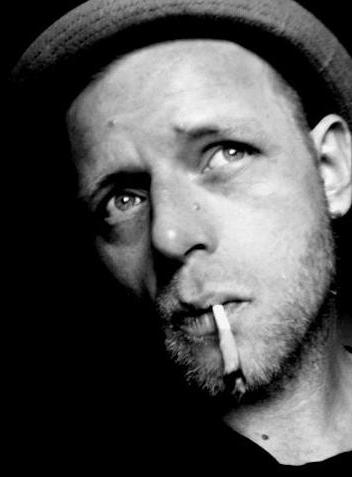
In my personal path as artist, I have always considered art like a physical and psychological necessity. Creativity as a natural progression in itself. A representative form of our psychic
observations through the evolution of our being. An infinite vital source who shapes our existential cycles. My films and visual works has been shown in several international film festivals, cinemas, symposiums, juried screenings, numerous solo/group exhibitions. I am working and living between Switzerland, Greece and France. Founder of Helicon Films with co-producers: Ed Alvarado and Jean-Baptiste Lozac’h. Indie film label of cinematography and sound
Fred L'Epeedesign (United States-Switzerland). I had also the chance to work in a wider shape into the social field and human rights. I've made several projects among documentaries ”Hypothesis of travelling" regarding the 'Psychiatric Hospital of Thessaloniki (Greece). The documentary "Athens December 6th" filmed in 2008 when Alexandros Grigoropoulos, a 15-year-old Greek student, was killed by two policemen in Exarchia district of central Athens. As well as I would like to highlight the documentary "Citizens among Citizens" regarding the accessibility of blind persons in partnership with the ‘European Grundtvig Project’.
I work in a fairly obsessively way the film direction, the narrative writing, the structure of image, the synthesis. The visionary parameters in its whole. Somehow and sometimes, this is an existential architecture who has no established laws. My usual set up is to think about the emergent substance of what is art in itself. The way to create a common language between each of us. Indeed, the psychic animations from our emotional decompositions is a dream
puzzle to compose. This is a postexistentialist influence that allows us to create any structural symbiosis like physical, mental, psychological or metaphysical movements. Technology became a magnetic field for art film
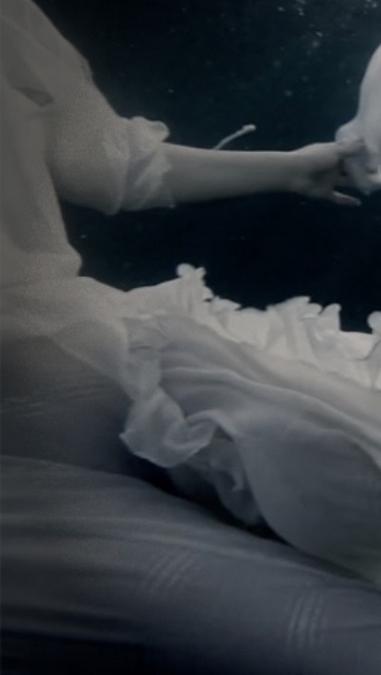
process. As a multi-disciplinary scope where any creative element can be embed and allowed. Experimental visual art is currently a cultural necessity in the sociological concept of our being. As well in our emotional matrix as well as in
our needs of identity. The term of "unity" is so contemporary in the different types of media we use. This is a matrix. Nevertheless, I sincerely believe to the meaning of travelling for learning, for discovering and adapting
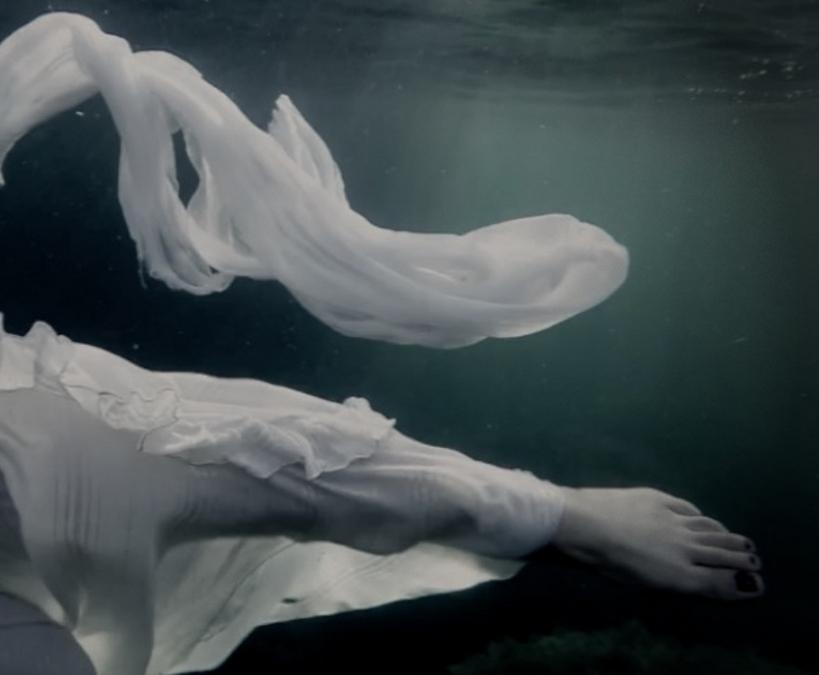
yourself in any kind of resources. This is the raw material.
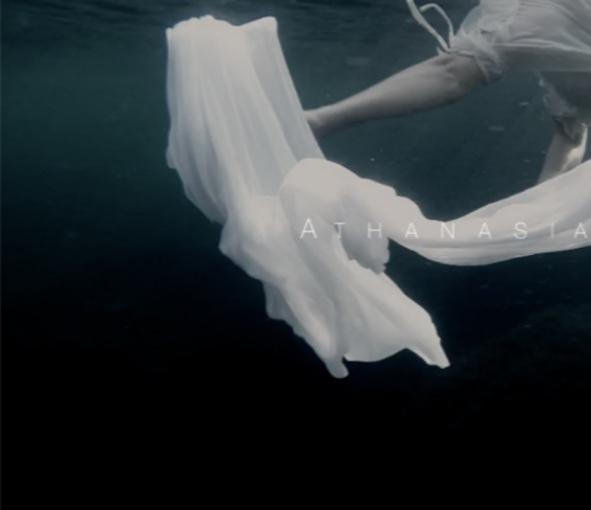
The visual codes of my projects interplay to destabilise the balance, and to balance the imbalance. From a philosophical, anthropological and psychological point of view, my work is based on the body, time and its environment. Human beings and transhumance. The microcosmic vision of a postmodern-society. Based under a process of temporality and timelessness. Where each elements are almost in shamanist relation with the subject. There, where the evolution of human being has others definitions and others laws of what is existence and nonexistence. Obviously, the interaction and connectivity worked in my films increase the flow and the potentiality of a formal structure. And obviously, the creative freedom worked in my films is linked to the instinct. These are two different ways to design, and they can lead yourself in a different result. But somehow, you don’t choose. This is the form of the project and your ideas who choose the structure of what could be the right balance. That's the paradox of freedom.
The initial idea in Athanasia's cinematographic process was to develop an unconventional experimental concept as an ocean Opera narrative. Through a organic composition as unique universe. To design a circular ergonomic comfort
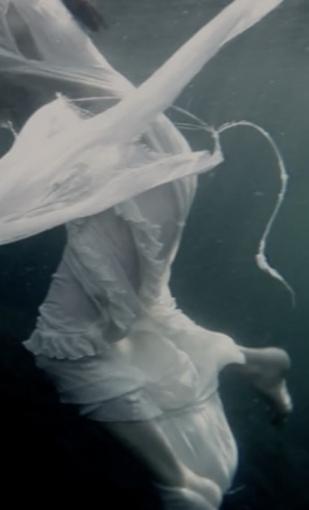
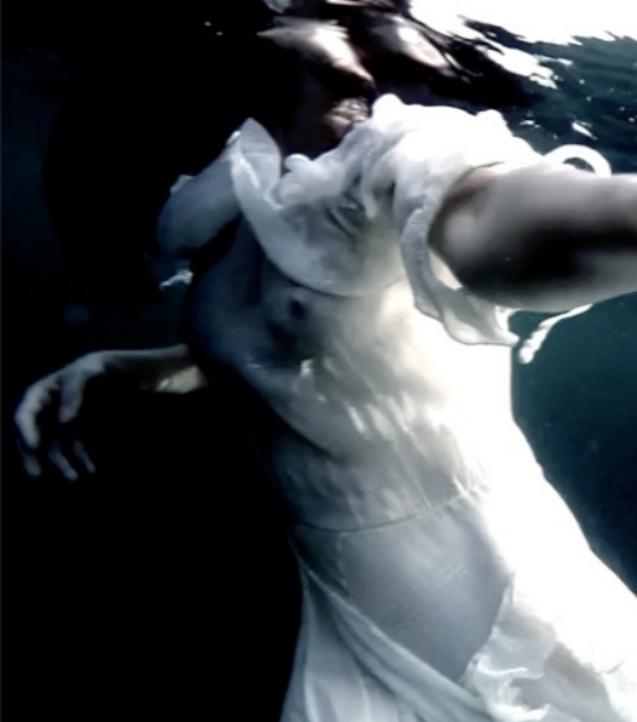

in an aerial visual architecture. After several reading of books, the research of the film synopsis became an identity. A metaphysical path. But also a principal message: “When this corruptible body has assumed its incorruptibility, and this mortal body has clothed itself with immortality (athanasia), then the word that is written will be fulfilled: Death has been engulfed in victory” (1 Corinthians 15:54).
Over my past years, I used to develop a particular aspect between the relationship of sound and image. Combining electroacoustic's and environmental sound became for me a necessary form of communication. It is a real permanent challenge to create a native and structural dialogue coming from a particular universe. A language with no words. The metaphorical use of the sound composition. Indeed, several changments has occurred into our communication's modification confirming an alteration as alphabetical definition. However, I would no position the vector over a society in itself. But over the result of its evolution. The visual logic has increased with the
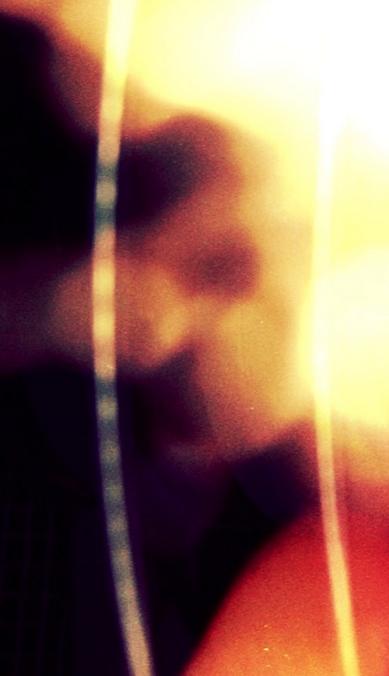
advent of internet and social networks, medias…Fred L'Epee ART Habens
The atemporal form is a rhythmic study that is unlimited raw matter to work. It

suggests a great mastery in narrative orientation and chronological interaction. The genesis of my work and film project "Fahrenheit 4.33" was to elaborate the transposition of that Time. The transcription of its timeless form in
order to decompose its architecture. To create an atmospheric matrix where there is loss of any control. The gravity of the body and psychological orientations. You are then in a metaphysical world. A static phase that

becomes antistatic. The transposition of a world shaped in another form of existence, absolutely ethereal and insubstantial. From a philosophical point of view, I could define that epiphenomenon as a fatality.
Films are a subversive and immersive process. It is a interdisciplinary medium conveying our emotions by its multidisciplinary forms and opening important gates in our current culture. Its design deliberating the simultaneous and spontaneous perspectives in perfectly consistent with our lifestyle. Especially for the viewing experience in public space. The image is an immutable human resource. Usually, visual experimentation is a transposition that changes itself into an progressive abstraction. The creation and its renaissance. Genesis. The evolution of art allows us to evolve in a total parallel. Perpetual oxygenation for our mind and body. In this impossible world, experimental visual arts allows us the possibility. The image is a force field whose experimental uses have no gravity. Paradox for a world order. The cause of a vital need of a necessity for a language and common access. Currently, this is what we seek. Social interaction and cultural connectivity are key words. Here is the art mediator.
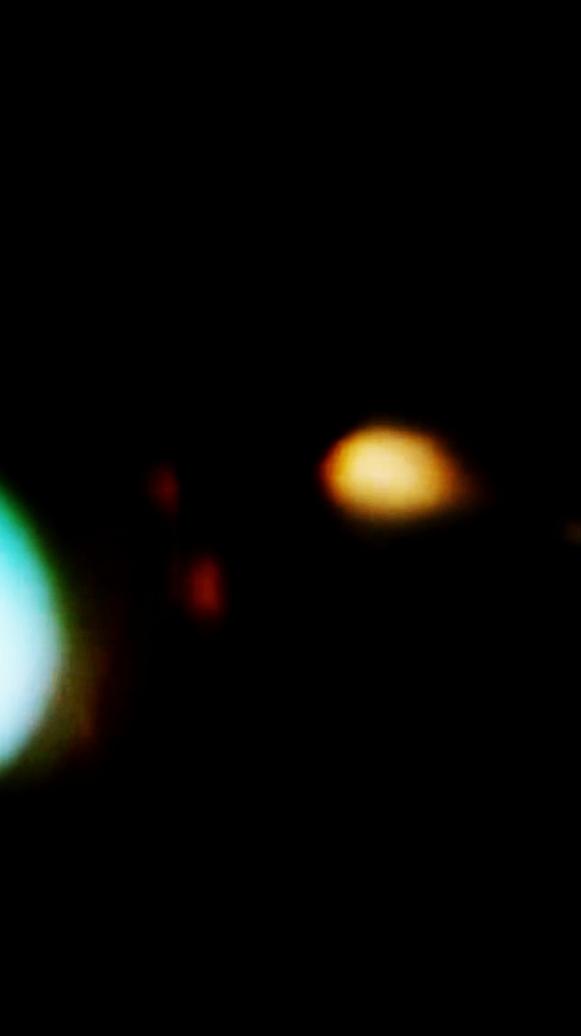
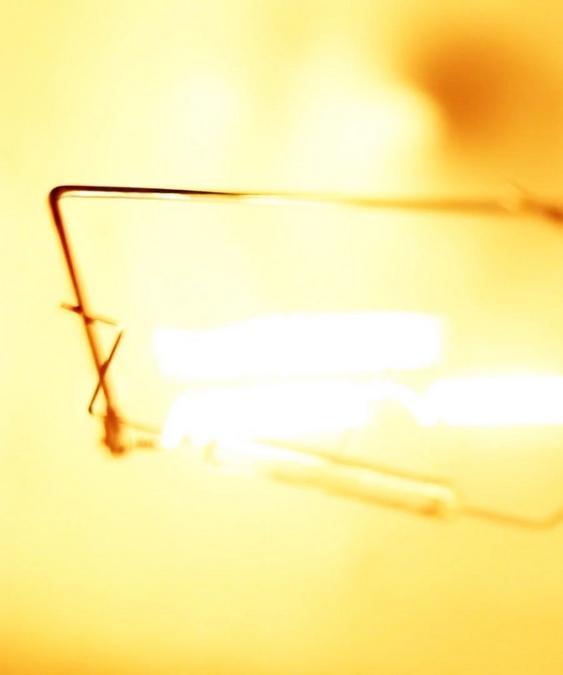

The society evolution and post-modern culture we live in is an increasingly complex. The sense and perception are keynote words. The philosophical knowledge, psychological, and anthropological are obviously the current elements to discern and to convey. The awakened consciousness of mankind in the contemporary sphere. The unity of my work is based on perception, control of action, perceptual aspects of language processing and related cognitive processes. All sensory modalities and all motor systems. These unities are a mystery of subliminal motivation as artist.
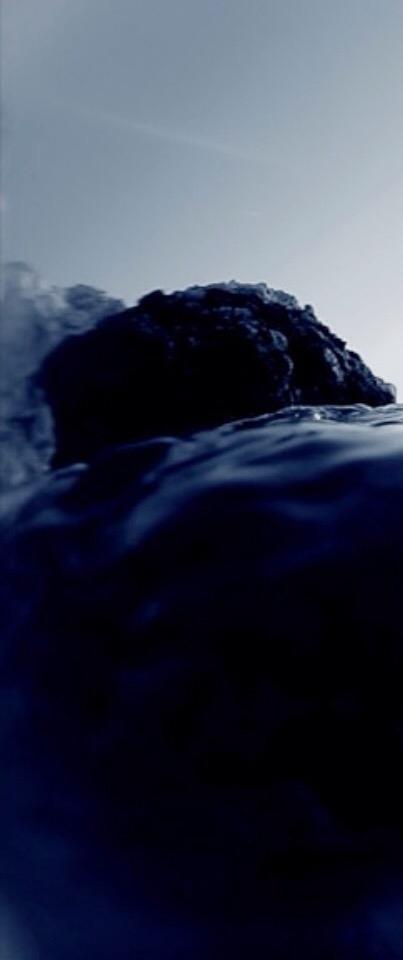


In my mind, Art does not represent in itself a strategy of public relations. I deliberately think that the crucial component of my decision-making process is absolutely free of consideration. This is an ethical code. Independence is the most appropriate way to ensure the effective positioning of the creative process. I am faithful to this vision. As the fact to conceive a mystical relationship with my audience. A communication that sometimes becomes sibylline, oracular, inexplicable. But also a convertible and correlative dialogue.
By the journey of learning. I see my work evolving by travelling, reading, writing. By evolving through various collaborations.
By human interaction in which I still believe. But for the time being, I’ve sat peacefully on the pythonic seat near the Delphic oracle.
An interview by , curator and curator



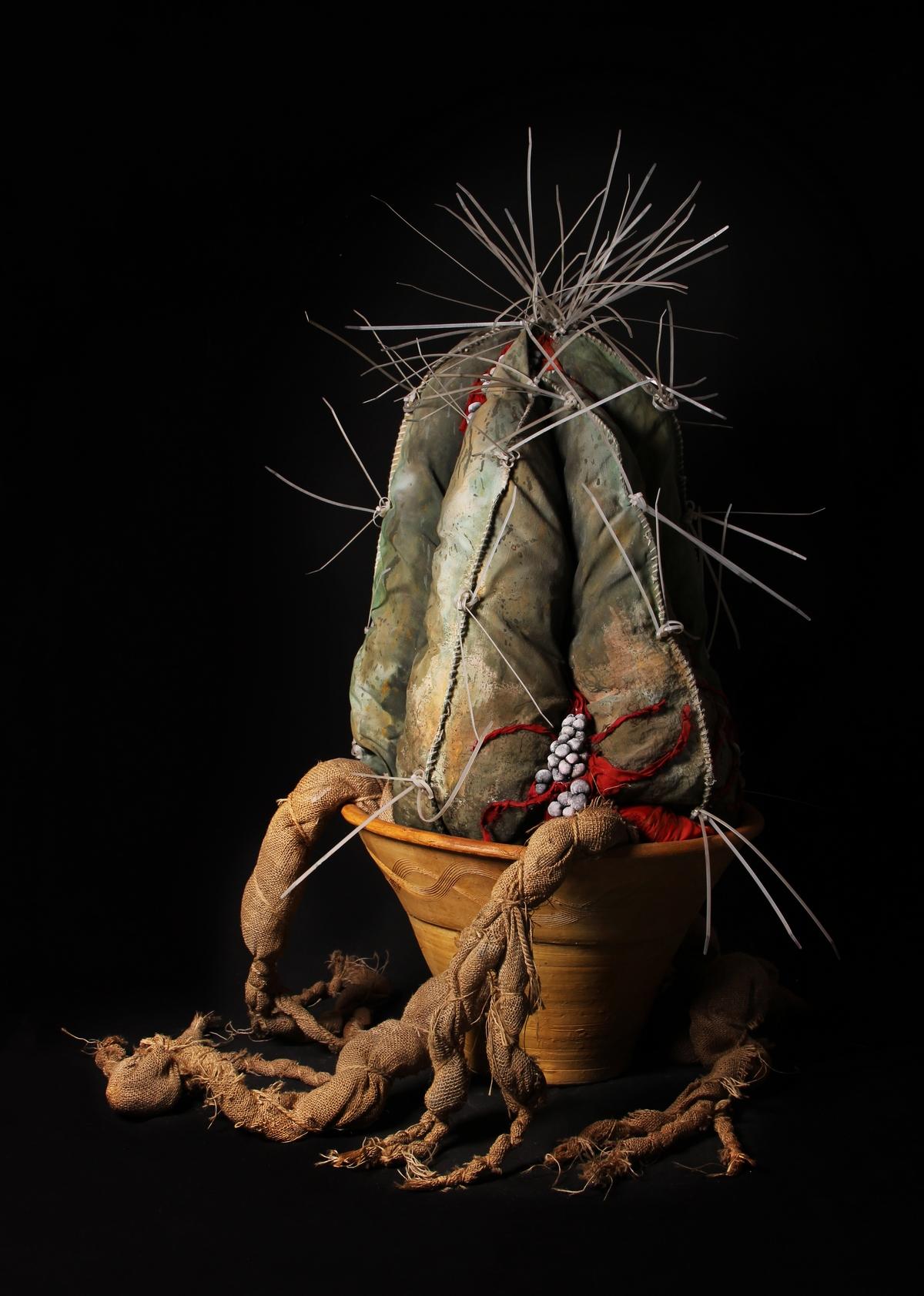 An interview by , curator and curator
An interview by , curator and curator
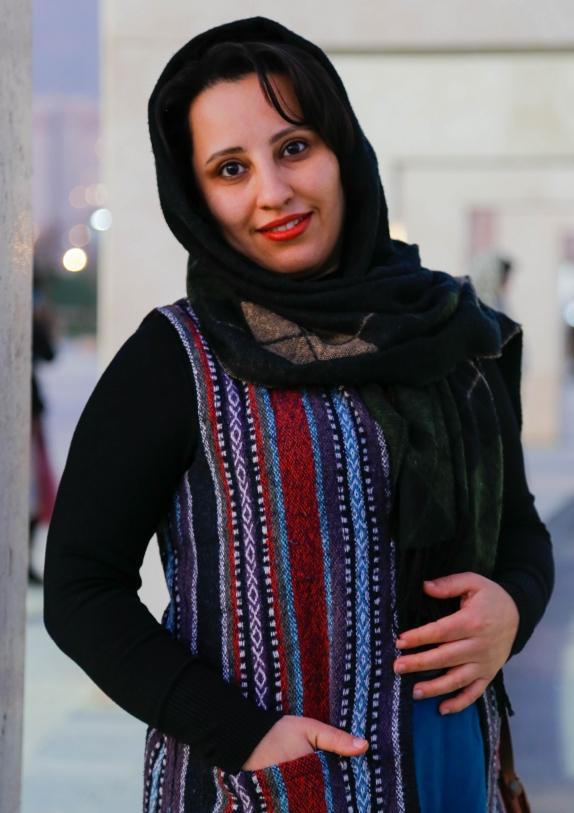
With much regards. As you can see, art in the academic context is more the act of familiarising the individual with art, and the artists with the philosophy of art, it was the same for me. Painting was my
major/ discipline for my both bachelor's and master's degree that made me drown in the world of art and to gain different experiences, which was very impactful on the creation of my recent collections. Historical and cultural backgrounds were having key roles, since.
Parisa TaghipourI have to decree about the collection of ‘Femininity’ which includes the painting that I completed during the past 5 years that they are the result of struggle between forces from my inner world with the external world. Inner world equals the sentiments, hidden vacuities, physiological pressures which were targeted unto me from my inside as a woman, and it is my own existential mind which is sometimes comes into being and some other times is repressed inside; when I talk about the outside, I mean the society and my associates which sometimes were a factor for me to demonstrate my true self and some other times a huge barrier that forced me to remain silent according to the mentioned tradition and culture. This outside world include norms
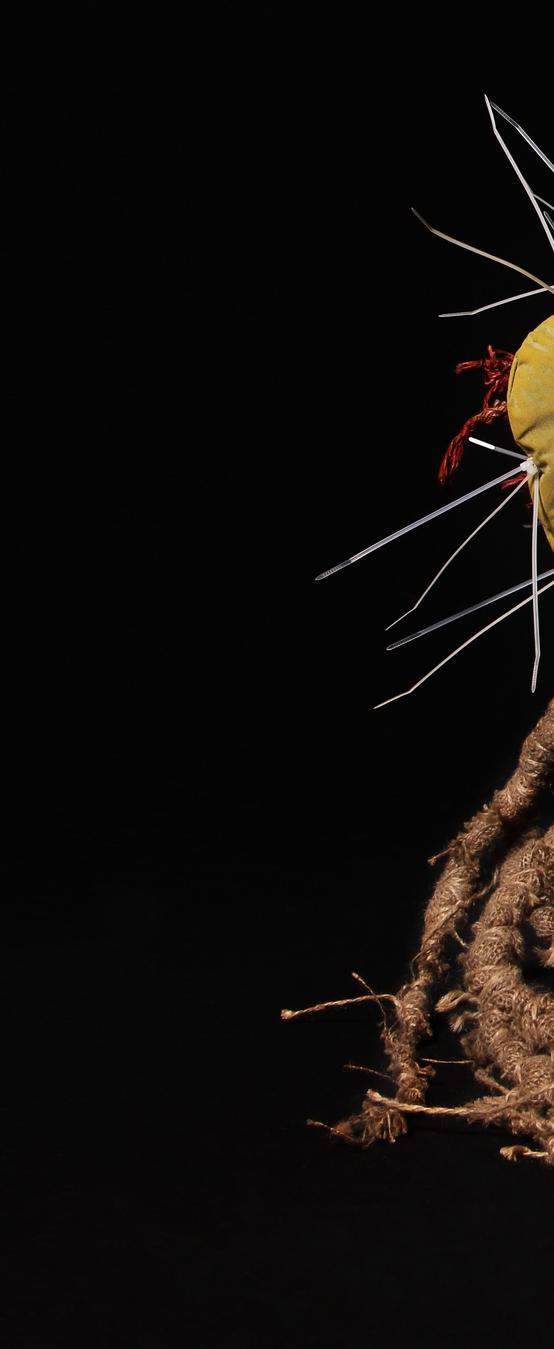
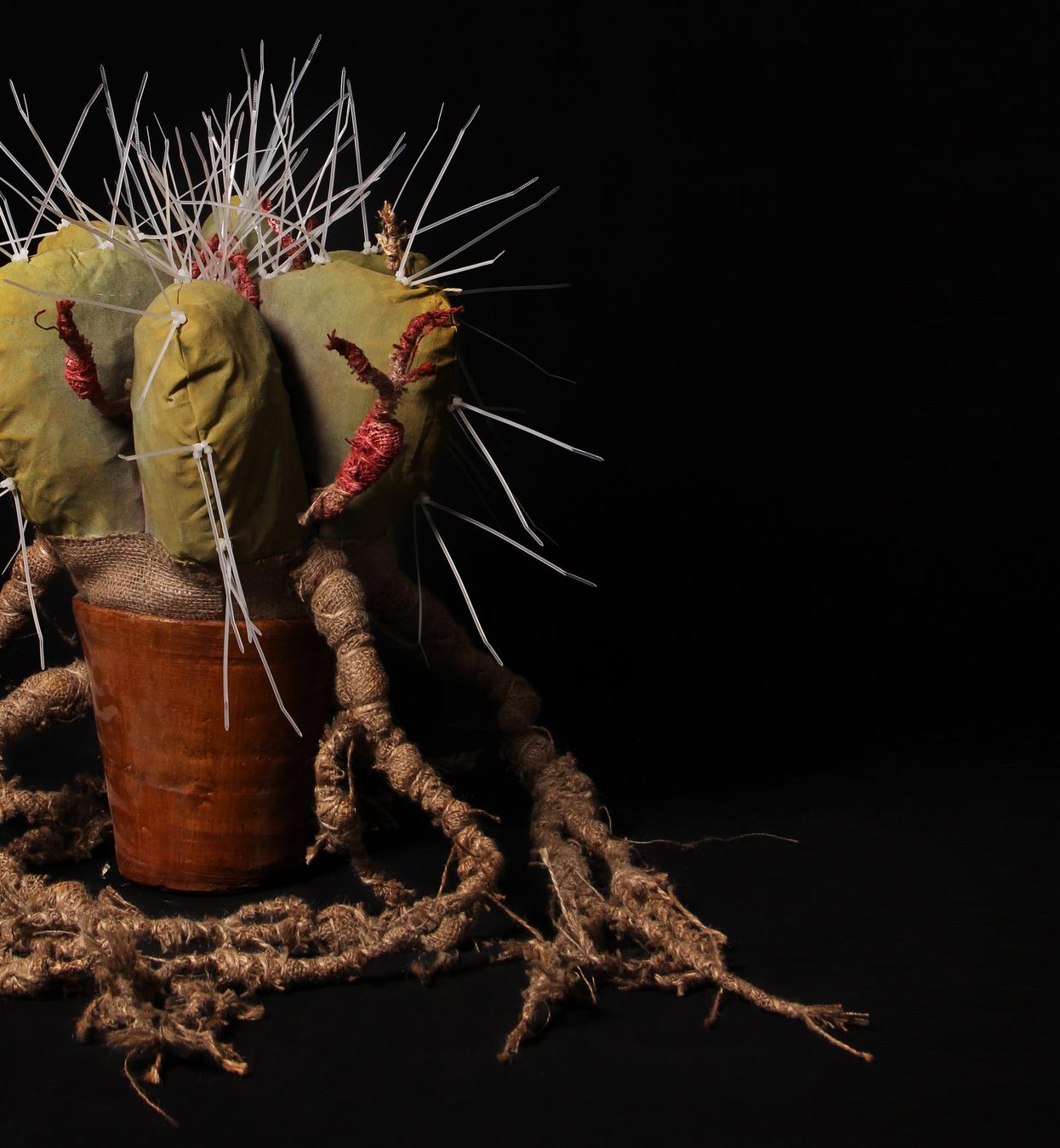

which are only a tool to repress the women and reduce them as only the second gender in my mind, this fact have gone to a long distance in which most of the women, especially those who live around me have accepted them as a type of tradition or a culture. The contradictions between my inner and outer mind goes to a large extend that have turned into a type of battle. A battle between my roots and the freedom that I demand. This is why I have hidden myself as a women in my cacti. A number of cacti that are afflicted with the same contradiction. Cacti which are battling the external factors with a soft and subtle insides in opposite to their rough appearance in the nature. In my works of painting, the hidden figures of women are merged into the external forms of the cacti.
I believe that it is the instinct that guides my paintings, focus of this instinct is on women instinct and femininity and it tends to become indirectly visible, this is the reason that I have chosen the Surrealist school for my activity: creation of a place that does not exist but it exists at the very same time.


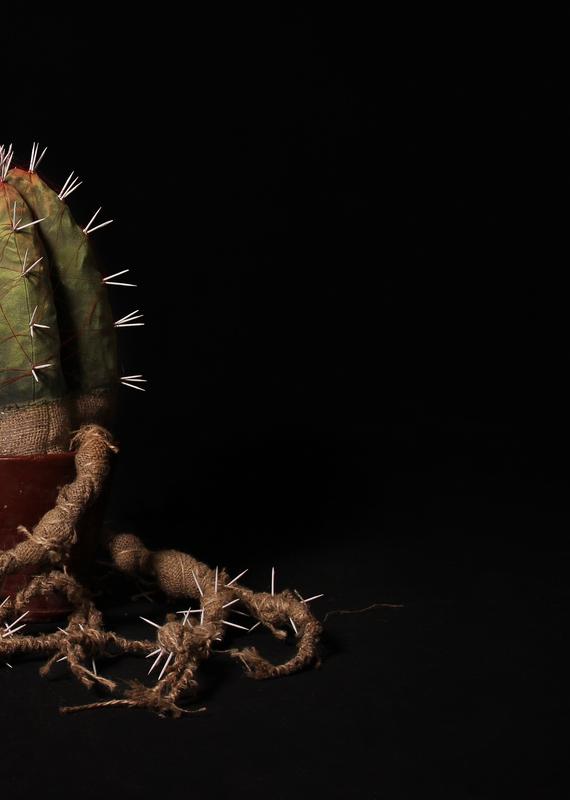
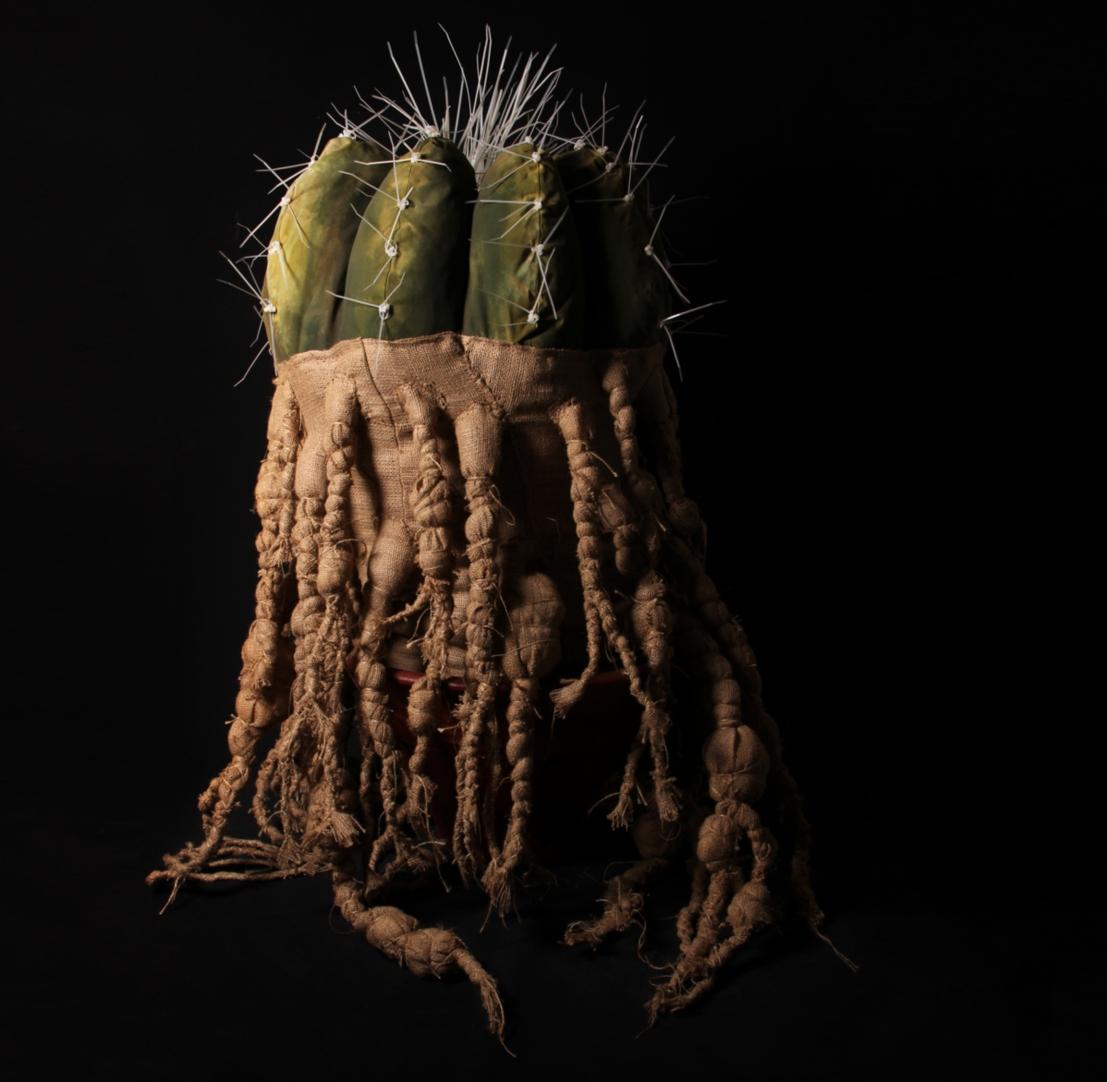
Thanks, it is so kind of you. My paintings include more sentiments and feelings in opposition to work with logic. With regard to my constant struggle with myself and
escape from the misogynist society, these images are moving persistently in the back of my mind; they randomly appear and disappear while I am dreaming in
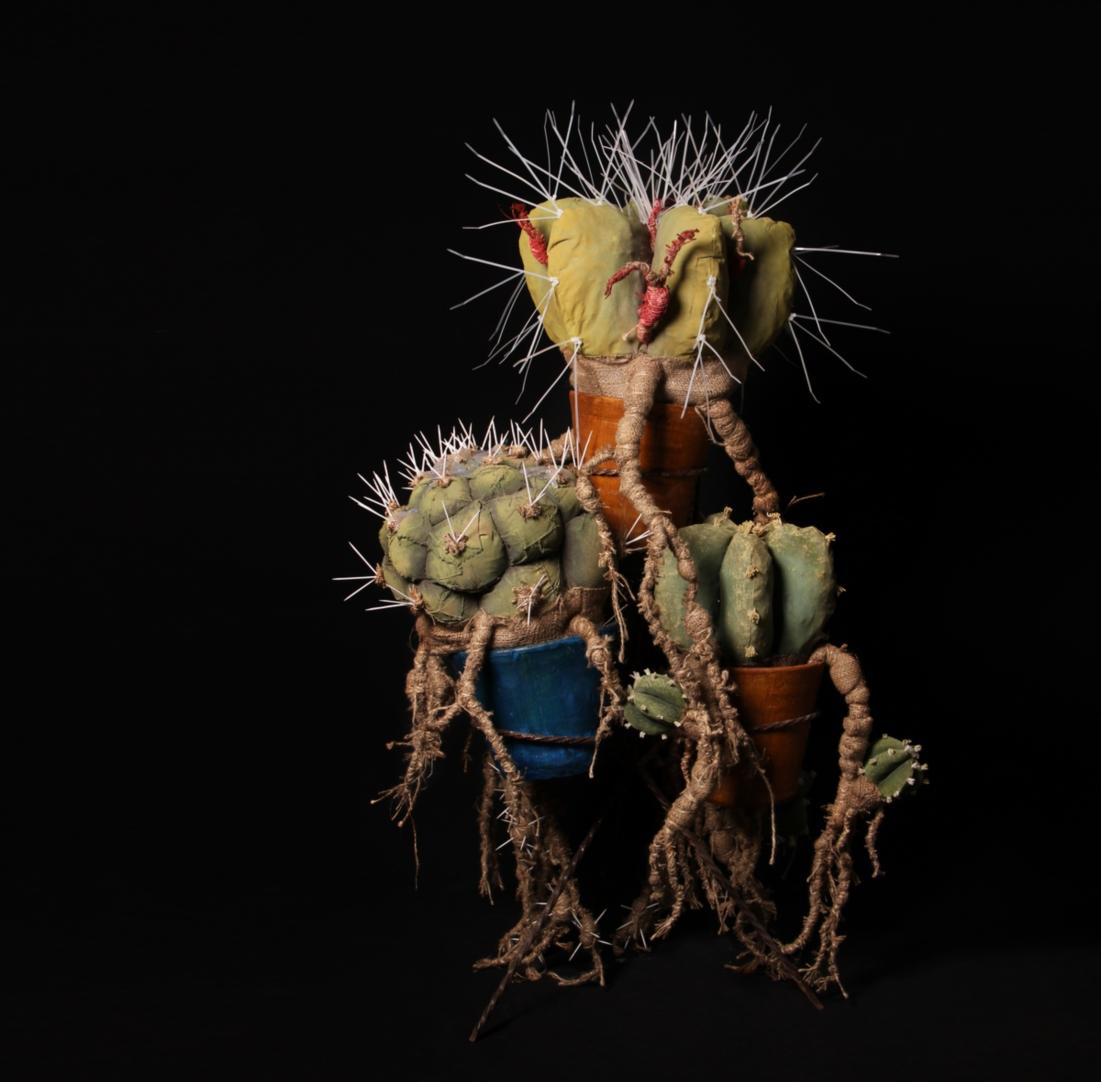

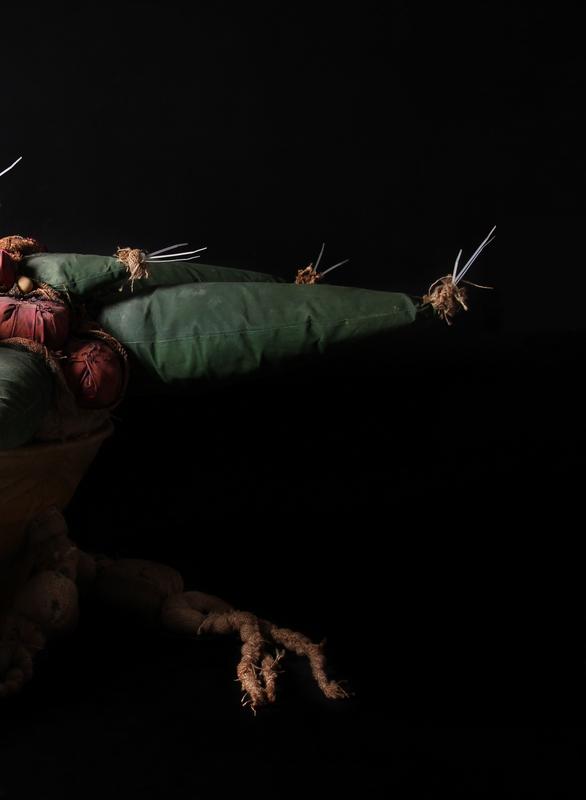

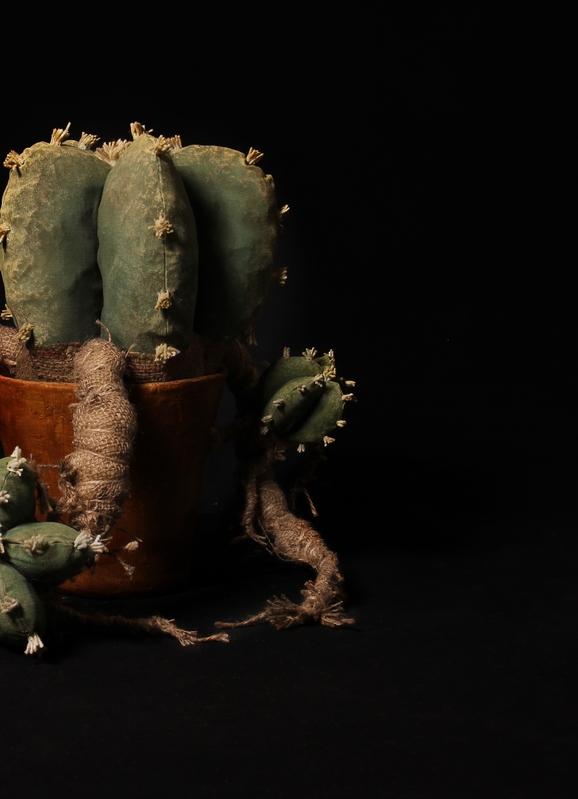
my sleep, while watching the television or eating and they finally turn into my paintings. Maybe the term intuition would be a better word for the process of their creation. Each of my paintings are formed through a long circle inside of my mind, maybe it is good for you to know that they disturb my psychological and behavioural status in a way that I am constantly integrating them to the point that I feel it is the time to perform them, of course I apply a number of immediate changes on the picture that I created on my mind while finishing them in the performance.
Yes, the theme of my works include myself, since I am a woman. You can see bit of Parisa in all of my works which show itself either implicitly or explicitly.
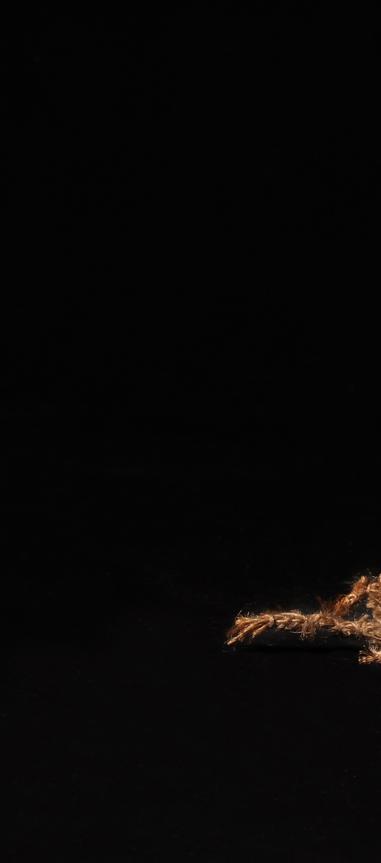

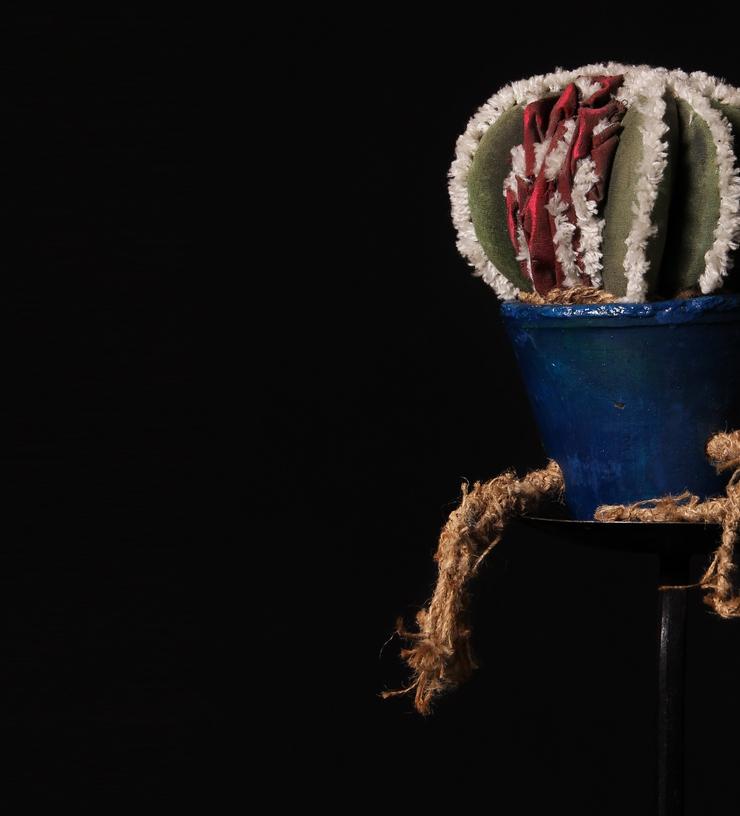
“Femminity” painting collection is not only tries to represent a woman which has roots in the history but a type who is drifting in the modern world and embower[shelter] herself in a harsh appearance lest to be harmed by this society, there were also tries to heighten this sense of aggression during the selection of material.
Some sets of my paintings are done on wooden tablets for them to take advantage of somehow tense texture of the wood and for the colors to lose their transparency by confronting this material naturally. Another collection is painted by wax oil crayons on the paper, their formation and performing process helped me in discharge my anxieties and imaginations. I have also tried to performed one of the paintings from this collection with play-Doh which is moulding substances for the kids, I am so proud of this work because the technique and form matched each other very well, and of course the concept have also progressed aligned with the form and technique. The dominant colors in the paintings usually include the
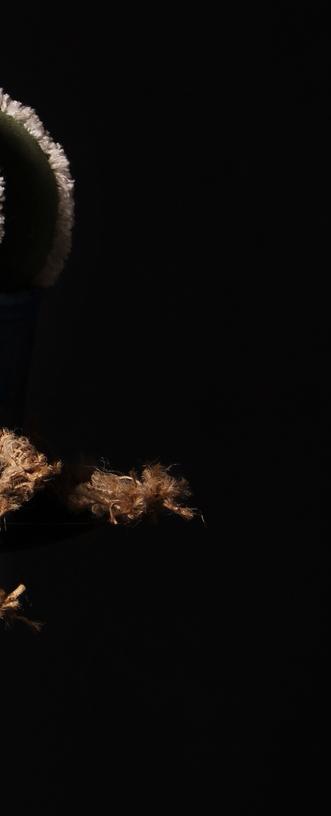
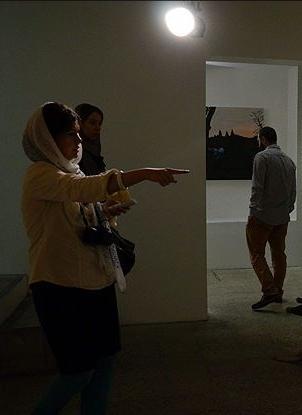


red and the green, the red color reflects the interior organs of the green cacti, and this is how my ideal spectrum of colors revolve around these two color tones.
The naming of my works also revolves around the idea of women. The femininity itself include other concepts of anger, aggression, childbirth, fear, oppression, etc.
I set the name of the collection as “Femininity” for the audience to understand all of the mentioned concepts. In the collection of ‘Goddesses’ which is a set of sculpture, names are taken from the goddesses that are present in the world mythology from across the globe. Their common aspect is the quality of fertility as they all share it.
I shuffle between the reality and the dream. The reality is my cacti which are women, this fact made them to seem unrealistic. This is the point that involve the viewer, for them to discover the concept. All of my painting or sculptures has roots from my inner mind, and of course is has to be noted that I am a woman in particular who has its own concerns and that I am generally a human which its own inner questions.
To me, it is important that the viewer start to think after
observing my works, and how they reach for even a scarce understanding of them. I put this burden on their shoulders for them to have their own personal conceptions, indeed I involve them with the hidden concepts in my works but they are not forced to reach for the main resolution because the interpretation of the audiences has a priority in this stage.
because they can easily connect with the works and they can ultimately succeed to recognize my inner feelings without any previous notice. Art will always find it own language and will communicate with its true audience.
You are welcome, I appreciate your attention and care. The collection I am currently working on is titled ‘Birth’. It include volumes of fabric which are specifically related to one of the persian literature masterpieces ‘Shahnameh’ by ‘AbolQasem Ferdowsi’ which is one of the greatest surviving works from the culture of my country, Iran. In this collection, the women who are mentioned in the poetry of Shahnameh are the subject of my sculptures.
It is only me who is present at the time of the creations of my works, and it is me who manifest and try to discharge my inner forces and pressures. I believe that the artist should play her/ himself. The audience interaction with my works was/ is very good and interesting


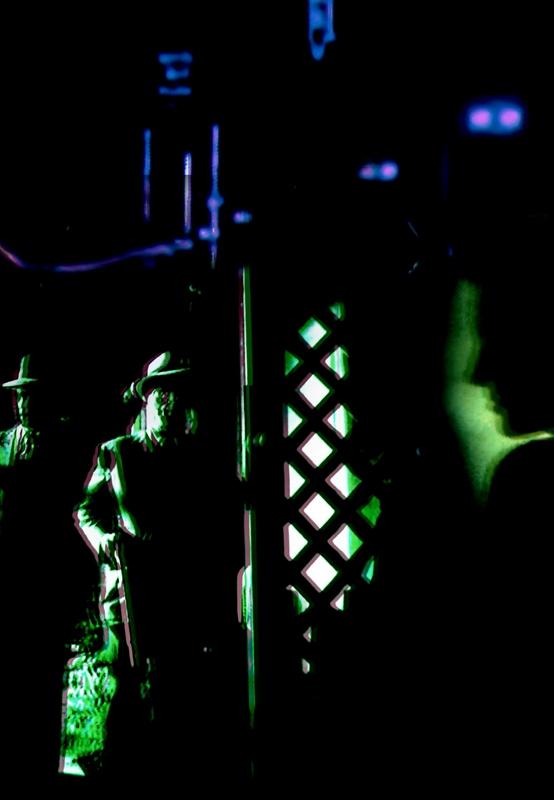

My Graduate Certificate in Design is in computer 3D Modelling and Animation and my BFA(Hons) is with film as my major. I had worked for many years in the

commercial world of film and television before attending a tertiary establishment. My ‘craft’ skills as a film editor, animator and computer effects artist were known and acknowledged in New Zealand. These skill were built up over years of making amateur films, first in 8mm and then 16mm and reading anything that I could get my hands on regarding film and especially horror film and the effects that were needed to create the illusions and, of course, watching as many films as possible. I was lucky growing up in the 1960s in New Zealand because there wasn’t a television service until 1961 and our family didn’t get a set until 1965. The NZBS followed the BBC ideal that television was there to inform, educate and entertain. There were no commercials shown on the weekend and on week days only after 5.00pm. All the informing, educating and entertaining was combined onto the one channel for the whole country so I was exposed to a whole world through television because I could watch things like The Flintstones on Friday evening, Orsen Welles’ Citizen Kane on Saturday and François Truffaut’s The 400 Blows in the Sunday World Cinema slot. Documentaries covered subjects from wild animals in Africa to digs in the Olduvai Gorge to Picasso’s methods to the PreRaphaelite Brotherhood, Lord Lichfield’s photography and the Noh theatre. I experienced all these things before I was a teenager. I say experienced because like any artform, which I believe film is, you don’t just passively observe it, it engenders an emotional response. The television content was fairly Eurocentric so that has had a strong influence on my aesthetic but living in a Pasifika environment there are influences from that culture too. We are the result of our experiences and of the prevailing cultural mores and so too is my pratice.
The move from a commercial to an academic environment came late in my career. I hoped it would allow me the time and space to make a few personal films. In the first years of my BFA that is what I did. Near the end of my second year I had completed my assignments early and the senior lecturer, John Christoffells, suggested I look into expanded cinema. This resulted in me creating an
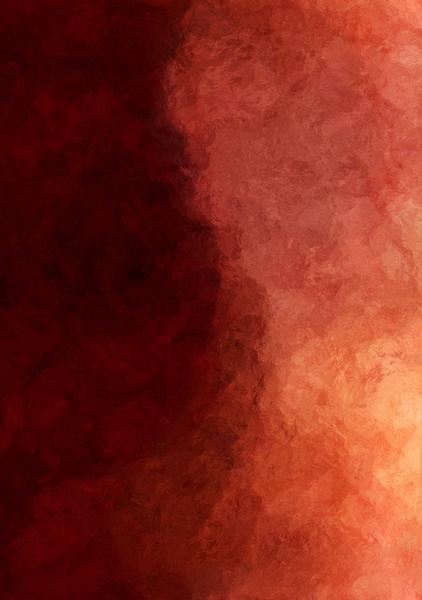
experimental installation Illusions of Motion where video was projected through rotating prisms so the image covered and moved around all four walls. The images comprised a nude descending staircase, reimagined from a very influential Marcel Duchamp and front and side views of mime walking. While the mime walking was in one place on the video screen because the screened image moved it created an
illusion of motion as did all the separate frames of the video image.
This was the beginning of my deeper research into how we create the impression of and percieve reproduced motion. My last film in my fourth year was Τερψιχόρη / Terpsichore, a hand drawn animation where dancing figures are first represented by figurative outlines and as the film
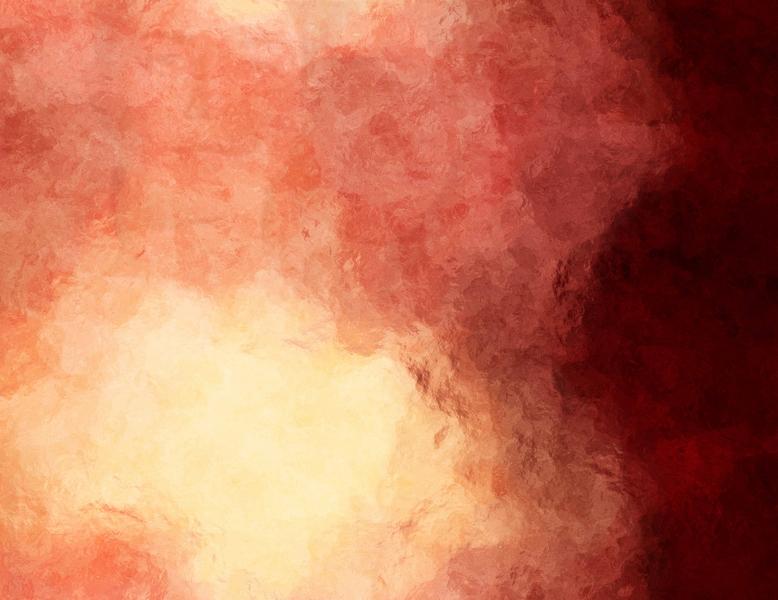
progresses the lines depicting motion become more abstract. In my fifth year I moved away from film as a narrative and mirrored vision of the world into more abstracted shapes and images and this lead to “Time Frames” the countdown leader series.
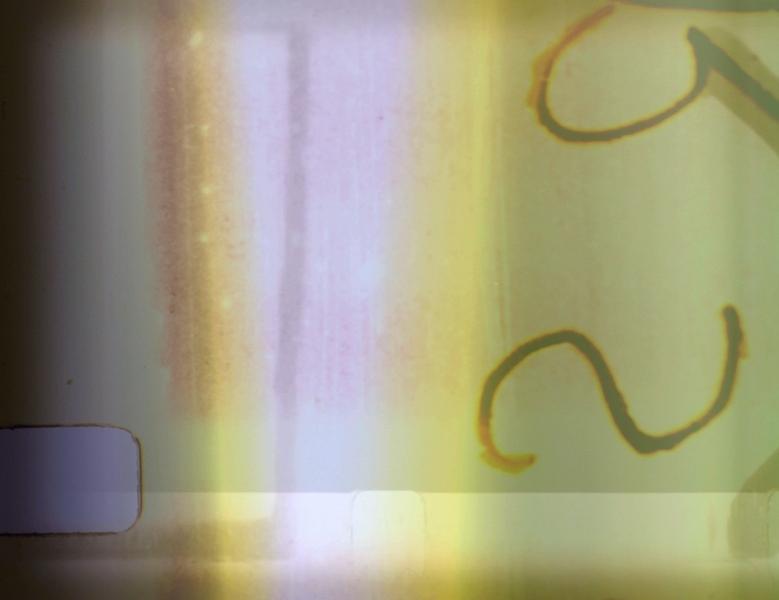
A few years ago when, as a throw away comment, someone said it’s easy to be an art photographer, you only have to take one great image but a cinematographer has to take twenty four great images a second and for as long as the scene lasts. Remembering this comment led me to take a deeper look at the individual frames that
make up a moving image and how those images work together to create “a reality”. I say “a reality” because I believe everyone has, and lives in their own “reality”, based on their perceptions of the real world. I don’t think I will ever see the real world. Perhaps the mystics have seen it and that is why they are usually perceived as mad. I’ve have a facination with ‘realities’ and would take time to look at things like the veins on a leaf or a knot in a tree and try to imagine how it felt having that branch removed and all the delicate patterns that now exist on it’s external form. I guess this is a way of explaining why, with the countdown leader series, I combined my reality of spending hours of my film editing life watching these things go past my eyes and the information each frame contained and communicated, because like a painting each mark is there for a purpose. They are not random patterns there is a specific meaning from them to a film maker, but when these frames are combined they create patterns that when played at sync sound speed they flicker past the eye so fast. I wanted to capture and to share these patterns with others, in a way to share a piece of my reality. I hope my work encourages the viewer to take more than a quick glance at my work and to take time to explore all things in the world.
The final print series Time Frames countdown leaders started as a video project of a three minute loop with the audio of a 16mm projector. The original footage was from several sources, some coloured or tinted and some monochrome. I
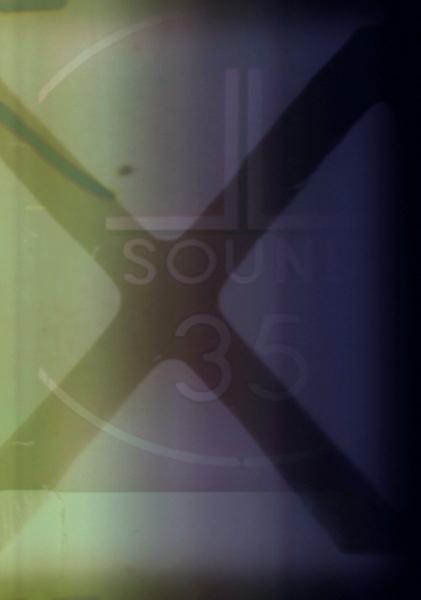
layered these in a video editing program as I had done with Persona a project I was working on at the same time. The six or seven layers are of different countdown leaders and are out of sync with each other. By adjusting the opacity settings and adding tints and mattes, using the tools of a visual effects artist, various visual interaction occurs and a new conversation created.
While working on Persona I became aware of a frame that seemed to stand out. Because of my method of layering and adjusting the video I was working almost frame by frame through the duration. I am very aware of each frames content. The visual start to Persona was a clip from Nosferatu 1922 with the movement of selected shapes coloured and layered. Well, this particular frame I thought, I would make a print from it and then after walking around the Print department I decided to have it printed on canvas. Video is usually viewed on a monitor but film is on a bright white canvas screen. I was pleased with the results. I decided to make frame prints from other videos I was working on. To me some were unsuccessful and others not so. From the initial countdown video I chose twelve frames that when printed worked for me. They exhibited the tension I was after, for me they captured the thrill of the unknown of what was to come after the countdown leader and also the wait and the anticipation. The title of the works, 1/2 a sec is because there are twelve in this series and there are twenty four frames in a second of film. During one of the critique sessions at the Fine Arts School one student said she found the countdown film unnerving because it reminded her of parents counting down from ten to allow time for their child to stop some unwelcome behaviour. This reinforced my
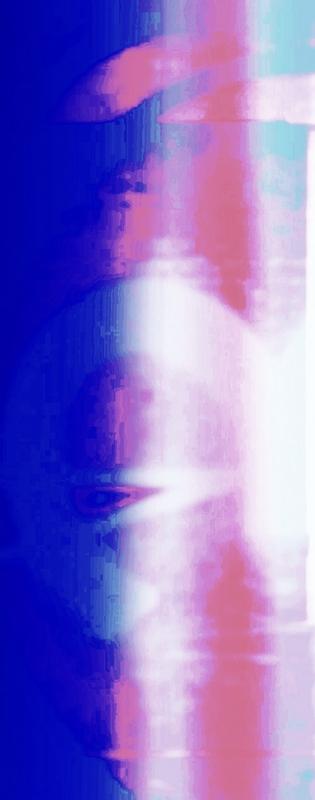
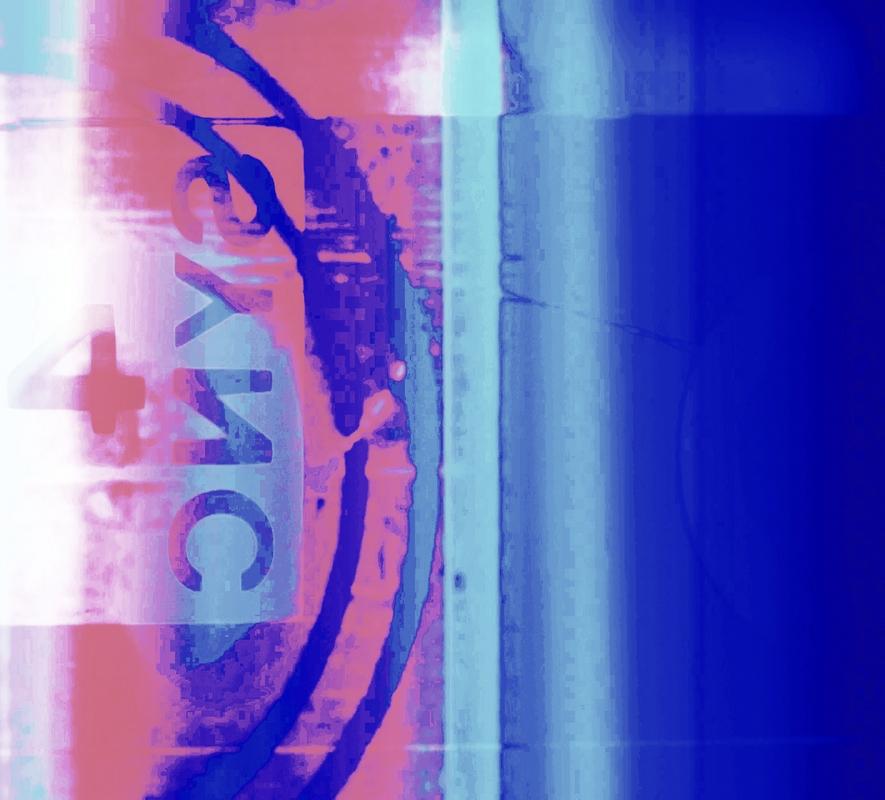
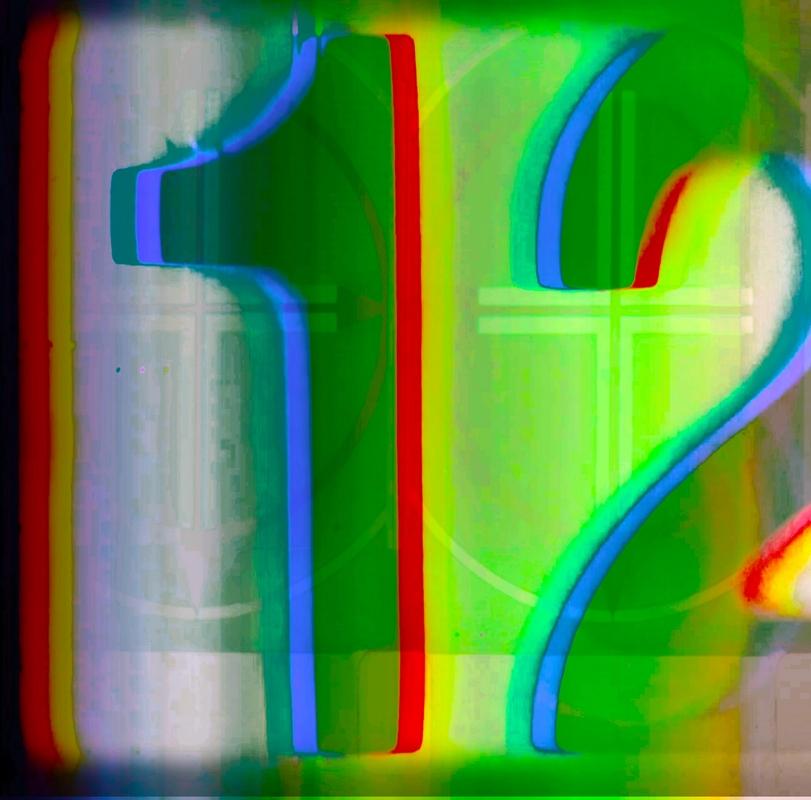
thoughts about ‘realities’ and that, no matter what I think my work portrays the viewer always will bring their own life experience into their reaction and interaction with that work.
Digital technology has certainly changed the artmaking process and I imagine not since the invention of photography has there been so many discussions and dissension of what constitutes art. Photography democratized the process of creating an accurate image, a reproduction of the world that could be distributed around the world. Digital technology allows you to do this instataneously. When it comes to image manipulation, it’s sort of what I’ve been doing all my life. First animating on film, using splitscreens, double exposures, matte paintings and with the emergence of video and digital the tools changed but not the principles. It became easy to add or subtract elements from images. In fact so easy anyone with digital device and a paint app can do it. But, just like anyone with tubes of pigment and brushes can paint and anyone can squish clay, is the final result fine art? Digital technology allows examples of artwork to be shown around the world and has also, in a way, allowed artwork to be brought out of the galleries and other locations and into your home. One can do a virtual gallery tour, admitedly its not the same as being there and this becomes problematical in the discussion of have you really seen the artwork or not. Some galleries have even entered some of their collection into the public domain. This

means anyone can take those images and manipulate them in anyway they desire and then display and use them in any way; murals. Coffee cups or T-shirts. I don’t see a big problem with this activity. If it is done with permission of the artist or owner and rather than having the artwork in storage the image is available and being looked at. It’s my belief that, just as drama isn’t just actors, a script and a set, it needs, like art that other component: the audience.
prevelant. With a copy of a painting, I’m thinking of a mechanical copy here, you don’t get the texture of the brushstrokes but, was that important to the artist or was how they used the brush only important because it created the depiction of their idea. Art isn’t art if it’s tucked away in storage. It needs to be seen, to be viewed, to be admired and thought about. Reproductions are a way of that allows a work to acheive it’s purpose of being viewed. My works are made with the intent of being seen and includes authorised reproduction.
People argue the question ‘what is art’ constantly. Just the other day I was about to enter a national Art Award Show and then read the rules that any photographic or digital work was not accepted. My first thought was this is an art show that won’t accept most of my work, or Warhol’s or even Picasso’s work. I wrote and suggested they change the name to the ---- Painting & Pencil Award Show; I think in the past there must have been arguments against moving from the rock face to skins and then to wood and then to woven cloth and how an image was placed upon the materials. Warhol destroyed or at least substantially blurred the line between commercial art and fine art. The 1960s was a time when an artwork’s object status and artistic production was up for negotiation. Greenberg’s notion of specitivity was countered by many artists and where the idea was more important than the physical manifestation of that idea. The emphasis on a work being the original is still
My work in film/video where light sensitve chemicals are adhered to a plastic strip or a strip with magnetized particles is the original. The viewers only ever see a copy. That copy is a visualisation of my ideas. I believe that authenticity is not in one material object. My work Phoebe 16031 has been exhibited on different media; in Munich on photo paper, London and Miami on a large digital monitor and exhibited in Auckland as a print on canvas. Each manifestation, for want of a better word, is authentic and real. This is because I approved of the final work. For the countdown leader series the images are printed on canvas as a way to replicate, as much as possible, the pathway of films viewed in the cinema a few decades ago. First the image was captured by the reaction of chemicals to light, on a strip of film. The chemical structure changed and the minute crystals formed created colour and texture. When the negative film is printed, again by a photo-chemical reaction, onto a positive print film there is


additional texture. The image, with all this texture, is projected onto a large canvas screen. This screen also has texture from the warp and weft of the fabric. Most of these intrinsic visual textures, which bring an extra layer of life and motion to film, are absent from the modern digital cinema. For those reasons this series will only be printed on canvas.
installation of summer forest and bird song in the lane. It engended such a wonderful warming feeling. It may be an interesting experiment, if it hasn’t been done, to have department store muzak played throughout an art gallery to see the effect it would have on patrons.
The shift may have occured with the advent of the alphabet but humans seem to be designed early on with a bias to vision as a survival tool. A visual logic sets up series of relationships that develop a sense of image cohesiveness and comprehension. A recognition of colour and shape of friend or enemy is essential. This need means the memory stores those important element leading through to pareidolia, that is, seeing recognizable objects or specific patterns in otherwise random or unrelated objects or patterns. The brain trying to make sense of the world. The visual has always been primary to me. In film and video production the sound is usually added to the picture. Sound and images can work very well together either in sync or contrapunctionally. Video works without sound as do other visual arts. Music and sound scapes work without specific visuals. When combined these two elements can create an incredible emotional response from the audience. I haven’t experienced a gallery where music or sound is used except for specific installations. Some years ago, my son lived at the rear of a small decaying Victorian (1880s) industrial red brick lane. One winter there was a sound
The tools may have changed but I don’t think the role of the artist has changed. All art is political, but then all life is political. Those with a strong political bent, with the new global communications, may have a louder voice. Artists will always create innovative works and build on and recontextualize what already exists. My work is all recontextualized images. For my latest work instead of using existing images I have shot the video, that I will digitally manipulate,myself. New media can negate the need for lithographic stones and silk screens for the reproduction of artwork but it won’t take away the use of those tools by artists. I do think the role of the viewer has changed. They no longer need to always be the passive observer. With new media they could easily watch the process and interact with the artist during the creation, perhaps even critique or instruct. This interaction problematizes the concept of originality and even the artist’s original concept. New
media art takes advantage of and is formed, to a certain extent, by the technological requirements of electronic media. Work can be created and viewed or heard internationally by thousands, millions within seconds of it being entered onto any digital service.
I intend my art to be viewed so an audience is important but at the same time so is my
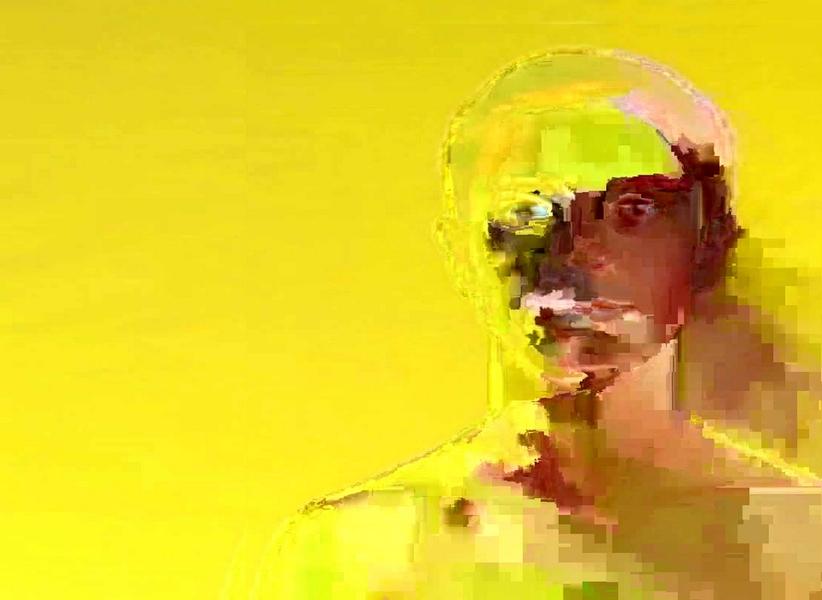
aesthetic. I must have an image that satisfies me. The elements must have a visual relationship that creates an internal cohesiveness and integrity so the final image is aesthetically comprehendable by the spectator.
I say aesthetically comprehendable because the understanding of an artwork by a viewer will instictively be based on their world perceptions. They will bring their interpretion to the piece. Colour associations may be similar nationally but not internationally. Red is a colour of

danger or passion in Western Europe, wealth and prosperity in India, mourning in South Africa and the land in Australia. In my work I’m not trying to make a left wing or right wing political statement but I guess I am saying stop and look. Look close and marvel and enjoy what you can see whether it is on the canvas or a result of pareidolia.
With the 1/2 a Sec works I am stopping time so the viewer can observe something they haven’t seen before or if they have it would have only been for 1/48 of a second. I’m making it easy for them.
I often get sidetracked from my main interest. There are a couple of Mondrianesque abstracts and there are 10 pieces retelling the story of Orpheus and Eurydice in a film noir setting but my main aim is continuing the investigation into motion and the depiction of motion I started with in Illusions of Motion. I started with animating objects early in my career, creating the illusion of self movement and now I am devolving into creating still images from moving objects.
I think it was Canadian Film Board animator Norman McLaren, who said animation is the thing that happens between the frames of film. I am attempting to show what happens between the frames.
Lives in Fort Saskatchewan, Alberta, Canada and works in both Edmonton and Fort Saskatchewan
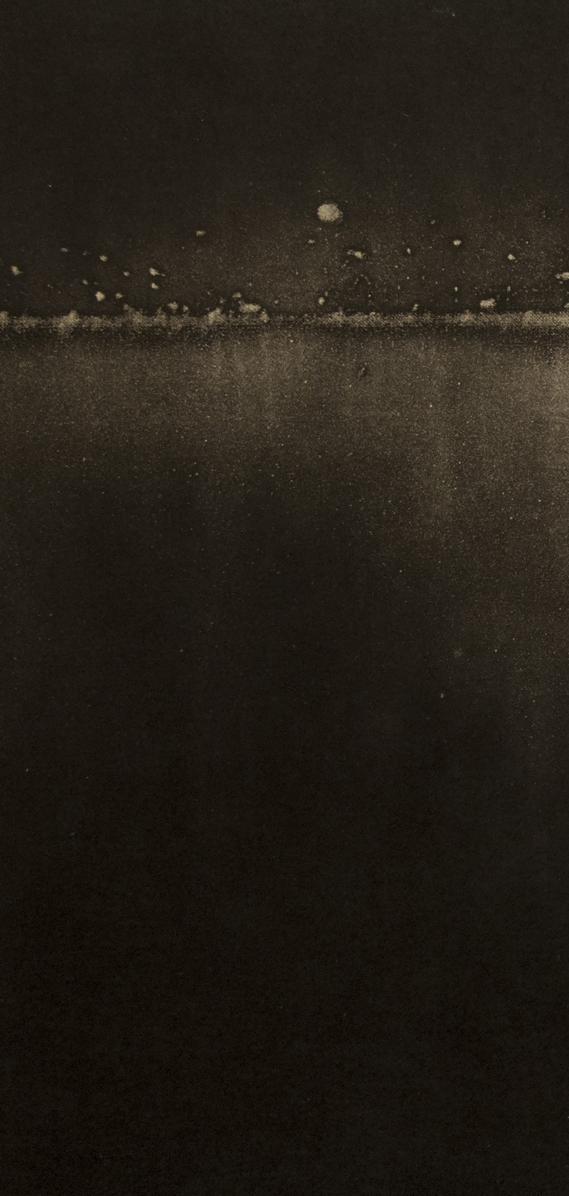

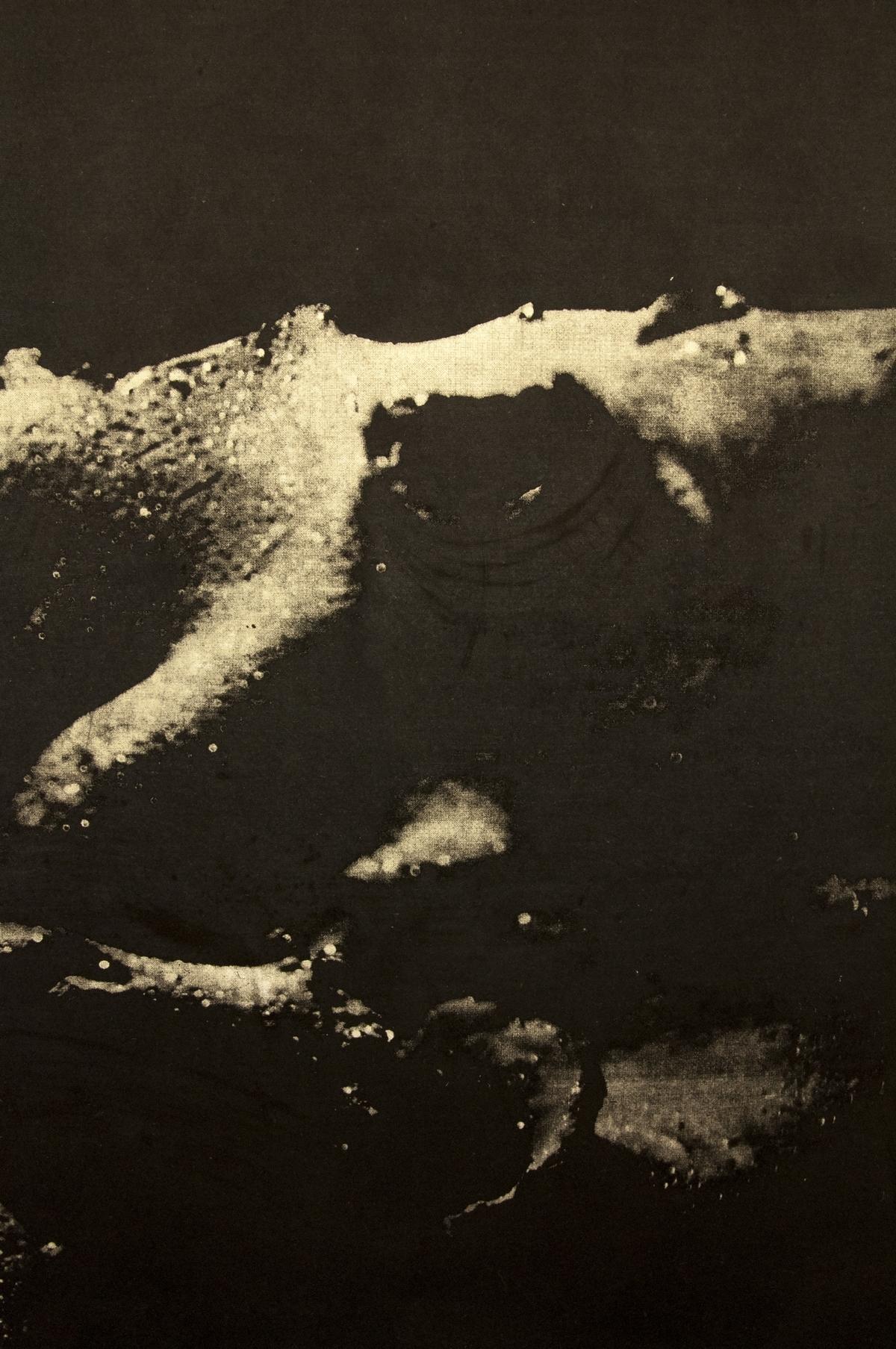
First of all, thank you for inviting me to be a part of this. For experiences that influence me I think that would be my overall thought process; the way I take in information and then how I imagine other ideas in response,
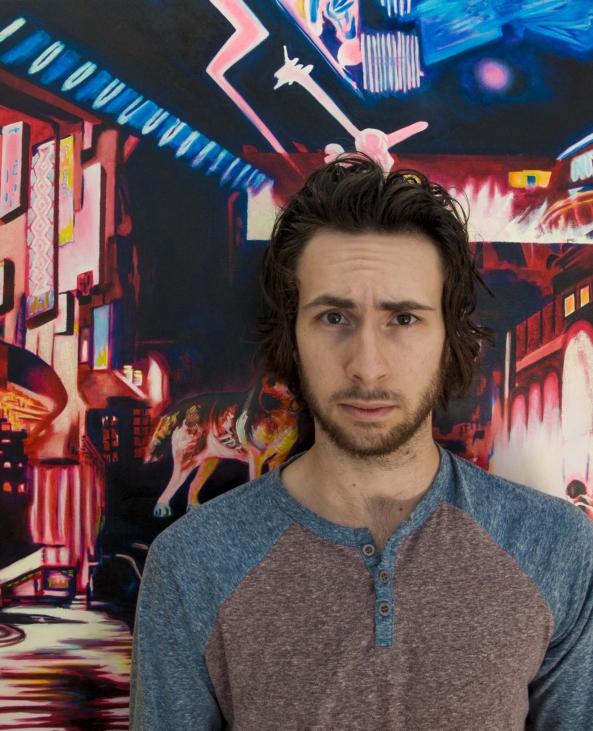
both consciously and unconsciously, and how they start to merge and intersect, forming entirely new conclusions. Another influence, which has ended up pertaining mostly to my print work is my experience with the ocean and scuba diving. Being from the middle of Alberta, I didn't have much firsthand experience and exposure to the ocean, so when I learned to scuba dive, it opened me up to a conscious awareness of space and the idea of the oceans vast and mysterious nature.
I don't think a multidisciplinary approach in necessarily the only way the explore my ideas but I definitely thinks it is the better way. Each medium I utilize puts me in a different headspace as I can work very differently depending on the process. I also don't think I've reached a point where any medium as been exhausted to me yet. If something isn't working I switch to another medium and more often than not new ideas and inspiration arrive if I continuously shift mediums.
My process began with just experimentation to find a starting
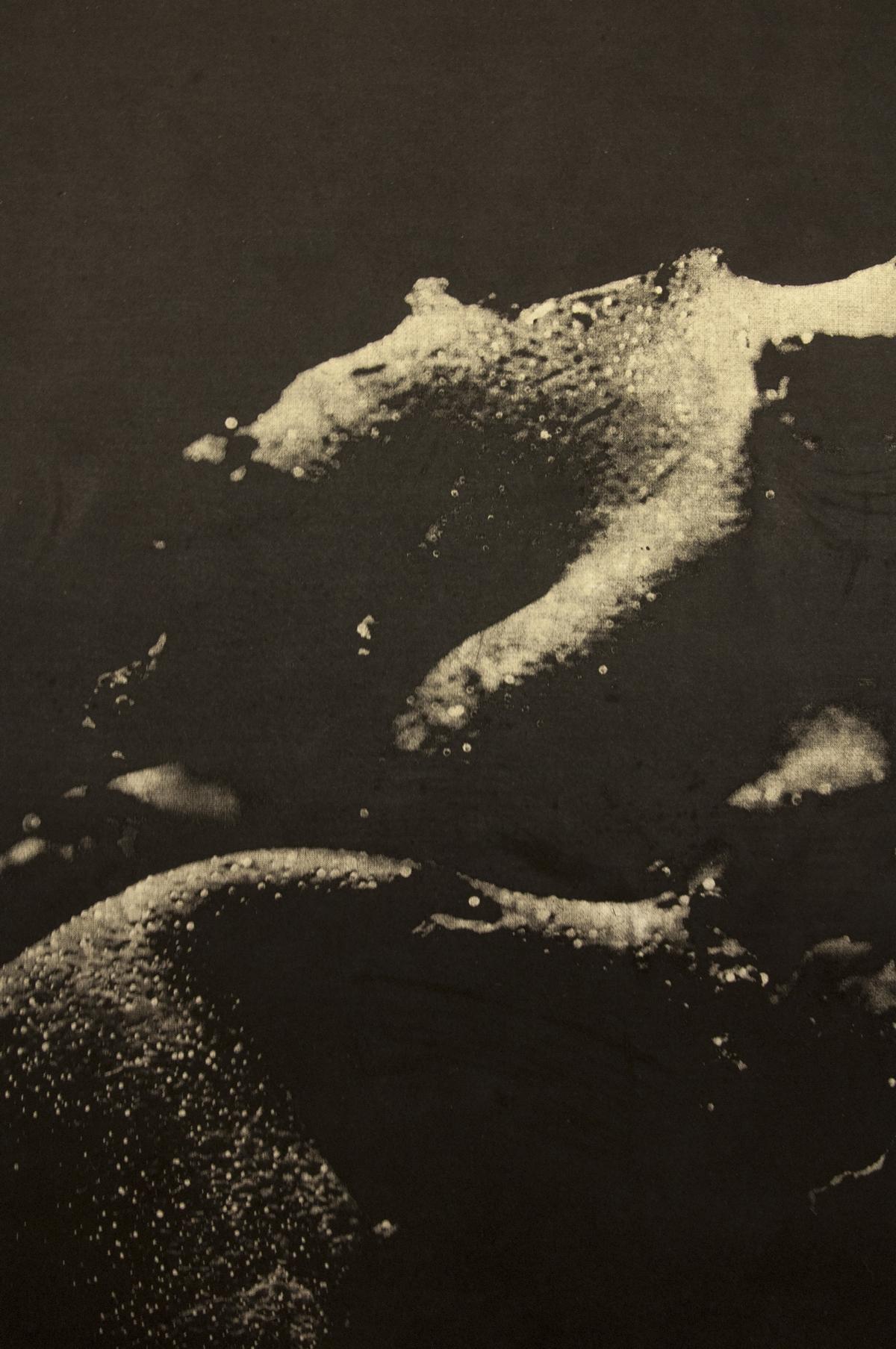
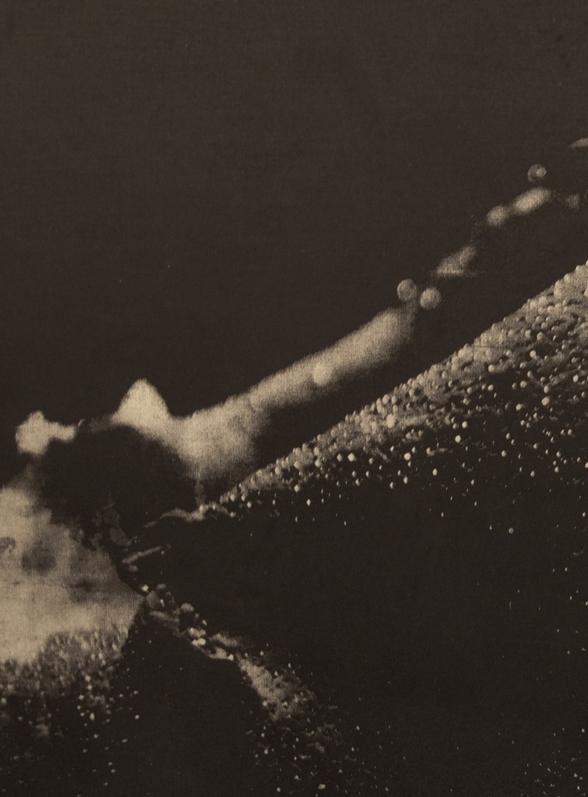

point. I filled a fish tank with water and dropped in various objects and materials and play with different light scheme, then photographed the results. Some of the material used included tin foil (Sentience from dark Matter) and plasticine (Nature of Dark Matter, Beyond the Event Horizon). After that I started cropping and merging various photos together for interesting results. My initial intention afterwards was to do full photointaglio prints but with problems with the process at large scale forced further experimentation and I started incorporating etching and aquatint processes to fix the problem areas or add new elements.
Yes and no, I like the idea of viewers recognizing or interpreting symbols and ideas but I'm not trying to implement intentionally specific ones. At best I want some very broad symbols
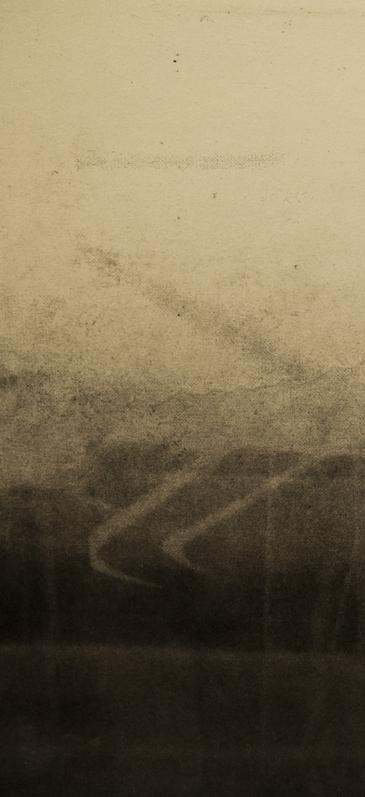

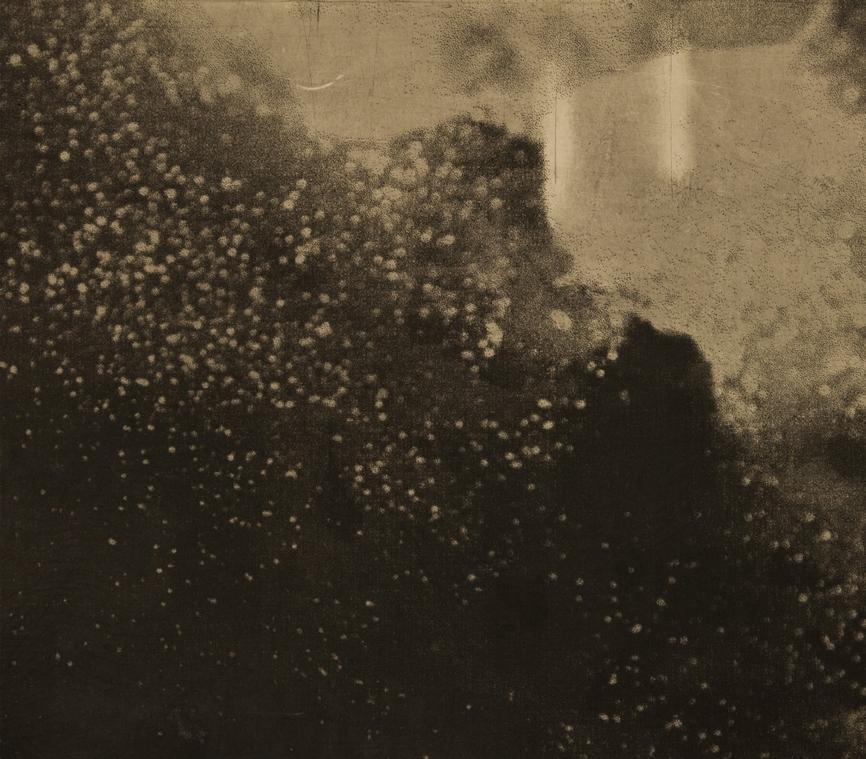
and ideas laid into my work. I'm more interested in the viewer recognizing and building various conclusions. The viewers are going to engage my works with numerous thoughts anyways, so I want to create as broad afield as I can to let them build with.
This relationship, for me, is one of balance; where images are neither fully real or completely made up. I think using elements of both and having them interact with each other is the best representation of how people think (or at least how I do), with images overlapping and intersecting with each other.
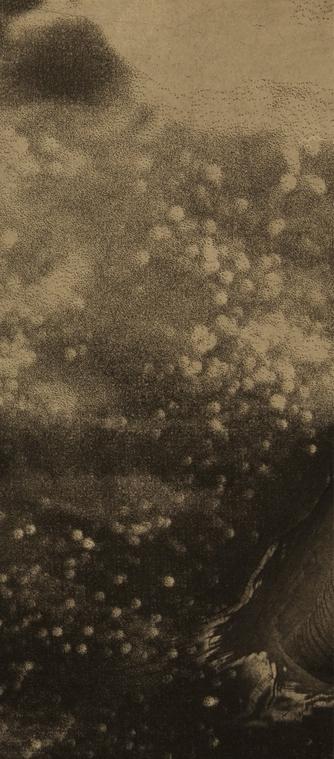
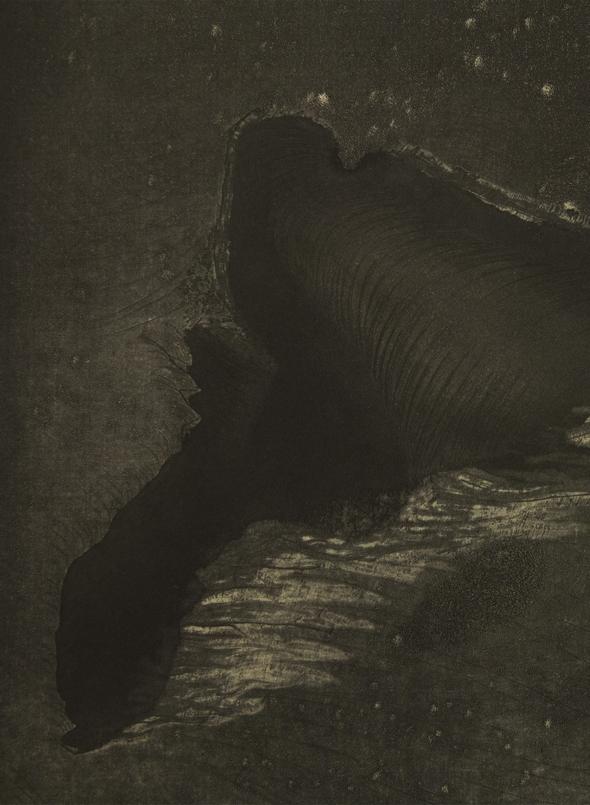
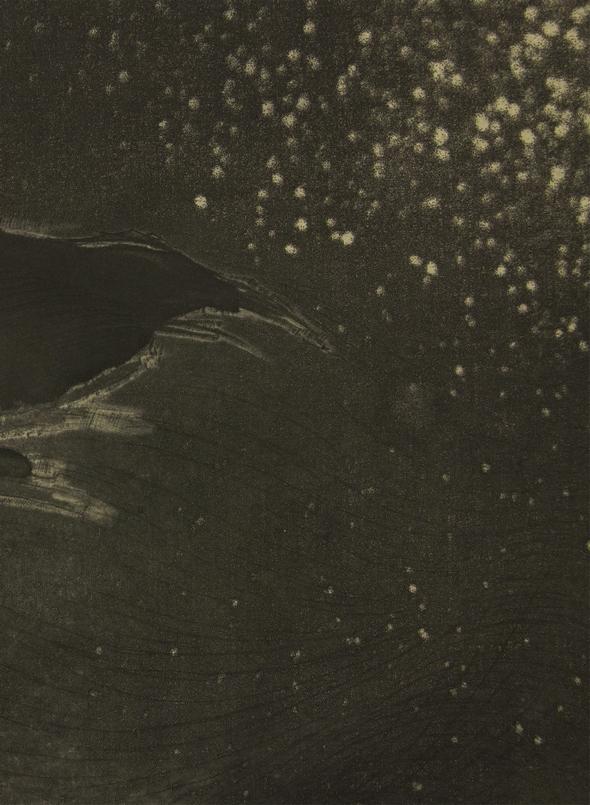

I always try to create or convey a sense of space and environment in my work. It's something I consider important because being able to immerse yourself in the piece is integral to connecting with it. The more you can enter the piece, the more you can notice the smaller details and those little moments that make a work special. And I think hiding or obscuring; creating this sense of mystery also helps further entice the viewer to explore the space, which was the case for Nature of Dark Matter; these hidden areas embedded in the environment and ready to explore.
I consider it very important that the viewer brings in their own viewpoints and experiences in looking at my work. I realized that no matter how specific an artist tries to make a piece of work fit a concept, the viewers with all interpret it in their own ways. Bring their own experience and knowledge into the works' interpretation and draw different conclusions from it. Also, I feel that if a piece of work is so straight forward that everyone can derive the same idea from it, it loses the quality and intrigue needed to make it memorable.
I think photography has become an important part of art because it works as both a medium on its
own and as a tool for other mediums. For this body of work, using photography as a tool was important as a starting point for me. It allowed for really open experimentation with imagery that could move in different places, and also opened up for the idea of factual and imagined pieces.
Yes, I think the idea of the audience's reception to my work has influenced how I create an image; about what to incorporate and how much. I want to give basic guidelines and push them towards certain areas of thought, but never give an exact idea. I try
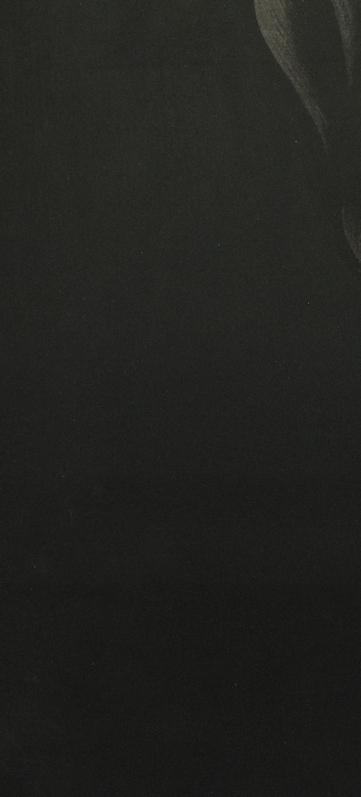

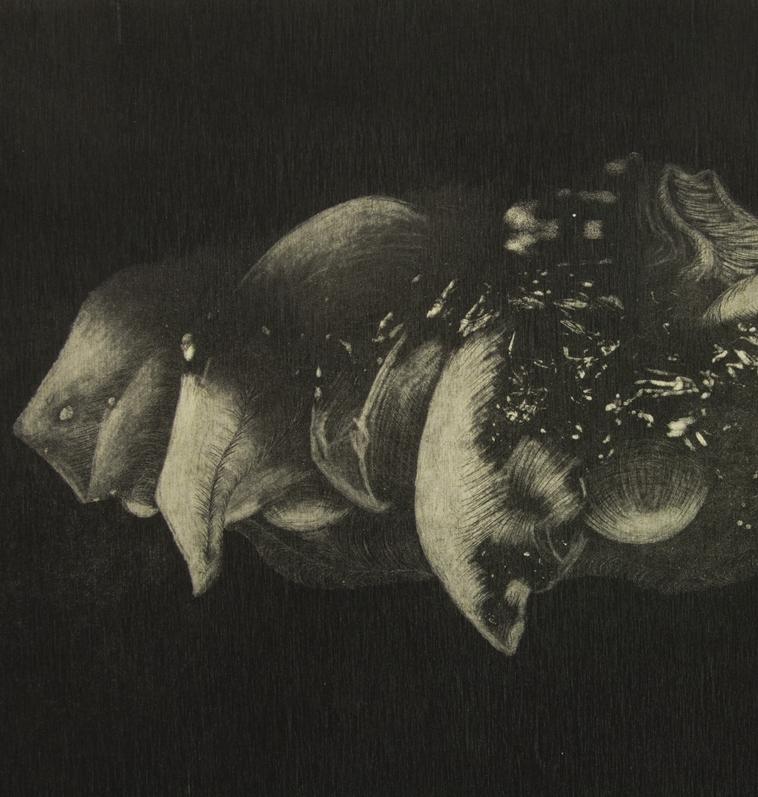
to avoid putting too straightforward a path for the viewer to follow or to many specifically recognizable elements that could stifle their imaginations. I want to give them something that is at least partly open ended so that the viewer has a ability and place to impart their own conceptions into the work. I feel that if I give the viewer all the information then they don't have a chance to truly engage with the work and they end up walking away unaffected.
It is hard to say exactly , but i think my goal would be to continue to work with and refine these ideas of space and form and by creating them through the use of representational and abstract elements with multiple mediums.
An interview by , curator and curator


Lives and works in Teheran, Iran

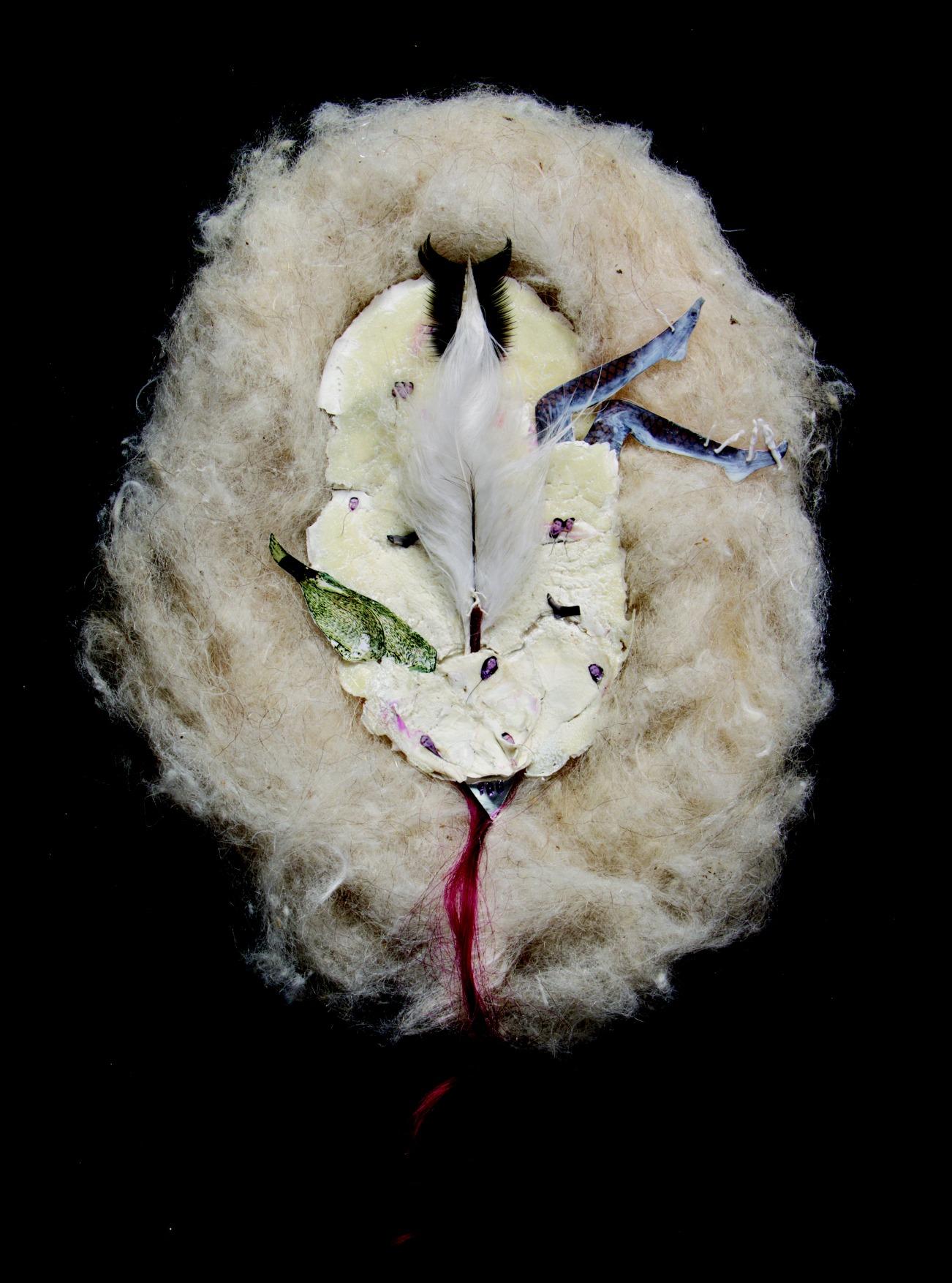
Hello abens! I am very happy to have this opportunity. To begin with, I remember when I was studying Graphic Design at Tehran University of Art, my professors used to tell me I’d better pursue a career in painting rather than one in Graphic Design. This encouraged me to try the new medium, which finally made for my doing an MA in painting. I
was, of course, into drawing since the years in art school, and I took drawing courses outside the university when I was studying for BA and MA. Those trainings were very useful. When I started to paint, I immediately realized how easily and clearly I could get my ideas across through this medium. However, because of the sexual content of my works, and because universities, and my country in general, are very restricted, I could not present my works in an academic context. The Persian roots of my works are just there. The cultural and social roots and also the Persian aesthetic that is evident in the works of Middle-Eastern artists, are not explicitly and formally seen in my works. But, down deep, under Iran’s cultural
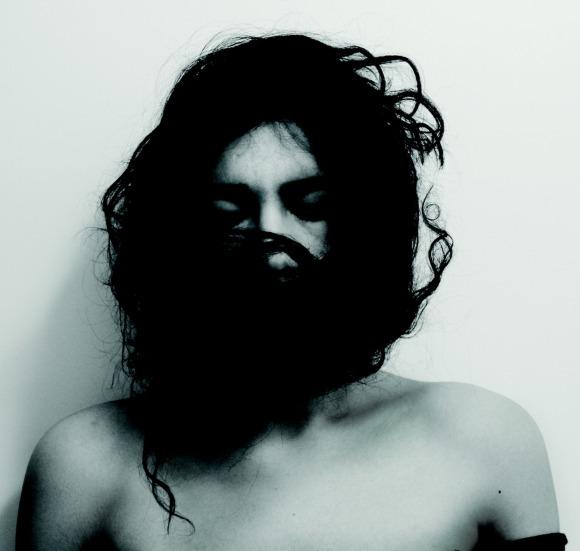 Mahsa Merci
Mahsa Merci
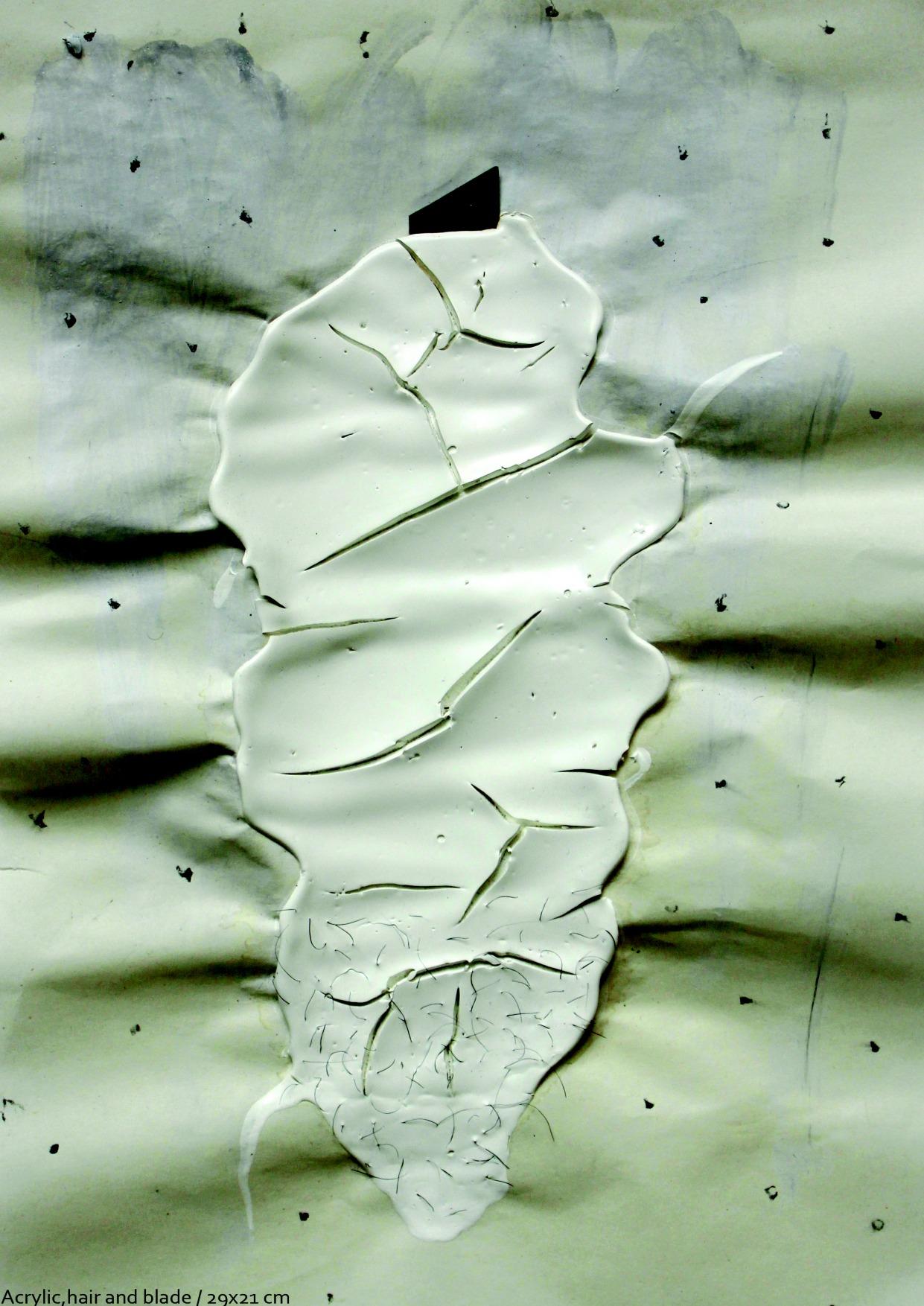
layers, there is an intense influence from the relations and judgments between the sexes. For instance, the denial of homosexual relationships and the fact that they are alienated and ignored by the society.
installations, and three-dimensional spaces, I usually begin with prior sketching and premeditation. My initial ideas and sketches are usually inspired by public spaces such as streets and stores. Moreover, I get new idea from my previous works by revisiting them, which might as well be made in other media. Then I start making the work with the materials available. In some of these works, I cast the members of my body, such as my ear, my hand, or my finger, and use them in my work. Finally, I paint parts of the sculptures and varnish them.
I have two different approaches to making my works: in my painting, collages, and drawings, I have a totally improvisational approach, with no prior sketching. The process starts with my encountering the white base of paper or canvas, then the choice of materials and the color palette selected according to my mood on a given day. My venting starts off in an expressive fashion, but then, after putting down colors and pasting some of the materials, it stops. Afterwards, I start to see the work from a distance, observing the forms in the work. I choose the forms that I find more engaging, and have a go at the work once more. This process will continue until the work is finished. This may take a day in most cases, and even less: I may make more than one work in a day. In order to make sculptures,
On a general note, I can sum up the idea behind my works as sexuality and the determinative lines between the sexes. I believe everything is consisted of spectra. Similarly, the two sexes are on the two extremes of a spectrum. It is this spectrum that makes for sexual or behavioral violence. I think these whims can appear simultaneously, because of the mixed nature of the male/female properties. So I see this subject as an observer and then begin to make my
work: without judging. For instance, when I go out on the streets, I pay close attention to humans-related issues: body language, the types of makeups and the way people dress, the way two people treat each other, and so on; as if I have just arrived in town for the first time. I always wear shades, even on cloudy days, so that I can observe my surroundings without people noticing. I try to capture every hand, look, ear, hair, foot, and sensation in my mind, so that I can use them later in my works. Thus, my main subject-matter is the society I live in: a society with total disregard of transgender people, whereas, I believe, they are the ones who can be placed exactly in the middle of the spectrum I mentioned earlier. Perhaps that is the reason why I deal with them in the main: they are extraordinarily placed on the male/female boarder.
For some artists exploring a new medium or a new technique is as important as creating an artwork. I think I am among them. It is utterly important for me to explore the capacities of each new medium to express myself. Because I believe each specific medium has a unique feature for a specific sentiment that I would like to communicate. For
instance, the presence of photography in my collages is perhaps because painting cannot express my thoughts, or I may make a volume, because I think my
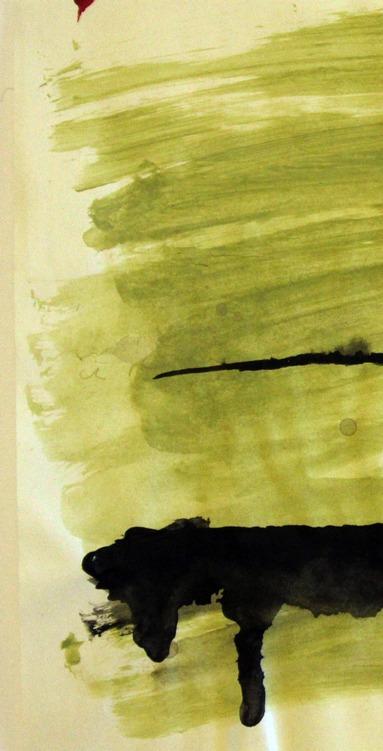
audience can better understand my thoughts when they see them in 3D and it is significant when it is tangible for them. Perhaps that is why even my
collages are embossed. To quote Aron Demetz, “I use the structure of waste materials to represent my ideas and my form in a concept.” I also think each

medium and material has a certain potential, which is sometimes limited and sometimes vast, depending on the subject-matter I am working on. For
example, natural sometimes my own hair has become a symbol of sexuality in my works. However, it is ultimately my work that decides whether I should use
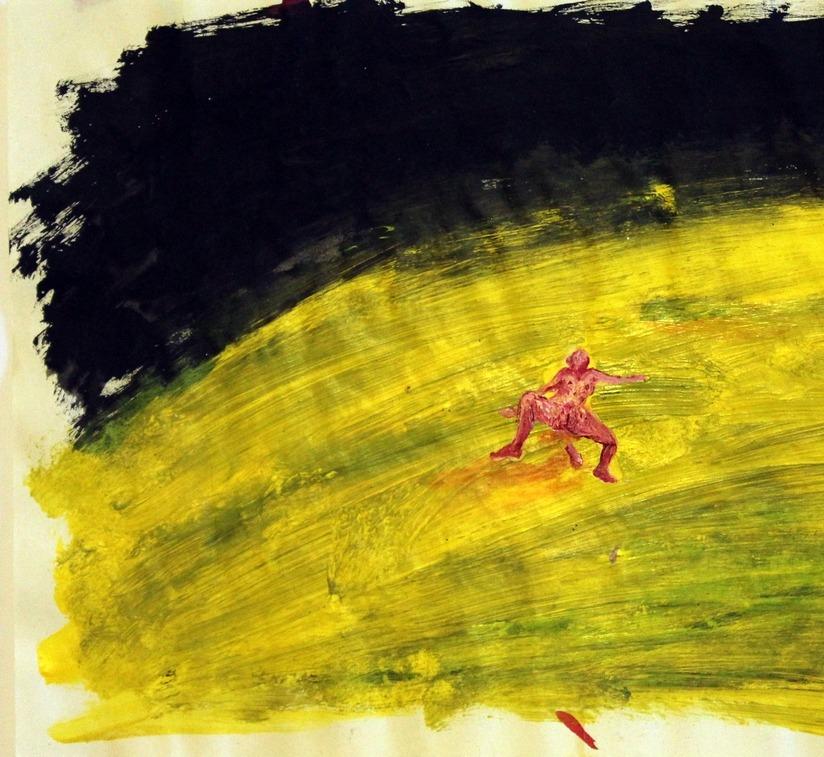
hair that is plucked out of my own body or I should paint it with a -00size brush.
I think there two different ways or channels through which everyone perceives contemporary art. First is the society they lives in and its sociopolitical system. Then there is social media. And when we talk about a norm or an issue related to humanity, it is universal to some extent, but the boundaries are not broken. For example, in my country, Iran, the last president denied the existence of homosexual people altogether, whereas in other countries they are recognized as such. As Tony Morrison has said, “All good art is political.” And I think when such things are denied in a country, it draws criticism from artists. Obviously, when artists and members of a society criticize the dogmas and beliefs of a system, it is politically loaded. An artist like me would certainly reject the system’s mentality. Social networks, such as Facebook and Instagram, in which information is distributed by people, give the members of a society the awareness, based on which they can judge the system, and understand the differences quickly and easily. This, in turn, will affect art in the contemporary era, and even the other

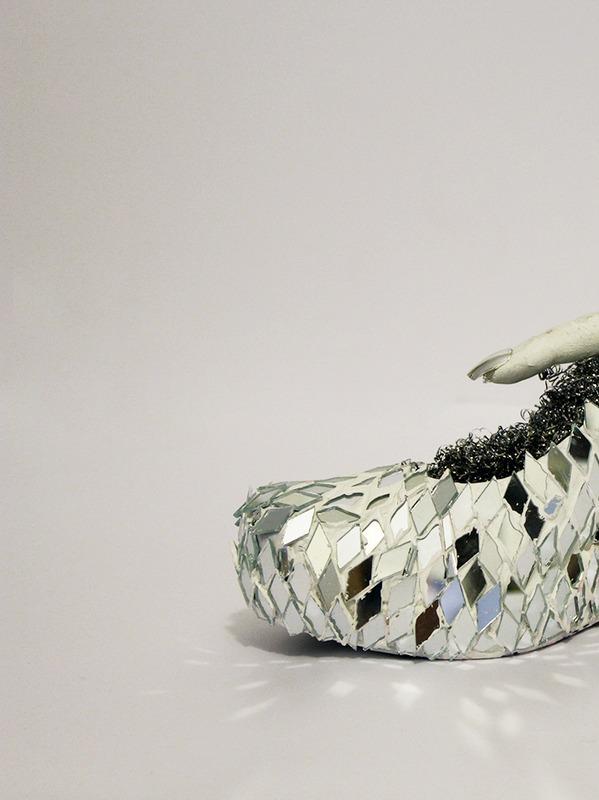
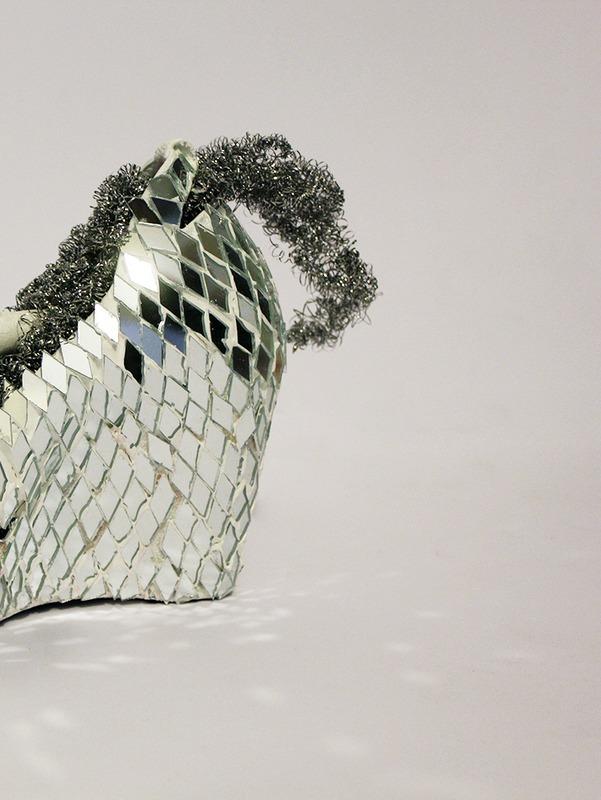
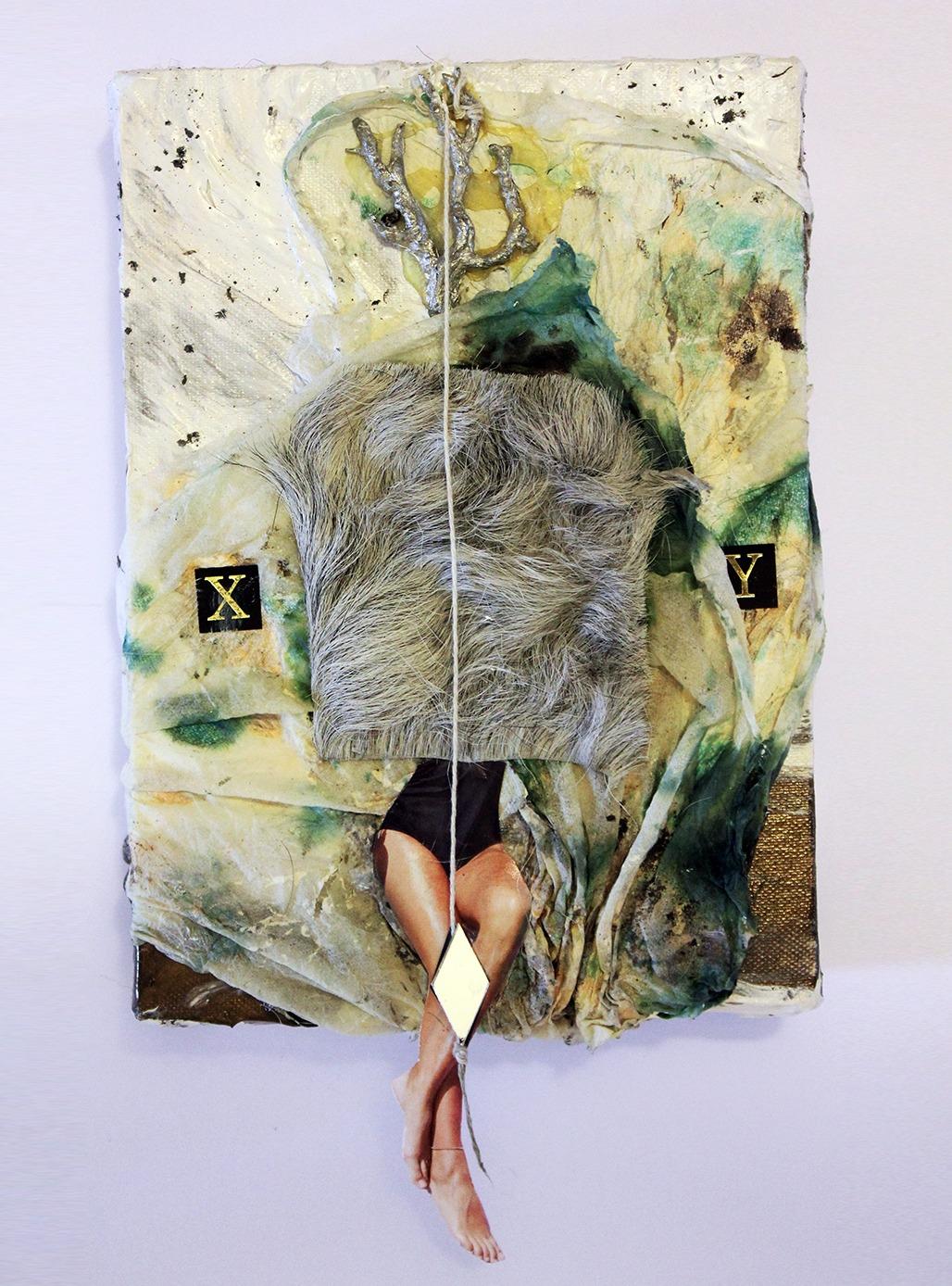
way around: art is inevitably influenced by these judgments and differences, as its role is mixed with the contemporary currents, in which images and everyday informations are abundant and influential.
directly connected to my everyday experiences; they are, rather, a deeprooted mental theme, which is nourished everyday by my senses: seeing, hearing, touching, and feeling.
Obviously, I am living in a society replete with anger and violence and sharp, annoying, and sometimes amazing contrasts. Every single day I wake up and open my eyes here, so there is no way I can look at this peculiar city with indifference and paint for mere pleasure. Painting is the very act of venting for me. It is sometimes based on my personal experiences of individual and social behaviors and acts of violence; they are sometimes very unconscious and go back to my childhood; they can also be about sexual and romantic relationships of my friends, about which I am pretty curious and I usually translate them into my works, such as in “One of My Friends Told Me Her Story.” There is another factor that plays an important role in my works: social media. When I encounter sexual subject-matters in other countries, I face a different challenge, and I enjoy working on it and I struggle with it until I can finally realize my ideas. I think even if I’d made my works outside of Iran, they would have retained the same features, for these factors are not
I think a work is not finished until it is presented. In other words, an artist’s work is done when it is put on display, outside the studio, and in front of an audience. As the work influences the viewers, they can have their different interpretations. I think sometimes the understanding of the audience of a particular work can become a part of that work, so that the sensation of the viewers about it becomes somewhat decisive for me as well as others. It can determine a judgment and an approach that I hadn’t since encountered. So, as you have mentioned, the viewer can play an important role in the contemporary world. For instance, interactive art is exactly the kind of art in which the audience contributes, and sometimes the artist may even ask the viewer to physically touch the work, or
become a part of it. Moreover, the importance of the judgment of the audience cannot be overlooked, for it is
utterly important in the direction in which that medium moves. In my own works, the viewers’ touch and their
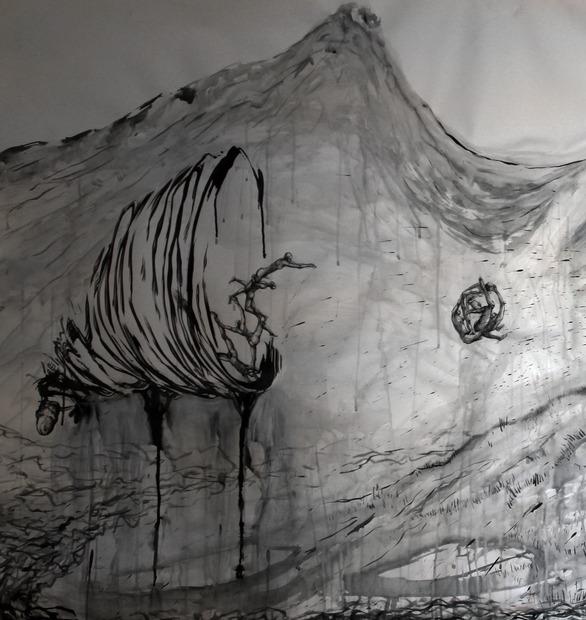
curiosity about the details are very important for me, and it really matters to me that they touch my works,
especially my collages and sculptures, so that it can be thoroughly understood.
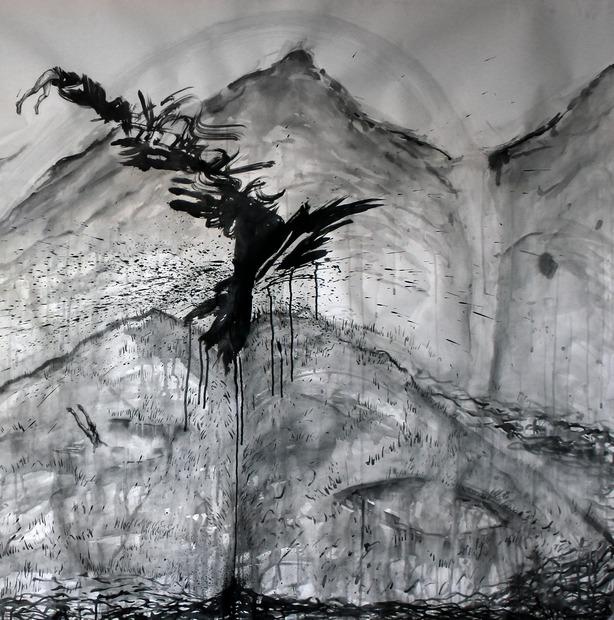
Look! As you already know, I have a BA degree in Graphic Design, but, as far as I know, the conventional meaning of colors has changed in our contemporary
art. The color palette I choose must be controlled: it is very important in communicating the concept of a given work. As you may have noticed, my favorite palette for representing orgasm, power, and figure is white, black, and body color respectively. As simple as that. Moreover, when I start to work on a painting or a collage, the colors I choose depend mainly on my mood and mindset on that particular day: depending on words, feelings, or images I have been exposed to, I select certain colors and try to match them with my concept. To


be honest with you, my mental structure unconsciously encounters the things you have mentioned, maybe because I always thirst for images and I always feed on them to be able to utilize them in my works. It might be interesting for you to know that when I start a work, I always say to myself: “Hey girl! Think about nothing!” This will liberate me from all mental restrictions and I go to the white base with an open mind. But when the work is half way through, I begin to select materials such as nails, hair, insects, fingers, and so on,
according to the concept that has been realized up to that point. To continue my work, and for its final stages, it is important that the textures, palettes, and forms exactly match my concept, so they are deliberately chosen; I use mirrors, hair, plaster, and wax, for instance.
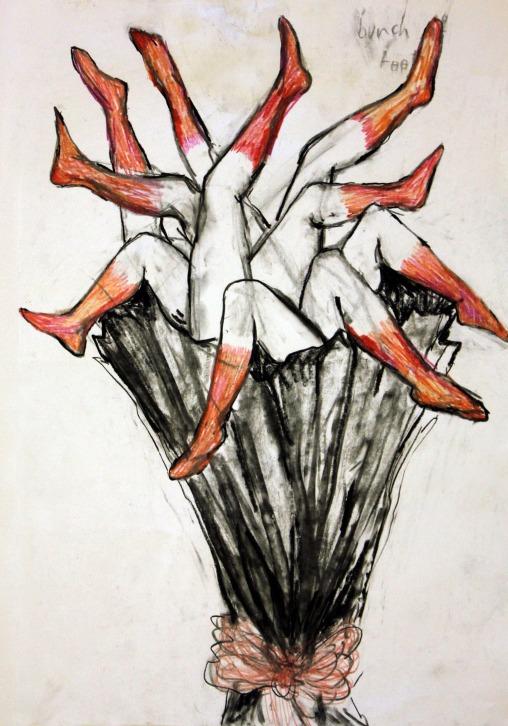
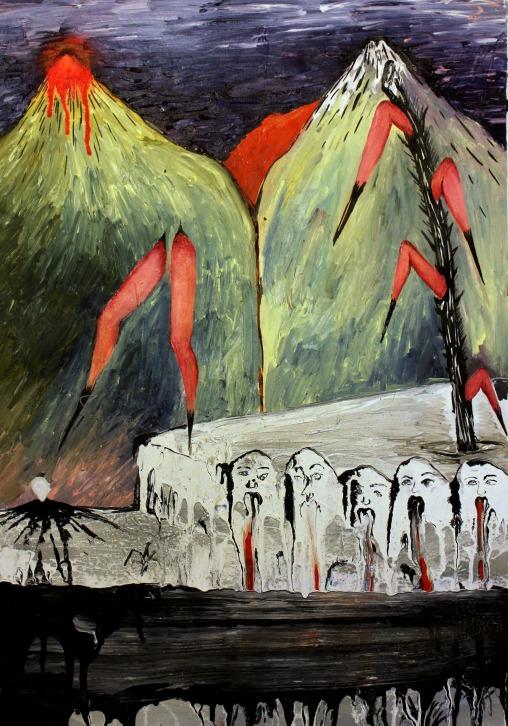
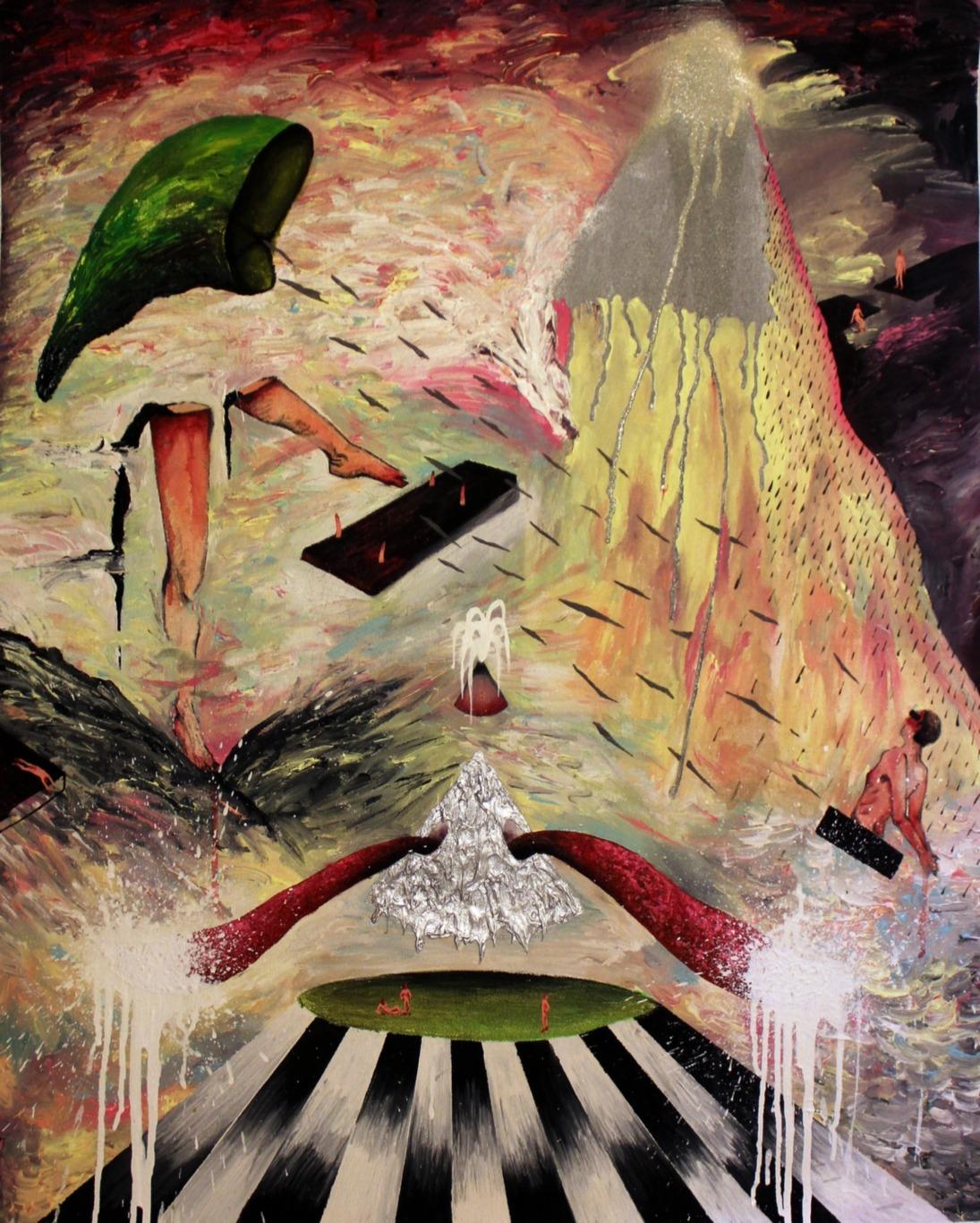
Certainly, it is crucial. However, I have always tried to know my thoughts and my visual, artistic language and attain my personal language, so that when the

audience encounter my works, they can know them and understand them better. I also know that this will take time. When I am working, I make use of the subjectmatters of my audience, people around me, and also myself. I create, and represent those ideas back to my audience: this is a never-ending cycle for me. So in the process of making my decisions, I may not directly consider my audience, but it is in fact they who are making my works.
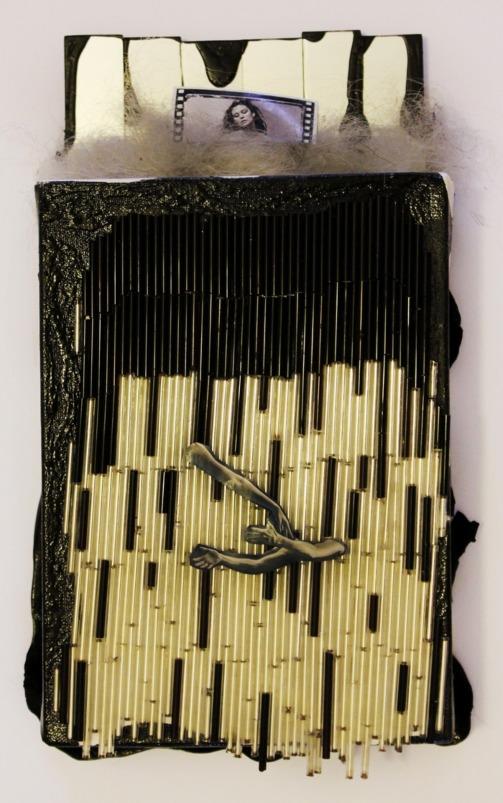
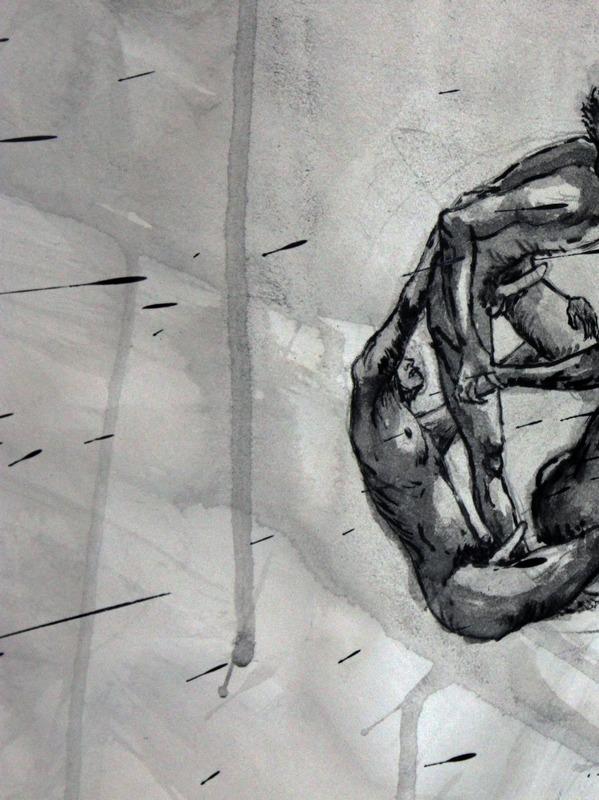


As you have figured out about my working method, I am very much interested in experimenting with different media, such as ceramic, video art, custom design, computer software, 3D, and also my photographic installations with human subject-matters and my future projects, in which I am
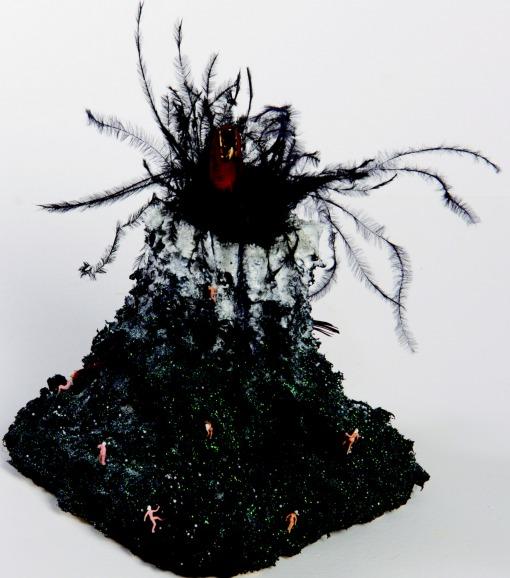
going to experiment with new media (in addition to those I already use), and I think it has a significant role in the development of my practice. My other projects include huge sculptures and installations in closed, room-like spaces, and also open spaces such as jungle and nature. What I think is important in developing my ideas is to partake in residency programs in different countries, which I believe will help my thoughts mature and I can also gain hands-on, valuable experiences.
An interview by , curator and curator


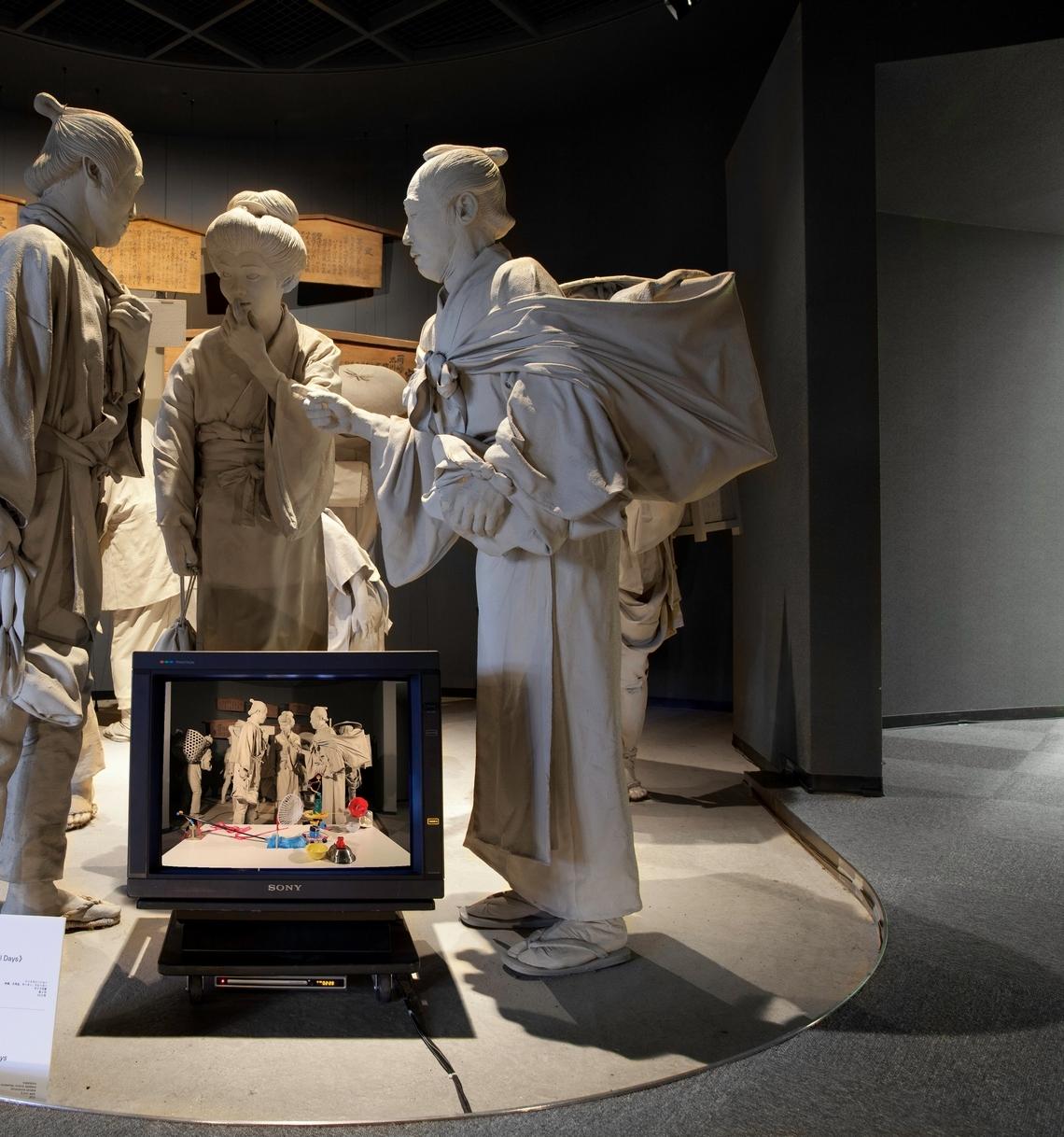
 An interview by , curator and curator
An interview by , curator and curator

When I started making works, which seem to belong in the realm of “contemporary art”, I was in the first grade of the music
department. The reason why I chose to take a step to create art projects was music is too close to my mind. I needed something to externalize my consciousness to be observed objectively or theoretically and music was too close to my subjective view. But I had a feeling of being isolated from Art world. Because I could not digest works of art at museums or produced by art students in my college whose works are dependent on their refined skill of craft or are selfsatisfied. Though a problem was that I did
Tsuyoshi Anzainot have any conventional skill to make art objects, that made clear that what I should do for making Art. The issue of the art of democracy, even which reflects my inferiority complex, has been the foundation of my projects.
The bodies of my practices are short-lived or spatial. I think the ephemerality of my kinetic sculptures has roots of Japanese tradition. Like Ikebana, the art of traditional flower arrangement or Origami, the art of paper folding, final products are not more important than process or method as an event. In U.S, I read a lot of art and philosophical theories, although I could not digest them all. That helped me to see my works critically from the perspective of the western contexts.
Though I have been considered as a multidisciplinary artist, my language of Art is very specific to several mediums which is made to copy something in the real
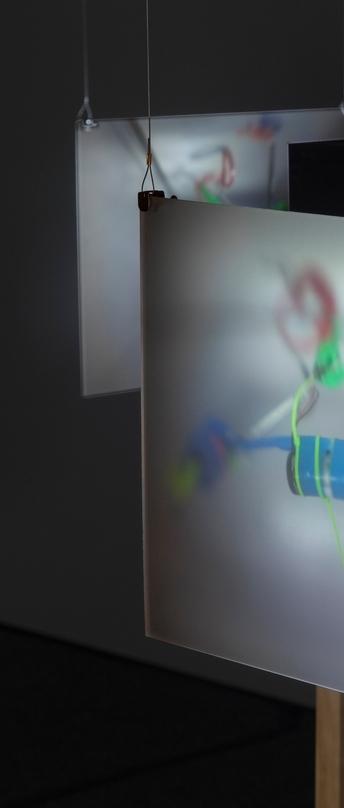
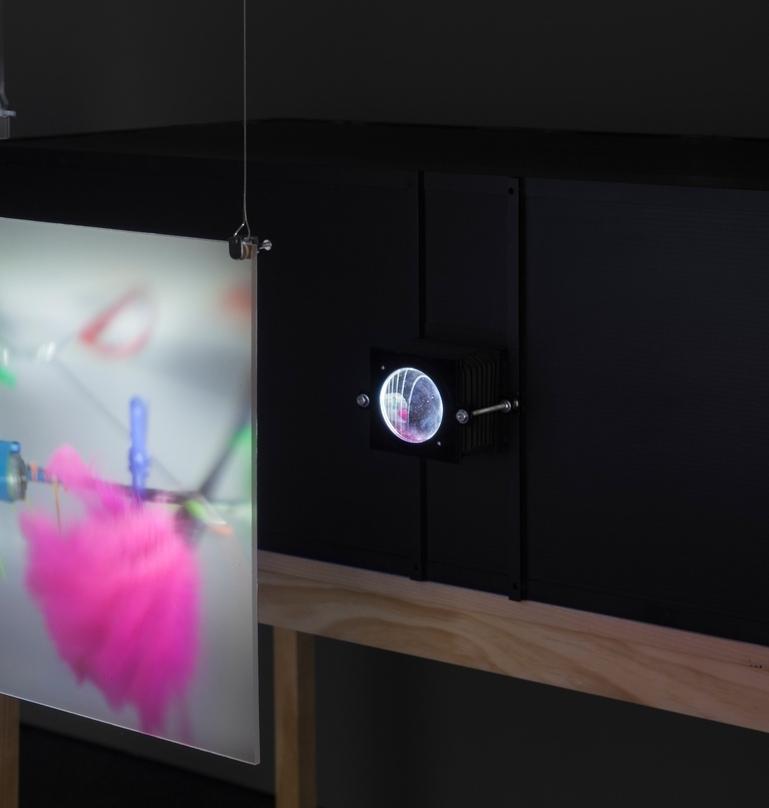

world, like a photograph, video. But from the beginning of Art history, like Plato says, Art has been the mimesis of the world of Idea. I have just expanded the issue of original and copy to another medium or slip into other critical discourses.
When I came to the United States, I was not sure what to do for the next project, one of the agenda of the kinetic sculptural project seemed to be done by the dematerialization and the participation. At that time, I encountered an analogue device at a thrift store in Houston. The function of the device is to project a magnified image on the wall and copy original image by tracing by hand. I purchased it at 5 dollars and tried to apply the device to a three-dimensional object. When I saw the projected image of three-dimensional object, fractions of the unsolved issue of my kinetic sculpture, history of video and photography and the contemporary experience of works of art are united in my brain.

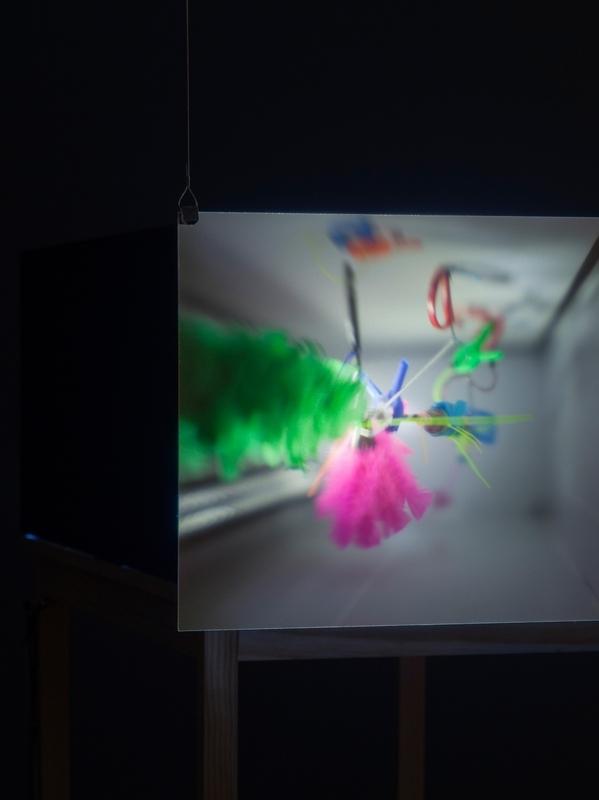
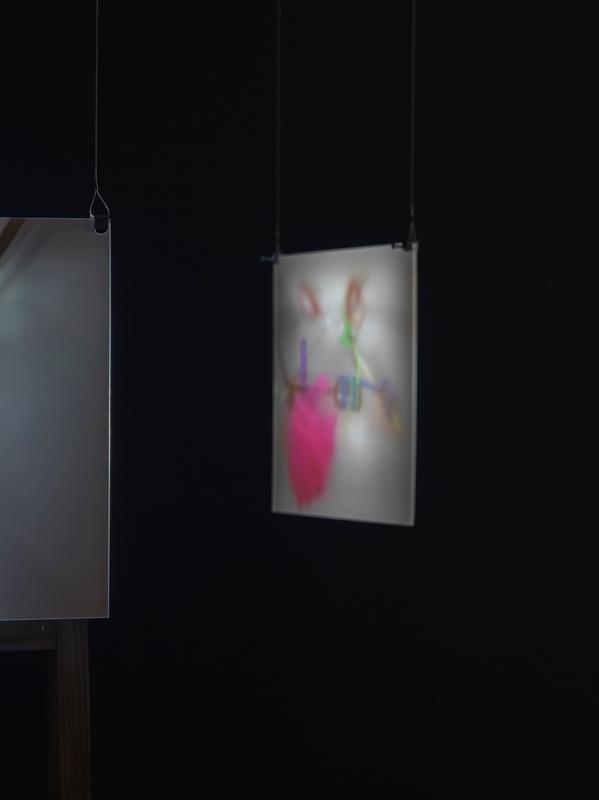
The words Art and Technology used to signify the same concept or be in a partwhole relation. As Art has changed its meaning or purpose in ages, both of them are distant. Nowadays, a work of art which is involved in the context of Art and Technology reminds me a work which uses latest technology. But Art productions are inevitable to be involved in technology, even one does not want. Because all kinds of material which is used to create works of art are industrialized, even if you make own paint by yourself, what support your life is something industrialized. In other words, we should be conscious of what is artificial or not, what is given by human or by nature.
To tell the truth, I am not sure if I have a role as an artist in this age, but I dream about how my projects will be interpreted in the remote future. Will Art be able to
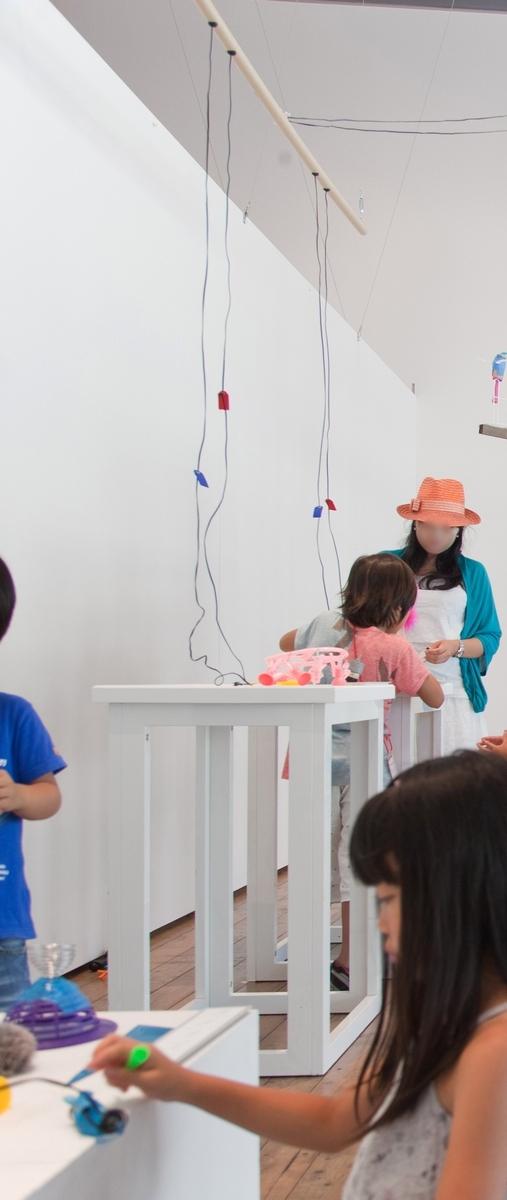
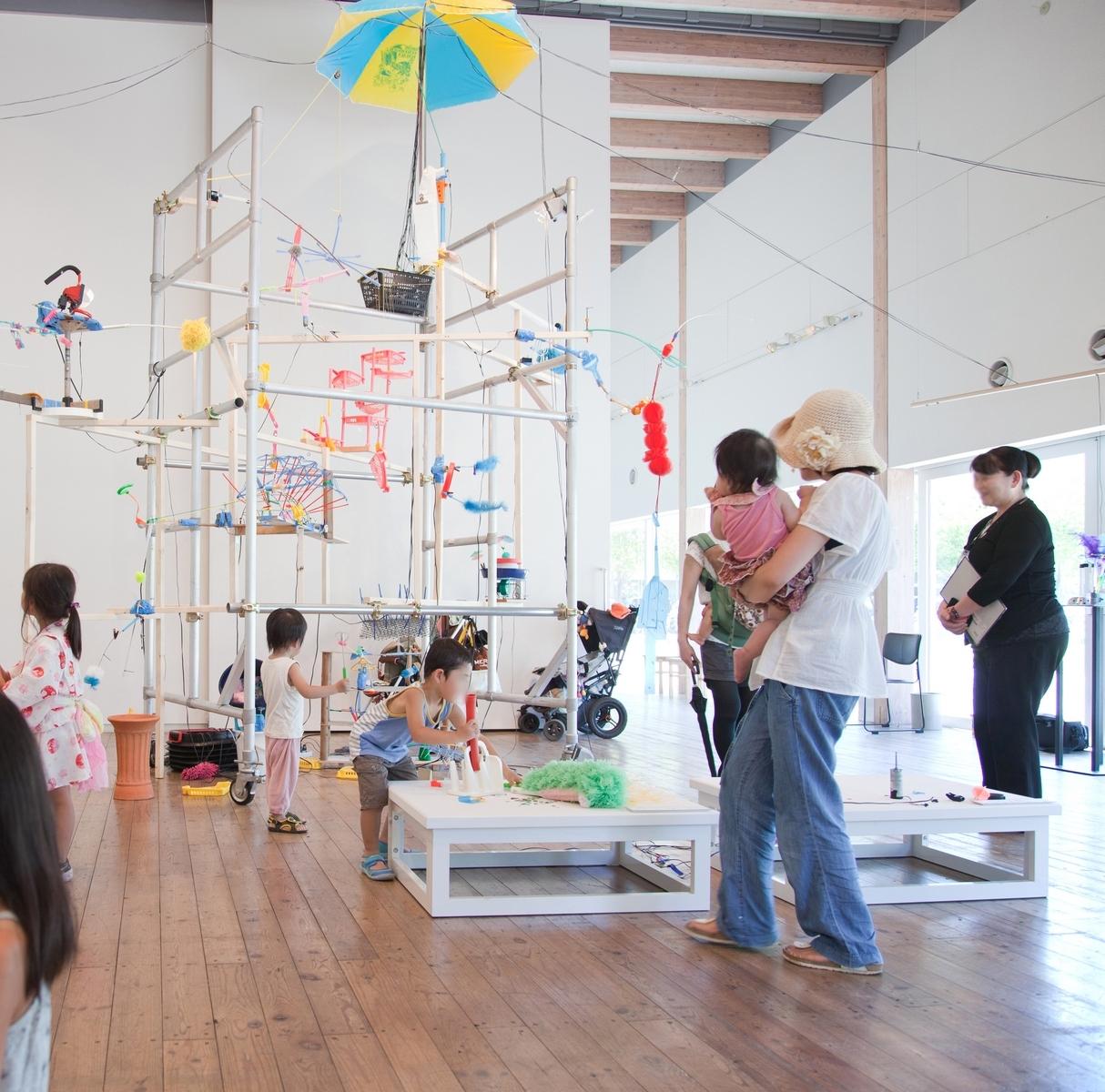

survive at that time? I think so, although I just guess human can live without Art in a way, I can hardly imagine that the world of humanity without Art which I have never experienced. I define my instructions, on how to build the kinetic sculptures, as Sculpture, in other words, the object itself is not a solitary production. That is so fun to imagine that how my instruction will be interpreted and rebuilt by using future objects by human in the age after our time.
Since a center of the work, Encounter with Doppelgänger, was interpretation itself, what I needed to do was just thinking about how to tell the structure of the work to the audience. Therefore, how people interpret objects is a part of my project. The only thing what I hope the viewer was just stopping at my work and experience it as a part of their life.


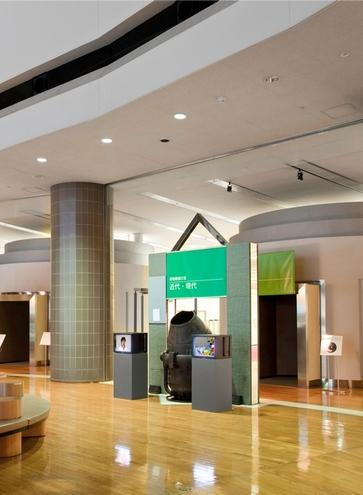
The globalization brought a variety of contexts in the discourses of Art. But
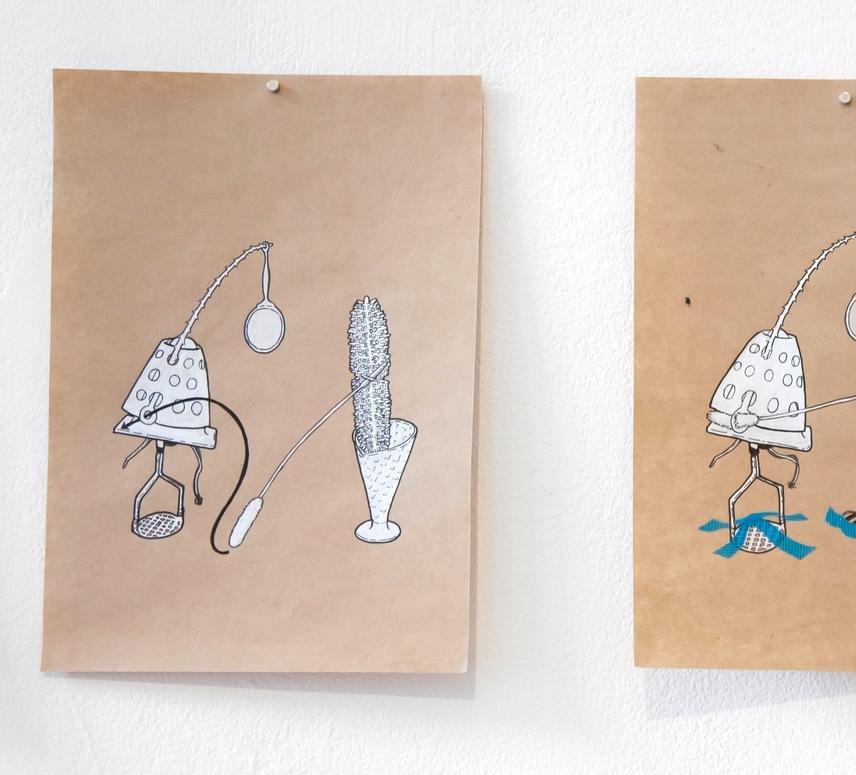
simultaneously it brought further segregation of the viewers' experience. Generally speaking, appreciation of Art requires a certain knowledge of Art history and of the contemporary issues. After the globalization, Artists have
become being able to exploit their social identity effectively, even if that is not popular (excavating or introducing unknown social context by art projects is one of the advantages or the strategy of the non-Western Artists). The experiences

of an exhibition which is composed of those works are slightly strange. I take more time to gaze at captions for each work written by curators than to observe and experience objects itself. Sometimes, I feel that I would like to take a sheet at a nice cafe place and read a catalogue of the exhibition. Of course, these discourses are very important, but I should find my way to take a balance between my social identity or unfamiliar contexts to the audience and the experiences of art objects.
One of causes of Evolution is considered as copy errors of the gene. Like that, how to place a failure in Art is really an important framework of thinking processes. Because it is the fracture between real and imagination, a material and an idea, others and one’s mind. I think those gaps are fundamental issues of Art and Philosophy. Artists should keep that all of the material is given, not stable and not consistent, in their mind.

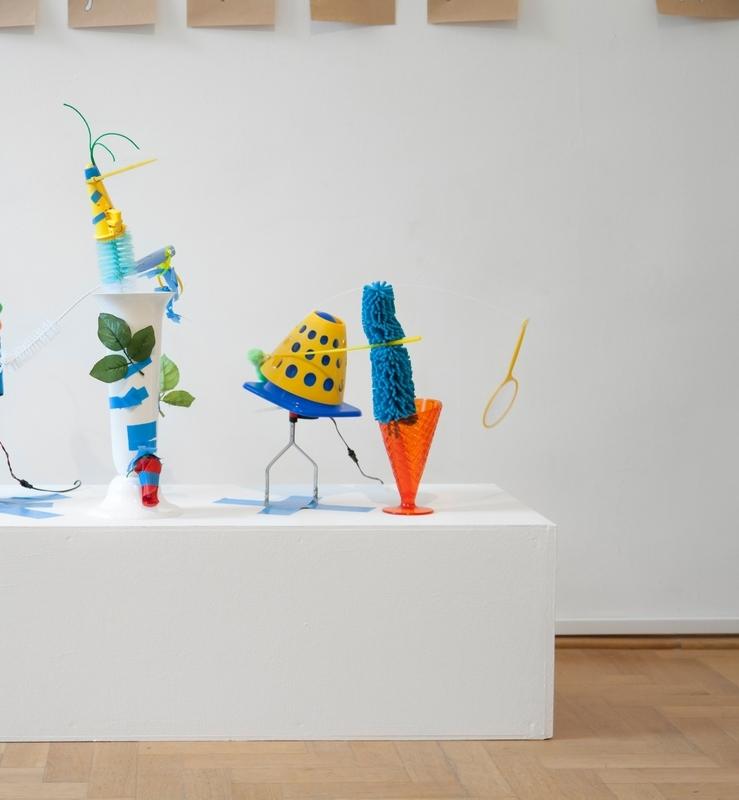
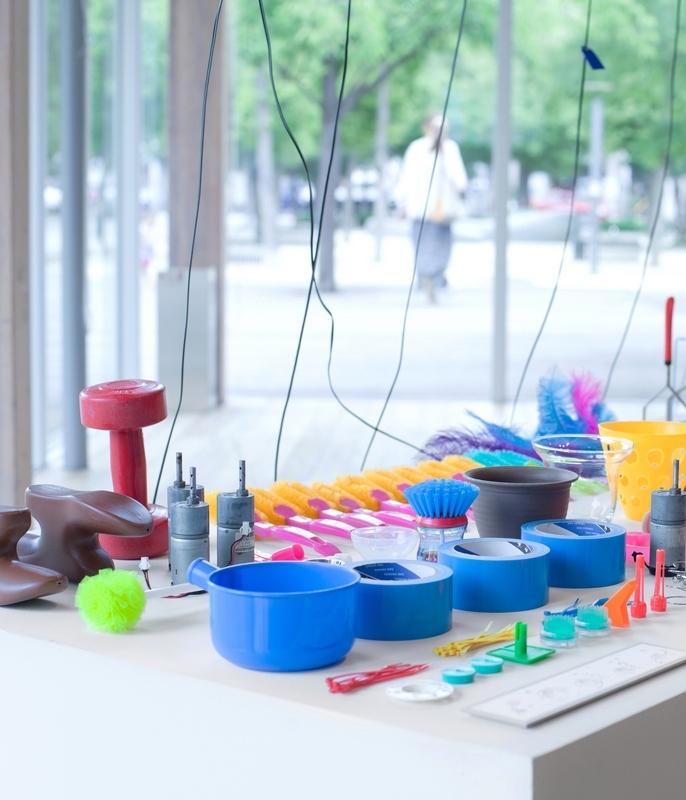
As a tactic, I set several critical layers of reception in my works of art. Even some of my audience would not be familiar to contemporary art, I am sure that they might enjoy my works. I think the most of people has experienced the core of my idea in their everyday life, that universal idea is the difference or distance between self and the real world include others. This feeling has been shown in various format: a conflict between Plato and Aristotle, science fiction film, love and romance, etc. Although this issue has never been raveled out through the history, I guess, that is what makes people driven to next steps. And of course, for me, the real external world also includes the audience.
I have become to think that I would face the global problems behind the scene of the plastic industries. That is purely ontological inquiry to me. Making works of art helps me to digest this complex situation of the world.
interview by , curator and curator


